Recognition of Sedimentary Rock Occurrences in Satellite and Aerial Images of Other Worlds—Insights from Mars
Abstract
:1. Introduction
- Learn to recognize sedimentary rock occurrences; and
- Identify where they outcrop at the planet’s (or moon’s) surface.
2. Materials and Methods
3. Results
3.1. Signs That a Geological Material Is Rock
3.1.1. Boulder and Megaclast Production
3.1.2. Retention of Steep Slopes
3.1.3. Distinct Contrast between Strata
3.1.4. Sharp Expressions of Faults, Fractures, and Joints
3.1.5. Resistance to the Impact of Saltating Sands
3.1.6. Kharafish (Wind Erosion Forms)
3.1.7. Emergence from Beneath a Body of Rock
3.2. Stratification
3.2.1. Expressions of Stratification
3.2.2. Patterns of Stratification
3.2.3. Unconformities
3.3. Tone and Color
3.3.1. Tone
3.3.2. Color
3.4. Rock Breakdown and Resistance to Erosion
3.4.1. Small Impact Crater Retention
- The total period (which can include multiple episodes of burial and exhumation) during which the surface was exposed to the atmosphere through which impactors penetrate to reach it;
- The impact cratering rate and variability of that rate—owing to changes in atmospheric density, impactor supply, and astrodynamic availability of impactors—during the period(s) of exposure;
- The formation of secondary impact craters and proximity to the primary impact site; and
- The rate and variability of the rate at which impact structures are removed by erosion, including destruction by subsequent impact events.
3.4.2. Boulder Production and Retention
3.4.3. Friability
3.4.4. Escarpments and Scarp Retreat
3.4.5. Dispersal of Liberated Clasts or Rock Fragments in the Landscape
3.4.6. Burial or Lag Protection
3.5. Depositional Setting Mimicry
3.5.1. Bedforms
3.5.2. Deltas and Alluvial Fans
3.5.3. River and Stream Sediment
- The sediment and/or channel-adjacent alluvium become cemented in the surface/near-subsurface environment and becomes a ridge when adjacent, unconsolidated or poorly-cemented alluvium is eroded away;
- The sediment is preserved beneath lava or tuff that filled the channel or valley;
- The sediment becomes lithified by deep burial diagenesis (compaction, cementation) and then returns to the surface (tectonism, erosion) and is subjected to differential erosion and exposure; or The sediment is never lithified, and coarse fluvial sediment grains (boulders, cobbles, pebbles) are left behind as an aeolian lag to protect the material from further removal.
3.5.4. Lakes and Ponds
3.5.5. Impact Crater Ejecta
3.5.6. Mass Movement Deposits
3.6. Distinction of Igneous from Sedimentary Rock
3.6.1. Remote Sensing of Composition
3.6.2. Columnar Jointing
3.6.3. Wrinkle Ridges
3.6.4. Boulder Production and Retention
3.6.5. Lobate (or Arcuate) Rock Unit Margins
3.6.6. Stratified Outcrops
3.6.7. Distinction of Tuffs
3.6.8. Importance of Context
3.7. Deformation
3.7.1. Polygonal Fracture Patterns
3.7.2. Soft Sediment Deformation
3.8. Sedimentary Rock Landforms
3.8.1. Sandstone Landforms
3.8.2. Conglomerate Landforms
3.8.3. Finestone Landforms
3.8.4. Chemical Sediment Landforms
4. Discussion
4.1. Clastic Sediment Diagenesis and Depth at which Sediment Becomes Rock
4.1.1. Perspectives on Burial Diagenesis from Gale Crater
4.1.2. Burial and the Transition of Clastic Sediment to Rock
4.1.3. Forming Clastic Sedimentary Rock with Little or no Burial
4.1.4. Martian Clastic Sedimentary Rock Formed under Conditions of Little to no Burial?
4.1.5. Clastic Sediment Diagenesis on Mars, Looking Forward
4.2. Global Distribution of Martian Sedimentary Rocks
4.2.1. Sedimentary Rocks of the Martian Heavily Cratered Terrain?
4.2.2. Sedimentary Rocks Exposed in the Walls of the Valles Marineris?
4.2.3. Sedimentary Rocks in the Medusae Fossae Formation?
4.2.4. Sedimentary Rocks Beneath the Northern Plains?
4.2.5. Additional Challenges
5. Concluding Statements
- Some Martian sedimentary rock occurrences have physical properties that permit them to resist erosion and retain small impact craters in a manner similar to lava plains;
- Tone (e.g., light-toned rocks) can be a property intrinsic to the rock, intrinsic to a coating or weathering rind, or can be a function of rock surface roughness and aeolian sediment (light-toned, dust; dark-toned, sand) accumulation on its skyward-facing surface;
- Pebble-sized clasts can be liberated from conglomerates and breccias, or produced from the breakdown of erosion-resistant, fine-grained rocks, and these pebbles can form lags that give the terrain a “smooth” appearance at image spatial resolutions of (at least) 0.25–6 m/pixel;
- Martian sedimentary rocks include examples that are dark-toned and have primary igneous rock compositions (e.g., containing glass, plagioclase, pyroxene, olivine), and remote detection of such rock compositions (e.g., basaltic) should not automatically be interpreted as tuffs or lavas; and
- Distinction of sedimentary from igneous rock is not always easy, even when viewed by landed payload cameras at sub-millimeter scales; for cases in which making the distinction is not possible, it is important to acknowledge the observational reason(s) as to why.
Author Contributions
Funding
Data Availability Statement
Acknowledgments
Conflicts of Interest
References
- Wood, L.J. Quantitative geomorphology of the Mars Eberswalde delta. Geol. Soc. Am. Bull. 2006, 118, 557–566. [Google Scholar] [CrossRef]
- Dromart, G.; Quantin, C.; Broucke, O. Stratigraphic architectures spotted in southern Melas Chasma, Valles Marineris, Mars. Geology 2007, 35, 363–366. [Google Scholar] [CrossRef]
- Okubo, C.H.; Lewis, K.W.; McEwen, A.S.; Kirk, R.L. Relative age of interior layered deposits in southwest Candor Chasma based on high-resolution structural mapping. J. Geophys. Res. Planets 2008, 113, E12002:1–E12002:15. [Google Scholar] [CrossRef] [Green Version]
- Fueten, F.; Stesky, R.; MacKinnon, P.; Hauber, E.; Zegers, T.; Gwinner, K.; Scholten, F.; Neukum, G. Stratigraphy and structure of interior layered deposits in west Candor Chasma, Mars, from High Resolution Stereo Camera (HRSC) stereo imagery and derived elevations. J. Geophys. Res. Planets 2008, 113, E10008:1–E10008:19. [Google Scholar] [CrossRef] [Green Version]
- Metz, J.M.; Grotzinger, J.P.; Mohrig, D.; Milliken, R.; Prather, B.; Pirmez, C.; McEwen, A.S.; Weitz, C.M. Sublacustrine depositional fans in southwest Melas Chasma. J. Geophys. Res. Planets 2009, 114, E10002:1–E10002:17. [Google Scholar] [CrossRef] [Green Version]
- Murchie, S.; Roach, L.; Seelos, F.; Milliken, R.; Mustard, J.; Arvidson, R.; Wiseman, S.; Lichtenberg, K.; Andrews-Hanna, J.; Bishop, J.; et al. Evidence for the origin of layered deposits in Candor Chasma, Mars, from mineral composition and hydrologic modeling. J. Geophys. Res. Planets 2009, 114, E00D05:1–E00D05:15. [Google Scholar] [CrossRef]
- Okubo, C.H.; Schultz, R.A.; Chan, M.A.; Komatsu, G.; HiRISE Team. Deformation band clusters on Mars and implications for subsurface fluid flow. Geol. Soc. Am. Bull. 2009, 121, 474–482. [Google Scholar] [CrossRef]
- Okubo, C.H. Structural geology of Amazonian-aged layered sedimentary deposits in southwest Candor Chasma, Mars. Icarus 2010, 207, 210–225. [Google Scholar] [CrossRef]
- Loizeau, D.; Mangold, N.; Poulet, F.; Ansan, V.; Hauber, E.; Bibring, J.-P.; Gondet, B.; Langevin, Y.; Masson, P.; Neukum, G. Stratigraphy in the Mawrth Vallis region through OMEGA, HRSC color imagery and DTM. Icarus 2010, 205, 396–418. [Google Scholar] [CrossRef] [Green Version]
- Sowe, M.; Jaumann, R.; Neukum, G. A comparative study of interior layered deposits on Mars. In Martian Geomorphology; Balme, M.R., Bargery, A.S., Gallagher, C.J., Gupta, S., Eds.; Geological Society of London Publications: London, UK, 2011; Volume 356, pp. 281–300. [Google Scholar] [CrossRef] [Green Version]
- Ansan, V.; Loizeau, D.; Mangold, N.; Le Mouélic, S.; Carter, J.; Poulet, F.; Dromart, G.; Lucas, A.; Bibring, J.-P.; Gendrin, A.; et al. Stratigraphy, mineralogy, and origin of layered deposits inside Terby crater, Mars. Icarus 2011, 211, 273–304. [Google Scholar] [CrossRef]
- Zabrusky, K.; Andrews-Hanna, J.C.; Wiseman, S.M. Reconstructing the distribution and depositional history of the sedimentary deposits of Arabia Terra, Mars. Icarus 2012, 220, 311–330. [Google Scholar] [CrossRef]
- DiBiase, R.A.; Limaye, A.B.; Scheingross, J.S.; Fischer, W.W.; Lamb, M.P. Deltaic deposits at Aeolis Dorsa: Sedimentary evidence for a standing body of water on the northern plains of Mars. J. Geophys. Res. Planets 2013, 118, 1284–1302. [Google Scholar] [CrossRef] [Green Version]
- Stack, K.M.; Grotzinger, J.P.; Milliken, R.E. Bed thickness distributions on Mars: An orbital perspective. J. Geophys. Res. Planets 2013, 118, 1323–1349. [Google Scholar] [CrossRef] [Green Version]
- Rice, M.S.; Bell, J.F., III; Gupta, S.; Warner, N.H.; Goddard, K.; Anderson, R.B. A detailed geologic characterization of Eberswalde crater, Mars. Mars 2013, 8, 15–57. Available online: https://www.marsjournal.org/contents/2013/0002/ (accessed on 26 September 2021).
- Lewis, K.W.; Aharonson, O. Occurrence and origin of rhythmic sedimentary rocks on Mars. J. Geophys. Res. Planets 2014, 119, 1432–1457. [Google Scholar] [CrossRef]
- Cadieux, S.B.; Kah, L.C. To what extent can intracrater layered deposits that lack clear sedimentary textures be used to infer depositional environments? Icarus 2015, 248, 526–538. [Google Scholar] [CrossRef]
- Pondrelli, M.; Rossi, A.P.; Le Deit, L.; Fueten, F.; van Gasselt, S.; Glamoclija, M.; Cavalazzi, B.; Hauber, E.; Franchi, F.; Pozzobon, R. Equatorial layered deposits in Arabia Terra, Mars: Facies and process variability. Geol. Soc. Am. Bull. 2015, 127, 1064–1089. [Google Scholar] [CrossRef] [Green Version]
- Kite, E.S.; Howard, A.D.; Lucas, A.S.; Armstrong, J.C.; Aharonson, O.; Lamb, M.P. Stratigraphy of Aeolis Dorsa, Mars: Stratigraphic context of the great river deposits. Icarus 2015, 253, 223–242. [Google Scholar] [CrossRef]
- Fraeman, A.A.; Ehlmann, B.L.; Arvidson, R.E.; Edwards, C.S.; Grotzinger, J.P.; Milliken, R.E.; Quinn, D.P.; Rice, M.S. The stratigraphy and evolution of lower Mount Sharp from spectral, morphological, and thermophysical orbital data sets. J. Geophys. Res. Planets 2016, 121, 1713–1736. [Google Scholar] [CrossRef]
- Stack, K.M.; Edwards, C.S.; Grotzinger, J.P.; Gupta, S.; Sumner, D.Y.; Calef, F.J., III; Edgar, L.A.; Edgett, K.S.; Fraeman, A.A.; Jacob, S.R.; et al. Comparing orbiter and rover image-based mapping of an ancient sedimentary environment, Aeolis Palus, Gale crater, Mars. Icarus 2016, 280, 3–21. [Google Scholar] [CrossRef] [Green Version]
- Anderson, R.B.; Edgar, L.A.; Rubin, D.M.; Lewis, K.W.; Newman, C. Complex bedding geometry in the upper portion of Aeolis Mons, Gale crater, Mars. Icarus 2018, 314, 246–264. [Google Scholar] [CrossRef]
- Irwin, R.P., III; Wray, J.J.; Mest, S.C.; Maxwell, T.A. Wind-eroded crater floors and intercrater plains, Terra Sabaea, Mars. J. Geophys. Res. Planets 2018, 123, 445–467. [Google Scholar] [CrossRef]
- Sarkar, R.; Edgett, K.S.; Singh, P.; Porwal, A. The light-toned stratified sedimentary rock exposures in western Juventae Chasma, Mars, in context. Icarus 2018, 312, 7–35. [Google Scholar] [CrossRef]
- Sarkar, R.; Edgett, K.S.; Ghosh, D.; Porwal, A.; Singh, P. Tectonic evolution of Juventae Chasma, Mars, and the deformational and depositional structural attributes of the four major light-toned rock exposures therein. Icarus 2019, 333, 199–233. [Google Scholar] [CrossRef]
- Davis, J.M.; Gupta, S.; Balme, M.; Grindrod, P.M.; Fawdon, P.; Dickeson, Z.I.; Williams, R.M.E. A diverse array of fluvial depositional systems in Arabia Terra: Evidence for mid-Noachian to early Hesperian rivers on Mars. J. Geophys. Res. Planets 2019, 124, 1913–1934. [Google Scholar] [CrossRef] [PubMed]
- Day, M.; Edgett, K.S.; Stumbaugh, D. Ancient stratigraphy preserving a wet-to-dry, fluvio-lacustrine to aeolian transition near Barth crater, Arabia Terra, Mars. J. Geophys. Res. Planets 2019, 124, 3402–3421. [Google Scholar] [CrossRef]
- Annex, A.M.; Lewis, K.W. Regional correlations in the layered deposits of Arabia Terra, Mars. J. Geophys. Res. Planets 2020, 125, e2019JE006188:1–e2019JE006188:14. [Google Scholar] [CrossRef]
- Horgan, B.H.N.; Anderson, R.B.; Dromart, G.; Amador, E.S.; Rice, M.S. The mineral diversity of Jezero crater: Evidence for possible lacustrine carbonates on Mars. Icarus 2020, 339, 113526:1–113526:34. [Google Scholar] [CrossRef]
- Day, M.D.; Catling, D.C. Potential aeolian deposition of intra-crater layering: A case study of Henry crater, Mars. Geol. Soc. Am. Bull. 2020, 132, 608–616. [Google Scholar] [CrossRef]
- Stack, K.M.; Williams, N.R.; Calef, F., III; Sun, V.Z.; Williford, K.H.; Farley, K.A.; Eide, S.; Flannery, D.; Hughes, C.; Jacob, S.R.; et al. Photogeologic map of the Perseverance rover field site in Jezero crater constructed by the Mars 2020 Science Team. Space Sci. Rev. 2020, 216, 127:1–127:47. [Google Scholar] [CrossRef]
- Quantin-Nataf, C.; Carter, J.; Mandon, L.; Thollot, P.; Balme, M.; Volat, M.; Pan, L.; Loizeau, D.; Millot, C.; Breton, S.; et al. Oxia Planum: The landing site for the ExoMars “Rosalind Franklin” rover mission: Geological context and prelanding interpretation. Astrobiology 2021, 21, 345–366. [Google Scholar] [CrossRef] [PubMed]
- Florensky, C.P.; Basilevsky, A.T.; Kryuchkof, V.P.; Kusmin, R.O.; Nikolaeva, O.V.; Pronin, A.A.; Chernaya, I.M.; Tyuflin, Y.S.; Selivanonv, A.S.; Naraeva, M.K.; et al. Venera 13 and Venera 14: Sedimentary rocks on Venus? Science 1983, 221, 57–59. [Google Scholar] [CrossRef] [PubMed]
- Way, M.J.; Del Genio, A.D.; Kiang, N.Y.; Sohl, L.E.; Grinspoon, D.H.; Aleinov, I.; Kelley, M.; Clune, T. Was Venus the first habitable world of our solar system? Geophys. Res. Lett. 2016, 43, 8376–8383. [Google Scholar] [CrossRef]
- Byrne, P.K.; Ghail, R.C.; Gilmore, M.S.; Celâl Şengör, A.M.; Klimczak, C.; Senske, D.A.; Whitten, J.L.; Khawja, S.; Ernst, R.E.; Solomon, S.C. Venus tesserae feature layered, folded, and eroded rocks. Geology 2020, 49, 81–85. [Google Scholar] [CrossRef]
- Garvin, J.; Arney, G.; Getty, S.; Johnson, N.; Kiefer, W.; Lorenz, R.; Ravine, M.; Malespin, C.; Webster, C.; Campbell, B.; et al. DAVINCI+: Deep Atmosphere of Venus Investigation of Noble gases, Chemistry & Imaging, plus. In Proceedings of the 51st Lunar and Planetary Science Conference, (Cancelled Meeting; COVID-19 Pandemic), Houston, TX, USA, 16–20 March 2020; Abstract Number 2599. Lunar and Planetary Institute: Houston, TX, USA, 2020. Available online: https://www.hou.usra.edu/meetings/lpsc2020/pdf/2599.pdf (accessed on 26 September 2021).
- Lunine, J.I.; Lorenz, R.D. Rivers, lakes, dunes, and rain: Crustal processes in Titan’s methane cycle. Annu. Rev. Earth Planet. Sci. 2009, 37, 299–320. [Google Scholar] [CrossRef] [Green Version]
- Barnes, J.W.; Lorenz, R.D.; Radebaugh, J.; Hayes, A.G.; Arnold, K.; Chandler, C. Production and global transport of Titan’s sand particles. Planet. Sci. 2015, 4, 1:1–1:19. [Google Scholar] [CrossRef] [Green Version]
- Hayes, A.G. The lakes and seas of Titan. Annu. Rev. Earth Planet. Sci. 2016, 44, 57–83. [Google Scholar] [CrossRef]
- Radebaugh, J.; Ventra, D.; Lorenz, R.D.; Farr, T.; Kirk, R.; Hayes, A.; Malaska, M.J.; Birch, S.; Liu, Z.Y.-C.; Lunine, J.; et al. Alluvial and fluvial fans on Saturn’s moon Titan reveal processes, materials and regional geology. In Geology and Geomorphology of Alluvial and Fluvial Fans: Terrestrial and Planetary Perspectives; Ventra, D., Clarke, L.E., Eds.; Geological Society Publication: London, UK, 2018; Volume 440, pp. 281–305. [Google Scholar] [CrossRef]
- Barnes, J.W.; Turtle, E.P.; Trainer, M.G.; Lorenz, R.D.; MacKenzie, S.M.; Brinckerhoff, W.B.; Cable, M.L.; Ernst, C.M.; Freissinet, C.; Hand, K.P.; et al. Science goals and objectives for the Dragonfly Titan rotorcraft relocatable lander. Planet. Sci. J. 2021, 2, 130:1–130:18. [Google Scholar] [CrossRef]
- Loomis, A.A. Some geologic problems of Mars. Geol. Soc. Am. Bull. 1965, 76, 1083–1104. [Google Scholar] [CrossRef]
- McKay, C.P.; Nedell, S.S. Are there carbonate deposits in the Valles Marineris, Mars? Icarus 1988, 73, 142–148. [Google Scholar] [CrossRef] [Green Version]
- Tanaka, T. Examination of Martian sedimentary rocks to understand possible paleo-ocean and its age. In Workshop on Mars Sample Return Science; Lunar and Planetary Institute Technical Report 88-07; Drake, M.J., Greeley, R., McKay, G.A., Blanchard, D.P., Carr, M.H., Gooding, J., McKay, C.P., Spudis, P.D., Squyres, S.W., Eds.; Lunar and Planetary Institute: Houston, TX, USA, 1988; p. 166. Available online: https://hdl.handle.net/20.500.11753/940 (accessed on 26 September 2021).
- Markun, C.D. Martian sediments and sedimentary rocks. In Workshop on Mars Sample Return Science; Lunar and Planetary Institute Technical Report 88-07; Drake, M.J., Greeley, R., McKay, G.A., Blanchard, D.P., Carr, M.H., Gooding, J., McKay, C.P., Spudis, P.D., Squyres, S.W., Eds.; Lunar and Planetary Institute: Houston, TX, USA, 1988; pp. 117–118. Available online: https://hdl.handle.net/20.500.11753/940 (accessed on 26 September 2021).
- Ashley, G.M.; Delaney, J.S. If a meteorite of Martian sandstone hit you on the head would you recognize it? In Proceedings of the 30th Lunar and Planetary Science Conference, Houston, TX, USA, 15–19 March 1999; Abstract Number 1273. Lunar and Planetary Institute: Houston, TX, USA, 1999. Available online: https://hdl.handle.net/20.500.11753/1081 (accessed on 26 September 2021).
- Lewis, A.S. The sedimentology of Mars: A review. Vistas Astron. 1984, 27, 25–53. [Google Scholar] [CrossRef]
- Grotzinger, J.P.; Milliken, R.E. The sedimentary rock record of Mars: Distribution, origins, and global stratigraphy. In Sedimentary Geology of Mars; Grotzinger, J.P., Milliken, R.E., Eds.; SEPM: Tulsa, OK, USA, 2012; Volume 102, pp. 1–48. ISBN 978-156-576-313-5. [Google Scholar] [CrossRef] [Green Version]
- Malin, M.C.; Edgett, K.S. Sedimentary rocks of early Mars. Science 2000, 290, 1927–1937. [Google Scholar] [CrossRef]
- Malin, M.C.; Edgett, K.S.; Cantor, B.A.; Caplinger, M.A.; Danielson, G.E.; Jensen, E.H.; Ravine, M.A.; Sandoval, J.L.; Supulver, K.D. An overview of the 1985–2006 Mars Orbiter Camera science investigation. Mars 2010, 5, 1–60. [Google Scholar] [CrossRef]
- Edgett, K.S.; Malin, M.C. New views of Mars eolian activity, materials, and surface properties: Three vignettes from the Mars Global Surveyor Mars Orbiter Camera. J. Geophys. Res. Planets 2000, 105, 1623–1650. [Google Scholar] [CrossRef]
- Edgett, K.S.; Malin, M.C. Examples of Martian sandstone: Indurated, lithified, and cratered dunes in MGS MOC images. In Proceedings of the 31st Lunar and Planetary Science Conference, Houston, TX, USA, 13–17 March 2000; Abstract Number 1071. Lunar and Planetary Institute: Houston, TX, USA, 2000. Available online: https://hdl.handle.net/20.500.11753/1082 (accessed on 26 September 2021).
- Malin, M.C.; Edgett, K.S. Evidence for persistent flow and aqueous sedimentation on early Mars. Science 2003, 302, 1931–1934. [Google Scholar] [CrossRef] [Green Version]
- Rover Team. Characterization of the Martian surface deposits by the Mars Pathfinder rover, Sojourner. Science 1997, 278, 1765–1768. [Google Scholar] [CrossRef] [Green Version]
- Basilevsky, A.T.; Markiewicz, W.J.; Thomas, N.; Keller, H.U. Morphologies within and near the Rock Garden at the Mars Pathfinder landing site. J. Geophys. Res. Planets 1999, 104, 8617–8636. [Google Scholar] [CrossRef] [Green Version]
- Squyres, S.W.; Arvidson, R.E.; Bell, J.F., III; Brückner, J.; Cabrol, N.A.; Calvin, W.; Carr, M.H.; Christensen, P.R.; Clark, B.C.; Crumpler, L.; et al. The Opportunity rover’s Athena science investigation at Meridiani Planum, Mars. Science 2004, 306, 1698–1703. [Google Scholar] [CrossRef] [Green Version]
- Grotzinger, J.P.; Arvidson, R.E.; Bell, J.F., III; Calvin, W.; Clark, B.C.; Fike, D.A.; Golombek, M.; Greeley, R.; Haldemann, A.; Herkenhoff, K.E.; et al. Stratigraphy and sedimentology of a dry to wet eolian depositional system, Burns formation, Meridiani Planum, Mars. Earth Planet. Sci. Lett. 2005, 240, 11–72. [Google Scholar] [CrossRef]
- Metz, J.M.; Grotzinger, J.P.; Rubin, D.M.; Lewis, K.W.; Squyres, S.W.; Bell, J.F., III. Sulfate-rich eolian and wet interdune deposits, Erebus crater, Meridiani Planum, Mars. J. Sediment. Res. 2009, 79, 247–264. [Google Scholar] [CrossRef] [Green Version]
- Stern, R.J.; Gerya, T.; Tackley, P.J. Stagnant lid tectonics: Perspectives from silicate planets, dwarf planets, large moons, and large asteroids. Geosci. Front. 2018, 9, 103–119. [Google Scholar] [CrossRef]
- Grotzinger, J.; Beaty, D.; Dromart, G.; Griffes, J.; Gupta, S.; Harris, P.; Hurowitz, J.; Kocurek, G.; McLennan, S.; Milliken, R.; et al. The sedimentary record of Mars. Sediment. Rec. 2011, 9, 4–8. [Google Scholar] [CrossRef]
- Edgett, K.S.; Banham, S.G.; Bennett, K.A.; Edgar, L.A.; Edwards, C.S.; Fairén, A.G.; Fedo, C.M.; Fey, D.M.; Garvin, J.B.; Grotzinger, J.P.; et al. Extraformational sediment recycling on Mars. Geosphere 2020, 16, 1508–1537. [Google Scholar] [CrossRef] [PubMed]
- Condie, K.C. Earth’s oldest rocks and minerals. In Earth’s Oldest Rocks; Van Kranendonk, M.J., Bennett, V., Hoffmann, J.E., Eds.; Elsevier: Amsterdam, The Netherlands, 2019; pp. 239–253. ISBN 978-044-463-901-1. [Google Scholar] [CrossRef]
- Harrison, T.M. Hadean Earth; Springer Nature: Cham, Switzerland, 2020; ISBN 978-303-046-687-9. [Google Scholar] [CrossRef]
- Arney, G.; Domagal-Goldman, S.D.; Meadows, V.S.; Wolf, E.T.; Schwieterman, E.; Charnay, B.; Claire, M.; Hébrard, E.; Trainer, M.G. The pale orange dot: The spectrum and habitability of hazy Archean Earth. Astrobiology 2016, 16, 873–899. [Google Scholar] [CrossRef] [Green Version]
- Hesselbrock, A.J.; Minton, D.A. An ongoing satellite–ring cycle of Mars and the origins of Phobos and Deimos. Nat. Geosci. 2017, 10, 266–269. [Google Scholar] [CrossRef]
- Spalding, C.; Fischer, W.W.; Laughlin, G. An orbital window into the ancient sun’s mass. Astrophys. J. Lett. 2018, 689, L19:1–L19:6. [Google Scholar] [CrossRef] [Green Version]
- Sullivan, R.; Banfield, D.; Bell, J.F., III; Calvin, W.; Fike, D.; Golombek, M.; Greeley, R.; Grotzinger, J.; Herkenhoff, K.; Jerolmack, D.; et al. Aeolian processes at the Mars Exploration Rover Meridiani Planum landing site. Nature 2005, 436, 58–61. [Google Scholar] [CrossRef] [Green Version]
- Fergason, R.L.; Christensen, P.R. Formation and erosion of layered materials: Geologic and dust cycle history of eastern Arabia Terra, Mars. J. Geophys. Res. Planets 2008, 113, E12001:1–E12001:22. [Google Scholar] [CrossRef]
- Beyer, R.A.; Stack, K.M.; Griffes, J.L.; Milliken, R.E.; Herkenhoff, K.E.; Byrne, S.; Holt, J.W.; Grotzinger, J.P. An atlas of Mars sedimentary rocks as seen by HIRISE. In Sedimentary Geology of Mars; Grotzinger, J.P., Milliken, R.E., Eds.; SEPM: Tulsa, OK, USA, 2012; Volume 102, pp. 49–95. ISBN 978-156-576-313-5. [Google Scholar] [CrossRef] [Green Version]
- Treiman, A.H.; Bish, D.L.; Vaniman, D.T.; Chipera, S.J.; Blake, D.F.; Ming, D.W.; Morris, R.V.; Bristow, T.F.; Morrison, S.M.; Baker, M.B.; et al. Mineralogy, provenance, and diagenesis of a potassic basaltic sandstone on Mars: CheMin X-Ray diffraction of the Windjana sample (Kimberley area, Gale crater). J. Geophys. Res. Planets 2016, 121, 75–106. [Google Scholar] [CrossRef] [PubMed] [Green Version]
- Yen, A.S.; Ming, D.W.; Vaniman, D.T.; Gellert, R.; Blake, D.F.; Morris, R.V.; Morrison, S.M.; Bristow, T.F.; Chipera, S.J.; Edgett, K.S.; et al. Multiple stages of aqueous alteration along fractures in mudstone and sandstone strata in Gale crater. Mars. Earth Planet. Sci. Lett. 2017, 471, 186–198. [Google Scholar] [CrossRef]
- Rogers, A.D.; Warner, N.H.; Golombek, M.P.; Head, J.W., III; Cowart, J.C. Areally extensive surface bedrock exposures on Mars: Many are clastic rocks, not lavas. Geophys. Res. Lett. 2018, 45, 1767–1777. [Google Scholar] [CrossRef] [PubMed]
- Bedford, C.C.; Schwenzer, S.P.; Bridges, J.C.; Banham, S.; Wiens, R.C.; Gasnault, O.; Rampe, E.B.; Frydenvang, J.; Gasda, P.J. Geochemical variation in the Stimson formation of Gale crater: Provenance, mineral sorting, and a comparison with modern Martian dunes. Icarus 2020, 341, 113622:1–113622:22. [Google Scholar] [CrossRef]
- Kronyak, R.E.; Kah, L.C.; Edgett, K.S.; VanBommel, S.J.; Thompson, L.M.; Wiens, R.C.; Sun, V.Z.; Nachon, M. Mineral-filled fractures as indicators of multigenerational fluid flow in the Pahrump Hills member of the Murray formation, Gale crater, Mars. Earth Space Sci. 2019, 6, 238–265. [Google Scholar] [CrossRef]
- Calef, F.J., III; Dietrich, W.E.; Edgar, L.; Farmer, J.; Fraeman, A.; Grotzinger, J.; Palucis, M.C.; Parker, T.; Rice, M.; Rowland, S.; et al. Geologic mapping of the Mars Science Laboratory landing ellipse. In Proceedings of the 44th Lunar and Planetary Science Conference, The Woodlands, TX, USA, 18–22 March 2013; Abstract Number 2511. Lunar and Planetary Institute: Houston, TX, USA, 2013. Available online: https://hdl.handle.net/20.500.11753/1139 (accessed on 26 September 2021).
- Jacob, S.R. Characteristics and Origin of an Erosionally Resistant Unit in the Mars Science Laboratory Landing Ellipse (Gale crater, Mars), Based on Analyses of Surface Data and Orbital Images. Master’s Thesis, University of Hawaii, Honolulu, HI, USA, 2015. Available online: http://hdl.handle.net/10125/50930 (accessed on 26 September 2021).
- Anderson, R.; Bridges, J.C.; Williams, A.; Edgar, L.; Ollila, A.; Williams, J.; Nachon, M.; Mangold, N.; Fisk, M.; Schieber, J.; et al. ChemCam results from the Shaler outcrop in Gale crater, Mars. Icarus 2015, 249, 2–21. [Google Scholar] [CrossRef]
- Edgar, L.A.; Gupta, S.; Rubin, D.M.; Lewis, K.W.; Kocurek, G.A.; Anderson, R.B.; Bell, J.F., III; Dromart, G.; Edgett, K.S.; Grotzinger, J.P.; et al. Shaler: In situ analysis of a fluvial sedimentary deposit on Mars. Sedimentology 2018, 65, 96–122. [Google Scholar] [CrossRef] [Green Version]
- Grotzinger, J.P.; Sumner, D.Y.; Kah, L.C.; Stack, K.; Gupta, S.; Edgar, L.; Rubin, D.; Lewis, K.; Schieber, J.; Mangold, N.; et al. A habitable fluvio-lacustrine environment at Yellowknife Bay, Gale crater, Mars. Science 2014, 343, 1242777:1–1242777:14. [Google Scholar] [CrossRef]
- Grotzinger, J.P.; Gupta, S.; Malin, M.C.; Rubin, D.M.; Schieber, J.; Siebach, K.; Sumner, D.Y.; Stack, K.M.; Vasavada, A.R.; Arvidson, R.E.; et al. Deposition, exhumation, and paleoclimate of an ancient lake deposit, Gale crater, Mars. Science 2015, 350, aac7575:1–aac7575:12. [Google Scholar] [CrossRef] [PubMed]
- Rivera-Hernández, F.; Sumner, D.Y.; Mangold, N.; Banham, S.G.; Edgett, K.S.; Fedo, C.M.; Gupta, S.; Gwizd, S.; Heydari, E.; Maurice, S.; et al. Grain size variations in the Murray formation: Stratigraphic evidence for changing depositional environments in Gale crater, Mars. J. Geophys. Res. Planets 2020, 125, e2019JE006230:1–e2019JE006230:18. [Google Scholar] [CrossRef] [Green Version]
- Zimbelman, J.R.; Gregg, T.K.P.; Crown, D.A.; Mouginis-Mark, P.J.; Barry, W.B. Medusae Fossae Formation and the northern lowlands. In The Volcanoes of Mars; Zimbelman, J.R., Crown, D.A., Mouginis-Mark, P.J., Gregg, T.K.P., Eds.; Elsevier: Amsterdam, The Netherlands, 2021; pp. 138–160. ISBN 978-012-822-876-0. [Google Scholar] [CrossRef]
- Farley, K.A.; Williford, K.H.; Stack, K.M.; Bhartia, R.; Chen, A.; de la Torre, M.; Hand, K.; Goreva, Y.; Herd, C.D.K.; Hueso, R.; et al. Mars 2020 mission overview. Space Sci. Rev. 2020, 216, 142:1–142:41. [Google Scholar] [CrossRef]
- Li, C.; Zhang, R.; Yu, D.; Dong, G.; Liu, J.; Geng, Y.; Sun, Z.; Yan, W.; Ren, X.; Su, Y.; et al. China’s Mars exploration mission and science investigation. Space Sci. Rev. 2021, 217, 57:1–57:24. [Google Scholar] [CrossRef]
- Balaram, J.; Aung, M.; Golombek, M.P. The Ingenuity helicopter on the Perseverance rover. Space Sci. Rev. 2021, 217, 56:1–56:11. [Google Scholar] [CrossRef]
- Ray, R.G. Aerial photographs in geologic interpretation and mapping. U.S. Geol. Surv. Prof. Pap. 1960, 373. [Google Scholar] [CrossRef] [Green Version]
- De Hon, R.A.; Barlow, N.G.; Reagan, M.K.; Bettis, E.A., III; Foster, C.T., Jr.; Gulick, V.C.; Crumpler, L.S.; Aubele, J.C.; Chapman, M.G.; Tanaka, K.L. Observation of the geology and geomorphology of the 1999 Marsokhod test site. J. Geophys. Res. Planets 2001, 106, 7665–7682. [Google Scholar] [CrossRef]
- Fonstad, M.A.; Zettler-Mann, A. The camera and the geomorphologist. Geomorphology 2020, 366, 107181:1–107181:15. [Google Scholar] [CrossRef]
- Malin, M.C.; Danielson, G.E.; Ingersoll, A.P.; Masursky, H.; Veverka, J.; Ravine, M.A.; Soulanille, T.A. The Mars Observer Camera. J. Geophys. Res. Planets 1992, 97, 7699–7718. [Google Scholar] [CrossRef]
- Malin, M.C.; Bell, J.F., III; Cantor, B.A.; Caplinger, M.A.; Calvin, W.M.; Clancy, R.T.; Edgett, K.S.; Edwards, L.; Haberle, R.M.; James, P.B.; et al. Context Camera investigation on board the Mars Reconnaissance Orbiter. J. Geophys. Res. Planets 2007, 112, E05S04:1–E05S04:25. [Google Scholar] [CrossRef] [Green Version]
- McEwen, A.S.; Eliason, E.M.; Bergstrom, J.W.; Bridges, N.T.; Hansen, C.J.; Delamere, W.A.; Grant, J.A.; Gulick, V.C.; Herkenhoff, K.E.; Keszthelyi, L.; et al. Mars Reconnaissance Orbiter’s High Resolution Imaging Science Experiment (HiRISE). J. Geophys. Res. Planets 2007, 112, E05S02:1–E05S02:40. [Google Scholar] [CrossRef] [Green Version]
- Christensen, P.R.; Jakosky, B.M.; Kieffer, H.H.; Malin, M.C.; McSween, H.Y., Jr.; Nealson, K.; Mehall, G.L.; Silverman, S.H.; Ferry, S.; Caplinger, M.; et al. The Thermal Emission Imaging System (THEMIS) for the Mars 2001 Odyssey Mission. Space Sci. Rev. 2004, 110, 85–130. [Google Scholar] [CrossRef]
- Meng, Q.; Wang, D.; Wang, X.; Li, W.; Yang, X.; Yan, D.; Li, Y.; Cao, Z.; Ji, Q.; Sun, T.; et al. High Resolution Imaging Camera (HiRIC) on China’s first Mars exploration Tianwen-1 mission. Space Sci. Rev. 2021, 217, 42:1–42:29. [Google Scholar] [CrossRef]
- Thomas, N.; Cremonese, G.; Ziethe, R.; Gerber, M.; Brändli, M.; Bruno, G.; Erismann, M.; Gambicorti, L.; Gerber, T.; Ghose, K.; et al. The Colour and Stereo Surface Imaging System (CaSSIS) for the ExoMars Trace Gas Orbiter. Space Sci. Rev. 2017, 212, 1897–1944. [Google Scholar] [CrossRef] [Green Version]
- Vasavada, A.R.; Grotzinger, J.P.; Arvidson, R.E.; Calef, F.J.; Crisp, J.A.; Gupta, S.; Hurowitz, J.; Mangold, N.; Maurice, S.; Schmidt, M.E.; et al. Overview of the Mars Science Laboratory mission: Bradbury Landing to Yellowknife Bay and beyond. J. Geophys. Res. Planets 2014, 119, 1134–1161. [Google Scholar] [CrossRef]
- Malin, M.C.; Ravine, M.A.; Caplinger, M.A.; Ghaemi, F.T.; Schaffner, J.A.; Maki, J.N.; Bell, J.F., III; Cameron, J.F.; Dietrich, W.E.; Edgett, K.S.; et al. The Mars Science Laboratory (MSL) mast cameras and descent imager: Investigation and instrument descriptions. Earth Space Sci. 2017, 4, 506–539. [Google Scholar] [CrossRef] [PubMed] [Green Version]
- Maki, J.; Thiessen, D.; Pourangi, A.; Kobzeff, P.; Litwin, T.; Scherr, L.; Elliott, S.; Dingizian, A.; Maimone, M. The Mars Science Laboratory engineering cameras. Space Sci. Rev. 2012, 170, 77–93. [Google Scholar] [CrossRef]
- Le Mouélic, S.; Gasnault, O.; Herkenhoff, K.E.; Bridges, N.T.; Langevin, Y.; Mangold, N.; Maurice, S.; Wiens, R.C.; Pinet, P.; Newsom, H.E.; et al. The ChemCam Remote Micro-Imager at Gale crater: Review of the first year of operations on Mars. Icarus 2015, 249, 93–107. [Google Scholar] [CrossRef]
- Warner, N.; Silverman, M.; Samuels, J.; DeFlores, L.; Sengstacken, A.; Maki, J.; Scodary, A.; Peters, S.; Litwin, T.; Metz, B. The Mars Science Laboratory Remote Sensing Mast. In Proceedings of the 2016 IEEE Aerospace Conference, Big Sky, MT, USA, 5–12 March 2016. [Google Scholar] [CrossRef]
- Edgett, K.S.; Yingst, R.A.; Ravine, M.A.; Caplinger, M.A.; Maki, J.N.; Ghaemi, F.T.; Schaffner, J.A.; Bell, J.F., III; Edwards, L.J.; Herkenhoff, K.E.; et al. Curiosity’s Mars Hand Lens Imager (MAHLI) investigation. Space Sci. Rev. 2012, 170, 259–317. [Google Scholar] [CrossRef] [Green Version]
- Robinson, M.; Collins, C.; Leger, P.; Carsten, J.; Tompkins, V.; Hartman, F.; Yen, J. In-situ operations and planning for the Mars Science Laboratory robotic arm: The first 200 sols. In Proceedings of the 8th IEEE International Conference on System of Systems Engineering, Maui, HI, USA, 2–6 June 2013; pp. 153–158. [Google Scholar] [CrossRef]
- Heverly, M.; Matthews, J.; Lin, J.; Fuller, D.; Maimone, M.; Beisiadecki, J.; Leichty, J. Traverse performance characterization of the Mars Science Laboratory rover. J. Field Robot. 2013, 30, 835–846. [Google Scholar] [CrossRef]
- Bell, J.F., III; Squyres, S.W.; Herkenhoff, K.E.; Maki, J.N.; Arneson, H.M.; Brown, D.; Collins, S.A.; Dingizian, A.; Elliot, S.T.; Hagerott, E.C.; et al. Mars Exploration Rover Athena Panoramic Camera (Pancam) investigation. J. Geophys. Res. Planets 2003, 108, 8063:1–8063:30. [Google Scholar] [CrossRef]
- Herkenhoff, K.E.; Squyres, S.W.; Bell, J.F., III; Maki, J.N.; Arneson, H.M.; Bertelsen, P.; Brown, D.I.; Collins, S.A.; Dingizian, A.; Elliott, S.T.; et al. Athena Microscopic Imager investigation. J. Geophys. Res. Planets 2003, 108, 8065:1–8065:23. [Google Scholar] [CrossRef] [Green Version]
- Cheng, Y.; Johnson, A.; Matthies, L. MER-DIMES: A planetary landing application of computer vision. In Proceedings of the 2005 IEEE Computer Society Conference on Computer Vision and Pattern Recognition, San Diego, CA, USA, 20–25 June 2005; pp. 806–813. [Google Scholar] [CrossRef]
- Callas, J.L.; Golombek, M.P.; Fraeman, A.A. Mars Exploration Rover Opportunity End of Mission Report; National Aeronautics and Space Administration, Jet Propulsion Laboratory, California Institute of Technology; JPL Publication: Pasadena, CA, USA, 2019; p. 56. Available online: http://hdl.handle.net/2014/47103 (accessed on 26 September 2021).
- Young, R.W.; Wray, R.A.L.; Young, A.R.M. Sandstone Landforms; Cambridge University Press: New York, NY, USA, 2009; ISBN 978-052-187-733-6. [Google Scholar]
- Duszyński, F.; Migoń, P.; Strzelecki, M.C. Escarpment retreat in sedimentary tablelands and cuesta landscapes—Landforms, mechanisms and patterns. Earth Sci. Rev. 2019, 196, 102890:1–102890:42. [Google Scholar] [CrossRef]
- Migoń, P. Geomorphology of conglomerate terrains—Global overview. Earth Sci. Rev. 2020, 208, 103302:1–103302:22. [Google Scholar] [CrossRef]
- Stow, D.A.V. Sedimentary Rocks in the Field: A Colour Guide, 1st ed.; Manson: London, UK, 2005; ISBN 978-187-454-569-9. [Google Scholar]
- Maley, T.S. Field Geology Illustrated, 2nd ed.; Mineral Land Publications: Boise, ID, USA, 2005; ISBN 978-094-094-905-8. [Google Scholar]
- Mainguet, M. Le Modelé des Grès: Problèmes Généraux; Institute Géographique National: Paris, France, 1972; Volume 1–2. [Google Scholar]
- Härtel, H.; Cílek, V.; Herben, T.; Jackson, A.; Williams, R. (Eds.) Sandstone Landscapes; Academia: Praha, Czech Republic, 2007; ISBN 978-802-001-577-8. [Google Scholar]
- Peng, H. China Danxia; Springer: Singapore, 2020; ISBN 978-981-135-959-0. [Google Scholar] [CrossRef]
- Stack, K.M. Global Distribution of Stratified Rocks on Mars. In Reconstructing Past Depositional and Diagenetic Processes through Quantitative Stratigraphic Analysis of the Martian Sedimentary Rock Record. Ph.D. Dissertation, California Institute of Technology, Pasadena, CA, USA, 2015; pp. 12–56. [Google Scholar] [CrossRef]
- Sgavetti, M. Photostratigraphy of Ancient Turbidite Systems. In Seismic Facies and Sedimentary Processes of Submarine Fans and Turbidite Systems; Weimer, P., Link, M.H., Eds.; Springer: New York, NY, USA, 1991; pp. 107–125. ISBN 978-146-848-276-8. [Google Scholar] [CrossRef]
- Sgavetti, M. Criteria for stratigraphic correlation using aerial photographs: Examples from the south-central Pyrenees. Am. Assoc. Pet. Geol. Bull. 1992, 76, 708–730. [Google Scholar] [CrossRef]
- Lodders, K. Exoplanet chemistry. In Formation and Evolution of Exoplanets; Barnes, R., Ed.; Wiley-VCH: Weinheim, Germany, 2010; pp. 157–186. ISBN 978-352-762-976-3. [Google Scholar] [CrossRef] [Green Version]
- Neugebauer, G.; Münch, G.; Kieffer, H.; Chase, S.C., Jr.; Miner, E. Mariner 1969 infrared radiometer results: Temperatures and thermal properties of the Martian surface. Astron. J. 1971, 76, 719–726. [Google Scholar] [CrossRef] [Green Version]
- Kieffer, H.H.; Chase, S.C., Jr.; Martin, T.Z.; Miner, E.D.; Palluconi, F.D. Martian north polar summer temperatures: Dirty water ice. Science 1976, 194, 1341–1344. [Google Scholar] [CrossRef]
- Cutts, J.A. Nature and origin of layered deposits of the Martian polar regions. J. Geophys. Res. 1973, 78, 4231–4249. [Google Scholar] [CrossRef]
- Byrne, S.; Murray, B.C. North polar stratigraphy and the paleo-erg of Mars. J. Geophys. Res. Planets 2002, 107, 5044:1–5044:12. [Google Scholar] [CrossRef] [Green Version]
- Smith, P.H.; Tamppari, L.K.; Arvidson, R.E.; Bass, D.; Blaney, D.; Boynton, W.V.; Carswell, A.; Catling, D.C.; Clark, B.C.; Duck, T.; et al. H2O at the Phoenix landing site. Science 2009, 325, 58–61. [Google Scholar] [CrossRef] [PubMed]
- Fanara, L.; Gwinner, K.; Hauber, E.; Oberst, J. Present-day erosion rate of north polar scarps on Mars due to active mass wasting. Icarus 2020, 342, 113434:1–113434:6. [Google Scholar] [CrossRef]
- Spray, J.G. Lithification mechanisms for planetary regoliths: The glue that binds. Annu. Rev. Earth Planet. Sci. 2016, 44, 139–174. [Google Scholar] [CrossRef]
- Worden, R.H.; Burley, S.D. Sandstone diagenesis: The evolution of sand to stone. In Sandstone Diagenesis: Recent and Ancient; International Association of Sedimentologists Reprint Series 4; Burley, S.D., Worden, R.H., Eds.; Blackwell: Oxford, UK, 2003; pp. 3–44. ISBN 978-144-430-445-9. [Google Scholar] [CrossRef]
- Chafetz, H.S. Surface diagenesis of limestone. J. Sediment. Petrol. 1972, 42, 325–329. [Google Scholar] [CrossRef]
- Schenk, C.J.; Fryberger, S.G. Early diagenesis of eolian dune and interdune sands at White Sands, New Mexico. Sediment. Geol. 1988, 55, 109–120. [Google Scholar] [CrossRef]
- Nash, D.J.; McLaren, S.J. (Eds.) Geochemical Sediments and Landscapes; Wiley-Blackwell: Oxford, UK, 2007; ISBN 978-047-071-291-7. [Google Scholar] [CrossRef]
- Land, L.S.; Milliken, K.L.; McBride, E.F. Diagenetic evolution of Cenozoic sandstones, Gulf of Mexico sedimentary basin. Sediment. Geol. 1987, 50, 195–225. [Google Scholar] [CrossRef]
- Fairbridge, R.W. Induration. In Geomorphology, Encyclopedia of Earth Science; Springer: Berlin, Germany, 1968; ISBN 978-354-031-060-0. [Google Scholar] [CrossRef]
- Sprafke, T.; Obreht, I. Loess: Rock, sediment or soil—What is missing for its definition? Quatern. Int. 2016, 399, 198–207. [Google Scholar] [CrossRef]
- Neal, J.T. Playas and military operations. In Military Geology in War and Peace; Underwood, J.R., Jr., Guth, P.L., Eds.; Geological Society of America Reviews in Engineering Geology, Geological Society of America: Boulder, CO, USA, 1998; Volume 13, pp. 165–172. ISBN 978-081-375-813-8. [Google Scholar] [CrossRef]
- Bourke, M.C.; Viles, H.A. (Eds.) A Photographic Atlas of Rock Breakdown Features in Geomorphic Environments; Planetary Science Institute: Tucson, AZ, USA, 2007; ISBN 097-852-360-1. [Google Scholar]
- Viles, H.; Messenzehl, K.; Mayaud, J.; Coombes, M.; Bourke, M. Stress histories control rock-breakdown trajectories in arid environments. Geology 2018, 46, 419–422. [Google Scholar] [CrossRef] [Green Version]
- Banham, S.G.; Gupta, S.; Rubin, D.M.; Edgett, K.S.; Barnes, R.; Van Beek, J.; Watkins, J.A.; Edgar, L.A.; Fedo, C.M.; Williams, R.M.; et al. A rock record of complex aeolian bedforms in a Hesperian desert landscape: The Stimson formation as exposed in the Murray buttes, Gale crater, Mars. J. Geophys. Res. Planets 2021, 126, e2020JE006554:1–e2020JE006554:35. [Google Scholar] [CrossRef]
- Grant, J.R.; Arvidson, R.E.; Crumpler, L.S.; Golombek, M.P.; Hahn, B.; Haldemann, A.F.C.; Li, R.; Soderblom, L.A.; Squyres, S.W.; Wright, S.P.; et al. Crater gradation in Gusev crater and Meridiani Planum, Mars. J. Geophys. Res. Planets 2006, 111, E02S08:1–E02S08:23. [Google Scholar] [CrossRef] [Green Version]
- Zimbelman, J.R.; Craddock, R.P. An evaluation of probable bedrock exposure in the Sinus Meridiani region of the Martian highlands. In Proceedings of Lunar and Planetary Science 21; Sharpton, V.L., Ryder, G., Eds.; Lunar and Planetary Institute: Houston, TX, USA, 1991; pp. 645–655. [Google Scholar]
- Chojnacki, M.; Fenton, L.K.; Weintraub, A.R.; Edgar, L.A.; Jodhpurkar, M.J.; Edwards, C.S. Ancient Martian aeolian sand dune deposits recorded in the stratigraphy of Valles Marineris and implications for past climates. J. Geophys. Res. Planets 2020, 125, e2020JE006510:1–e2020JE006510:24. [Google Scholar] [CrossRef]
- Chojnacki, M.; Jodhpurkar, M.; Fenton, L.K.; Edgar, L.A.; Edwards, C.; Weintraub, A.R. Ancient paleo-erg deposits in Apollinaris Sulci—A record of aeolian system change and preservation. In Proceedings of the 6th International Planetary Dunes Workshop, Virtual Meeting, 12–13 May 2020; Abstract Number 3020. Lunar and Planetary Institute: Houston, TX, USA, 2020. Available online: https://hdl.handle.net/20.500.11753/1763 (accessed on 26 September 2021).
- Rampe, E.B.; Ming, D.W.; Blake, D.F.; Bristow, T.F.; Chipera, S.J.; Grotzinger, J.P.; Morris, R.V.; Morrison, S.M.; Vaniman, D.T.; Yen, A.S.; et al. Mineralogy of an ancient lacustrine mudstone succession from the Murray formation, Gale crater, Mars. Earth Planet. Sci. Lett. 2017, 471, 172–185. [Google Scholar] [CrossRef]
- Lapotre, M.G.A.; Rampe, E.B. Curiosity’s investigation of the Bagnold dunes, Gale crater: Overview of the two-phase scientific campaign and introduction to the special collection. Geophys. Res. Lett. 2018, 45, 10200–10210. [Google Scholar] [CrossRef] [Green Version]
- Okubo, C.H.; McEwen, A.S. Fracture-controlled paleo-fluid flow in Candor Chasma, Mars. Science 2007, 315, 983–985. [Google Scholar] [CrossRef] [Green Version]
- Milazzo, M.P.; Keszthelyi, L.P.; Jaeger, W.L.; Rosiek, M.; Mattson, S.; Verba, C.; Beyer, R.A.; Geissler, P.E.; McEwen, A.S.; HiRISE Team. Discovery of columnar jointing on Mars. Geology 2009, 37, 171–174. [Google Scholar] [CrossRef] [Green Version]
- Kronyak, R.E.; Kah, L.C.; Miklusicak, N.B.; Edgett, K.S.; Sun, V.Z.; Bryk, A.B.; Williams, R.M.E. Extensive polygonal fracture network in Siccar Point group strata: Fracture mechanisms and implications for fluid circulation in Gale crater, Mars. J. Geophys. Res. Planets 2019, 124, 2613–2634. [Google Scholar] [CrossRef]
- Sullivan, R.; Arvidson, R.; Bell, J.F., III; Gellert, R.; Golombek, M.; Greeley, R.; Herkenhoff, K.; Johnson, J.; Thompson, S.; Whelley, P.; et al. Wind-driven particle mobility on Mars: Insights from Mars Exploration Rover observations at ‘‘El Dorado’’ and surroundings at Gusev crater. J. Geophys. Res. Planets 2008, 113, E06S07:1–E06S07:70. [Google Scholar] [CrossRef] [Green Version]
- Baker, M.M.; Lapotre, M.G.A.; Minitti, M.E.; Newman, C.E.; Sullivan, R.; Weitz, C.M.; Rubin, D.A.; Vasavada, A.R.; Bridges, N.T.; Lewis, K.W. The Bagnold dunes in Southern Summer: Active sediment transport on Mars observed by the Curiosity rover. Geophys. Res. Lett. 2018, 45, 8853–8863. [Google Scholar] [CrossRef]
- Bagnold, R.A. The Physics of Blown Sand and Desert Dunes; Methuen: London, UK, 1941; Re-printed Springer: Dordrecht, The Netherlands, 1973; pp. 25–35. ISBN 978-940-095-682-7. [Google Scholar] [CrossRef]
- Embabi, N.S. The karstified carbonate platforms in the Western Desert. In Landscapes and Landforms of Egypt; Embabi, N.S., Ed.; Springer: Cham, Switzerland, 2018; pp. 85–104. ISBN 978-331-965-661-8. [Google Scholar] [CrossRef]
- Goudie, A.S. Mega-yardangs: A global analysis. Geogr. Compass 2007, 1, 65–81. [Google Scholar] [CrossRef]
- Edgell, H.S. Arabian Deserts: Nature, Origin, and Evolution; Springer: Dordrecht, The Netherlands, 2006; ISBN 978-140-203-970-6. [Google Scholar] [CrossRef]
- Lancaster, N. Characteristics and occurrence of wind erosion features in the Namib Desert. Earth Surf. Process. Landf. 1984, 9, 469–479. [Google Scholar] [CrossRef]
- Hamdan, M.A. Sedimentological characteristics and geomorphic evolution of the Holocene playa of Wadi el Obeiyid. In From Lake to Sand: The Archaeology of Farafra Oasis, Western Desert, Egypt; Barich, B.E., Lucarini, G., Hamdan, M.A., Hassan, F.A., Eds.; All’Insegna del Giglio: Firenze, Italy, 2014; pp. 81–100. ISBN 978-887-814-520-7. [Google Scholar]
- Maghsoudi, M. Hydro-aeolian landforms. In Desert Landscapes and Landforms of Iran; Maghsoudi, M., Ed.; Springer Nature: Cham, Switzerland, 2021; pp. 87–98. ISBN 978-303-058-911-0. [Google Scholar] [CrossRef]
- Corbett, I.B. The Sedimentology of Diamondiferous Deflation Deposits within the Sperrgebiet, Namibia. Ph.D. Dissertation, University of Cape Town, Cape Town, South Africa, 1989. Available online: http://hdl.handle.net/11427/17696 (accessed on 26 September 2021).
- McCauley, J.F.; Grolier, M.J.; Breed, C.S. Yardangs of Peru and other desert regions. U.S. Geol. Surv. Interag. Rep. Astrogeol. 1977, 81, 1–177. [Google Scholar]
- Inbar, M.; Risso, C. Holocene yardangs in volcanic terrains in the southern Andes, Argentina. Earth Surf. Process. Landf. 2001, 26, 657–666. [Google Scholar] [CrossRef]
- de Silva, S.L.; Bailey, J.E. Some unique surface patterns on ignimbrites on Earth: A “bird’s eye” view as a guide for planetary mappers. J. Volcanol. Geotherm. Res. 2017, 342, 47–60. [Google Scholar] [CrossRef]
- Whitney, J.W.; Breit, G.N.; Buckingham, S.E.; Reynolds, R.L.; Bogle, R.C.; Luo, L.; Goldstein, H.L.; Vogel, J.M. Aeolian responses to climate variability during the past century on Mesquite Lake Playa, Mojave Desert. Geomorphology 2015, 230, 13–25. [Google Scholar] [CrossRef]
- Hamdan, M.A.; Hassan, F.A. Quaternary of Egypt. In The Geology of Egypt; Hamimi, Z., El-Barkooky, A., Martínez Frías, J., Fritz, H., Abd El-Rahman, Y., Eds.; Springer: Cham, Switzerland, 2020; pp. 445–493. ISBN 978-303-015-265-9. [Google Scholar] [CrossRef]
- Ding, Z.; Zhao, J.; Wang, J.; Lai, Z. Yardangs on Earth and implications to Mars: A review. Geomorphology 2020, 364, 107230:1–107230:15. [Google Scholar] [CrossRef]
- Corbett, I.B. Sediment dynamics of the Namib aeolian erosion basin and the arid zone diamond placers of the northern Sperrgebiet, Namibia. In Geological Processes and Stratigraphy of the Diamond Placers of the Northern Sperrgebiet; Pickford, M., Ed.; Memoir of the Geological Survey of Namibia; Geological Survey of Namibia: Windhoek, Namibia, 2016; Volume 22, pp. 6–171. [Google Scholar]
- Hu, C.; Chen, N.; Kapp, P.; Chen, J.; Xiao, A.; Zhao, Y. Yardang geometries in the Qaidam Basin and their controlling factors. Geomorphology 2017, 299, 142–151. [Google Scholar] [CrossRef]
- Lin, Y.; Xu, L.; Mu, G. Differential erosion and the formation of layered yardangs in the Loulan region (Lop Nur), eastern Tarim Basin. Aeolian Res. 2018, 30, 41–47. [Google Scholar] [CrossRef]
- Schieber, J.; Minitti, M.E.; Sullivan, R.; Edgett, K.S.; Malin, M.C.; Parker, T.; Calef, F. Engraved on the rocks—Aeolian abrasion of Martian mudstone exposures and their relationship to modern wind patterns in Gale Crater, Mars. Depos. Rec. 2020, 6, 625–647. [Google Scholar] [CrossRef] [Green Version]
- Thomas, M.; Clarke, J.D.A.; Pain, C.F. Weathering, erosion, and landscape processes on Mars identified from recent rover imagery, and possible Earth analogs. Aust. J. Earth Sci. 2005, 52, 365–368. [Google Scholar] [CrossRef]
- Laity, J.E. Wind erosion in drylands. In Arid Zone Geomorphology: Process, Form and Change in Drylands, 3rd ed.; Thomas, D.S.G., Ed.; Wiley-Blackwell: West Sussex, UK, 2011; pp. 539–568. ISBN 978-047-071-077-7. [Google Scholar] [CrossRef]
- Edgett, K.S. The sedimentary rocks of Sinus Meridiani: Five key observations from data acquired by the Mars Global Surveyor and Mars Odyssey orbiters. Mars 2005, 1, 5–58. [Google Scholar] [CrossRef]
- Ainsaar, L.; Suuroja, K.; Semidor, M. Long-term effect of the Kärdla crater (Hiiumaa, Estonia) on Late Ordovician carbonate sedimentation. Deep Sea Res. Part II Top. Stud. Oceanogr. 2002, 49, 1145–1155. [Google Scholar] [CrossRef]
- Suuroja, S.; Suuroja, K. Kärdla impact (Hiiumaa Island, Estonia)—Ejecta blanket and environmental disturbances. In Biological Processes Associated with Impact Events; Cockell, C., Koeberl, C., Gilmour, I., Eds.; Springer: Berlin, Germany, 2006; pp. 309–333. ISBN 978-3-540-25736-3. [Google Scholar] [CrossRef]
- Waichel, B.L.; Scherer, C.M.S.; Frank, H.T. Basaltic lava flows covering active aeolian dunes in the Paraná Basin in southern Brazil: Features and emplacement aspects. J. Volcanol. Geotherm. Res. 2008, 171, 59–72. [Google Scholar] [CrossRef]
- Thiry, M.; Aryault, M.B.; Grisoni, J.-C. Groundwater silicification and leaching in sands: Example of the Fontainebleau sand (Oligocene) in the Paris Basin. Geol. Soc. Am. Bull. 1988, 100, 1283–1290. [Google Scholar] [CrossRef]
- Thiry, M.; Maréchal, B. Development of tightly cemented sandstone lenses in uncemented sand: Example in the Fontainebleau Sand (Oligocene) in the Paris Basin. J. Sed. Res. 2001, 71, 473–483. [Google Scholar] [CrossRef]
- Thiry, M.; Schmitt, J.-M.; Innocent, C.; Cojan, I. Sables et grès de Fontainebleau: Que reste-t-il des faciès sédimentaires initiaux? 14ème Congrès Français de Sédimentologie, Paris 2013, Trois excursions géologiques en région parisienne, Livre d’excursions. Publ. Assoc. Sedimentol. Fr. 2013, 74, 37–90. [Google Scholar]
- Missenard, Y.; Parizot, O.; Barbarand, J. Age of the Fontainebleau sandstones: A tectonic point of view. Bull. Soc. Géol. Fr. 2017, 188, 28:1–28:14. [Google Scholar] [CrossRef]
- Hayden, A.T.; Lamb, M.P. Fluvial sinuous ridges of the Morrison Formation, USA: Meandering, scarp retreat, and implications for Mars. J. Geophys. Res. 2020, 125, e2020JE006470:1–e2020JE006470:32. [Google Scholar] [CrossRef]
- Zaki, A.S.; Pain, C.F.; Edgett, K.S.; Castelltort, S. Global inventory of fluvial ridges on Earth and lessons applicable to Mars. Earth Sci. Rev. 2021, 216, 103561:1–103561:46. [Google Scholar] [CrossRef]
- Branney, M.J.; Kokelaar, P. Pyroclastic density currents and the sedimentation of ignimbrites. Geol. Soc. Lond. Mem. 2002, 27, 1–143. [Google Scholar] [CrossRef]
- Sheth, H. A Photographic Atlas of Flood Basalt Volcanism; Springer: Cham, Switzerland, 2018; ISBN 978-331-967-705-7T. [Google Scholar] [CrossRef]
- Thomas, P.C.; Malin, M.C.; Edgett, K.S.; Carr, M.H.; Hartmann, W.K.; Ingersoll, A.P.; James, P.B.; Soderblom, L.A.; Veverka, J.; Sullivan, R. North-south geological differences between the residual polar caps on Mars. Nature 2000, 404, 161–164. [Google Scholar] [CrossRef]
- Putzig, N.E.; Phillips, R.J.; Campbell, B.A.; Holt, J.W.; Plaut, J.J.; Carter, L.M.; Egan, A.F.; Bernardini, F.; Safaeinili, A.; Seug, R. Subsurface structure of Planum Boreum from Mars Reconnaissance Orbiter shallow radar soundings. Icarus 2009, 204, 443–457. [Google Scholar] [CrossRef]
- Robinson, M.S.; Ashley, J.W.; Boyd, A.K.; Wagner, R.V.; Speyerer, E.J.; Hawke, B.R.; Hiesinger, H.; van der Bogert, C.H. Confirmation of sublunarean voids and thin layering in mare deposits. Planet. Space Sci. 2012, 69, 18–27. [Google Scholar] [CrossRef]
- Stickle, A.M.; Patterson, G.W.; Cahill, J.T.S.; Bussey, D.B.J. Mini-RF and LROC observations of mare crater layering relationships. Icarus 2016, 273, 224–236. [Google Scholar] [CrossRef]
- Fa, W.; Zhu, M.-H.; Liu, T.; Plescia, J.B. Regolith stratigraphy at the Chang’E-3 landing site as seen by lunar penetrating radar. Geophys. Res. Lett. 2015, 42, 10179–10187. [Google Scholar] [CrossRef]
- Malin, M.C.; Edgett, K.S. Mars Global Surveyor Mars Orbiter Camera: Interplanetary cruise through primary mission. J. Geophys. Res. Planets 2001, 106, 23429–23570. [Google Scholar] [CrossRef]
- Ivanov, M.A.; Abdrakhimov, A.M.; Guseva, E.N.; Kostama, V.P.; Raitala, J.; Korteniemi, J.; Törmänen, T. Morphologic characteristics of volcanic and sedimentary sequences on Mars. Sol. Syst. Res. 2014, 48, 130–138. [Google Scholar] [CrossRef]
- Crumpler, L.S.; Arvidson, R.E.; Squyres, S.W.; McCoy, T.; Yingst, A.; Ruff, S.; Farrand, W.; McSween, H.Y.; Powell, M.; Ming, D.W.; et al. Field reconnaissance geologic mapping of the Columbia Hills, Mars, based on Mars Exploration Rover Spirit and MRO HiRISE observations. J. Geophys. Res. Planets 2011, 116, E00F24:1–E00F24:55. [Google Scholar] [CrossRef] [Green Version]
- Banham, S.G.; Gupta, S.; Rubin, D.M.; Watkins, J.A.; Sumner, D.Y.; Edgett, K.S.; Grotzinger, J.P.; Lewis, K.W.; Edgar, L.A.; Stack-Morgan, K.M.; et al. Ancient Martian aeolian processes and palaeomorphology reconstructed from the Stimson formation on the lower slope of Aeolis Mons, Gale crater, Mars. Sedimentology 2018, 65, 993–1042. [Google Scholar] [CrossRef] [Green Version]
- Stack, K.M.; Grotzinger, J.P.; Lamb, M.P.; Gupta, S.; Rubin, D.M.; Kah, L.C.; Edgar, L.A.; Fey, D.M.; Hurowitz, J.A.; McBride, M.; et al. Evidence for plunging river plume deposits in the Pahrump Hills member of the Murray formation, Gale crater, Mars. Sedimentology 2019, 66, 1768–1802. [Google Scholar] [CrossRef] [Green Version]
- Edgar, L.A.; Fedo, C.M.; Gupta, S.; Banham, S.; Fraeman, A.A.; Grotzinger, J.P.; Stack Morgan, K.; Stein, N.; Bennett, K.; Rivera-Hernández, F.; et al. A lacustrine paleoenvironment recorded at Vera Rubin ridge, Gale crater: Overview of the sedimentology and stratigraphy observed by the Mars Science Laboratory Curiosity rover. J. Geophys. Res. Planets 2020, 125, e2019JE006307:1–e2019JE006307:22. [Google Scholar] [CrossRef] [Green Version]
- Milliken, R.E.; Ewing, R.C.; Fischer, W.W.; Hurowitz, J. Wind-blown sandstones cemented by sulfate and clay minerals in Gale crater, Mars. Geophys. Res. Lett. 2014, 41, 1149–1154. [Google Scholar] [CrossRef] [Green Version]
- Lewis, K.W.; Aharonson, O.; Grotzinger, J.P.; Kirk, R.L.; McEwen, A.S.; Suer, T.-A. Quasi-periodic bedding in the sedimentary rock record of Mars. Science 2008, 322, 1532–1535. [Google Scholar] [CrossRef] [Green Version]
- Meigs, L.C.; Beauheim, R.L. Characteristics of the Culebra. In Interpretations of Tracer Tests Performed in the Culebra Dolomite at the Waste Isolation Pilot Plant Site; Meigs, L.C., Beauheim, R.L., Jones, T.L., Eds.; Sandia National Laboratories Report SAND97–3109; Sandia National Laboratories: Albuquerque, NM, USA; Livermore, CA, USA, 2000; pp. 9–15. [Google Scholar] [CrossRef] [Green Version]
- Howard, A.D.; Selby, M.J. Rock slopes. In Geomorphology of Desert Environments, 2nd ed.; Parsons, A.J., Abrahams, A.D., Eds.; Springer: Dordrecht, The Netherlands, 2009; pp. 189–232. ISBN 978-140-205-719-9. [Google Scholar] [CrossRef]
- Payne, T.G. Stratigraphical analysis and environmental reconstruction. Am. Assoc. Pet. Geol. Bull. 1942, 26, 1697–1770. [Google Scholar] [CrossRef]
- Mikulás, R. Microforms of the sandstone relief. In Sandstone Landscapes; Härtel, H., Cílek, V., Herben, T., Jackson, A., Williams, R., Eds.; Academia: Praha, Czech Republic, 2007; pp. 66–75. ISBN 978-802-001-577-8. [Google Scholar]
- Jacka, A.D. The Environmental Significance of Stratification. Ph.D. Dissertation, Rice University, Houston, TX, USA, 1959. Available online: https://hdl.handle.net/1911/18310 (accessed on 26 September 2021).
- Kelley, V.C. Thickness of strata. J. Sediment. Res. 1956, 26, 289–300. [Google Scholar] [CrossRef]
- Minitti, M.E.; Malin, M.C.; Van Beek, J.K.; Caplinger, M.C.; Maki, J.N.; Ravine, M.; Calef, F.J., III; Edgar, L.A.; Harker, D.; Herkenhoff, K.E.; et al. Distribution of primary and secondary features in the Pahrump Hills outcrop (Gale crater, Mars) as seen in a Mars Descent Imager (MARDI) “sidewalk” mosaic. Icarus 2019, 328, 193–209. [Google Scholar] [CrossRef]
- Davis, K.; Herman, J.; Maksymuk, M.; Wilson, J.; Chu, P.; Burke, K.; Jandura, L.; Brown, K. Mars Science Laboratory dust removal tool. In Proceedings of the 41st Aerospace Mechanisms Symposium, Pasadena, CA, USA, 16–18 May 2012; pp. 279–292, NASA Conference Proceedings NASA/CP-2012-217653. [Google Scholar]
- Anderson, R.B.; Bell, J.F., III. Geologic mapping and characterization of Gale crater and implications for its potential as a Mars Science Laboratory landing site. Mars 2010, 5, 76–128. [Google Scholar] [CrossRef] [Green Version]
- Fedo, C.M.; Grotzinger, J.P.; Schieber, J.; Gupta, S.; House, C.H.; Edgett, K.S.; Siebach, K.L.; Fraeman, A.A.; Edgar, L.A.; Kronyak, R.E.; et al. Things are not always as they seem: Detangling intersecting planar and curvi-planar veins and fractures from primary bedding in the Vera Rubin Ridge member, Murray formation, Mars. Abstract Number 5-5. Geol. Soc. Am. Abstr. Programs 2018, 50. [Google Scholar] [CrossRef]
- Hayes, A.G.; Grotzinger, J.P.; Edgar, L.A.; Squyres, S.W.; Watters, W.A.; Sohl-Dickstein, J. Reconstruction of eolian bed forms and paleocurrents from cross-bedded strata at Victoria crater, Meridiani Planum, Mars. J. Geophys. Res. Planets 2011, 116, E00F21:1–E00F21:17. [Google Scholar] [CrossRef] [Green Version]
- Edgar, L.A.; Grotzinger, J.P.; Hayes, A.G.; Rubin, D.M.; Squyres, S.W.; Bell, J.F.; Herkenhoff, K.E. Stratigraphic architecture of bedrock reference section, Victoria crater, Meridiani Planum, Mars. In Sedimentary Geology of Mars; Grotzinger, J.P., Milliken, R.E., Eds.; SEPM Special Publication: Tulsa, OK, USA, 2012; Volume 102, pp. 195–209. ISBN 978-156-576-313-5. [Google Scholar] [CrossRef] [Green Version]
- Miall, A.D. The valuation of unconformities. Earth Sci. Rev. 2016, 163, 22–71. [Google Scholar] [CrossRef]
- Edgar, L.A. Recognition and Significance of Stratal Geometries and Unconformities in Martian Layered Deposits. In Identifying and Interpreting Stratification in Sedimentary Rocks on Mars: Insight from Rover and Orbital Observations and Terrestrial Field Analogs. Ph.D. Dissertation, California Institute of Technology, Pasadena, CA, USA, 2013; pp. 93–117. [Google Scholar] [CrossRef]
- Haskin, L.A.; Wang, A.; Jolliff, B.L.; McSween, H.Y.; Clark, B.C.; Des Marais, D.J.; McLennan, S.M.; Tosca, N.J.; Hurowitz, J.A.; Farmer, J.D.; et al. Water alteration of rocks and soils on Mars at the Spirit rover site in Gusev crater. Nature 2005, 436, 66–69. [Google Scholar] [CrossRef] [PubMed]
- Knoll, A.H.; Jolliff, B.L.; Farrand, W.H.; Bell, J.F., III; Clark, B.C.; Gellert, R.; Golombek, M.P.; Grotzinger, J.P.; Herkenhoff, K.E.; Johnson, J.R.; et al. Veneers, rinds, and fracture fills: Relatively late alteration of sedimentary rocks at Meridiani Planum, Mars. J. Geophys. Res. Planets 2008, 113, E06S16:1–E06S16:27. [Google Scholar] [CrossRef] [Green Version]
- Mahaney, W.C.; Fairén, A.G.; Dohm, J.M.; Krinsley, D.H. Weathering rinds on clasts: Examples from Earth and Mars as short and long term recorders of paleoenvironment. Planet. Space Sci. 2012, 73, 243–253. [Google Scholar] [CrossRef]
- Wiens, R.C.; Edgett, K.S.; Stack, K.M.; Dietrich, W.E.; Bryk, A.B.; Mangold, N.; Bedford, C.; Gasda, P.; Fairén, A.; Thompson, L.; et al. Origin and composition of three heterolithic boulder- and cobble-bearing deposits overlying the Murray and Stimson formations, Gale crater, Mars. Icarus 2020, 350, 113897:1–113897:38. [Google Scholar] [CrossRef]
- Tirsch, D.; Jaumann, R.; Pacifici, A.; Poulet, F. Dark aeolian sediments in Martian craters: Composition and sources. J. Geophys. Res. Planets 2011, 116, E03002:1–E03002:25. [Google Scholar] [CrossRef] [Green Version]
- Bayer, B.E. Color Imaging Array. U.S. Patent 39710065, 20 July 1976. [Google Scholar]
- Hurowitz, J.A.; Grotzinger, J.P.; Fischer, W.W.; McLennan, S.M.; Milliken, R.E.; Stein, N.; Vasavada, A.R.; Blake, D.F.; Dehouck, E.; Eigenbrode, J.L.; et al. Redox stratification of an ancient lake in Gale crater, Mars. Science 2017, 356, eaah6849:10. [Google Scholar] [CrossRef] [Green Version]
- Rampe, E.B.; Blake, D.F.; Bristow, T.F.; Ming, D.W.; Vaniman, D.T.; Morris, R.V.; Achilles, C.N.; Chipera, S.J.; Morrison, S.M.; Tue, V.M.; et al. Mineralogy and geochemistry of sedimentary rocks and eolian sediments in Gale crater, Mars: A review after six Earth years of exploration with Curiosity. Geochemistry 2020, 80, 125605:1–125605:31. [Google Scholar] [CrossRef]
- Öpik, E.J. Dust and the planets. Ir. Astron. J. 1950, 1, 37–47. [Google Scholar]
- Farley, K.A.; Malespin, C.; Mahaffy, P.; Grotzinger, J.P.; Vasconcelos, P.M.; Milliken, R.E.; Malin, M.; Edgett, K.S.; Pavlov, A.A.; Hurowitz, J.A.; et al. In situ radiometric and exposure age dating of the Martian surface. Science 2014, 343, 1247166:1–1247166:5. [Google Scholar] [CrossRef] [PubMed]
- Martz, J.W.; Parker, W.G.; Skinner, L.; Raucci, J.J.; Umhoefer, P.; Blakey, R.C. Geologic Map of Petrified Forest National Park, Arizona. Arizona Geol. Survey Contributed Map 2012, CM-12-A, Scale 1:50,000. Available online: https://hdl.handle.net/10150/630688 (accessed on 26 September 2021).
- Bennett, K.A.; Rivera-Hernández, F.; Tinker, C.; Horgan, B.; Fey, D.M.; Edwards, C.; Edgar, L.A.; Kronyak, R.; Edgett, K.S.; Fraeman, A.; et al. Diagenesis revealed by fine-scale features at Vera Rubin ridge, Gale crater, Mars. J. Geophys. Res. Planets 2021, 126, e2019JE006311:1–e2019JE006311:24. [Google Scholar] [CrossRef]
- Fraeman, A.A.; Edgar, L.A.; Rampe, E.B.; Thompson, L.M.; Frydenvang, J.; Fedo, C.M.; Catalano, J.G.; Dietrich, W.E.; Gabriel, T.S.J.; Vasavada, A.R.; et al. Evidence for a diagenetic origin of Vera Rubin ridge, Gale crater, Mars: Summary and synthesis of Curiosity’s exploration campaign. J. Geophys. Res. Planets 2020, 125, e2020JE006527:1–e2020JE006527:34. [Google Scholar] [CrossRef]
- Hall, K.; Thorn, C.; Sumner, P. On the persistence of ‘weathering’. Geomorphology 2012, 149–150, 1–10. [Google Scholar] [CrossRef]
- Oberbeck, V.R. The role of ballistic erosion and sedimentation in lunar stratigraphy. Rev. Geophys. 1975, 13, 337–362. [Google Scholar] [CrossRef]
- McGlynn, I.O.; Fedo, C.M.; McSween, H.Y., Jr. Origin of basaltic soils at Gusev crater, Mars, by aeolian modification of impact-generated sediment. J. Geophys. Res. Planets 2011, 116, E00F22:1–E00F22:15. [Google Scholar] [CrossRef] [Green Version]
- Hartmann, W.K. Martian cratering. Icarus 1966, 5, 565–576. [Google Scholar] [CrossRef]
- Vaucher, J.; Baratoux, D.; Mangold, N.; Pinet, P.; Kurita, K.; Grégoire, M. The volcanic history of central Elysium Planitia: Implications for Martian magmatism. Icarus 2009, 204, 418–442. [Google Scholar] [CrossRef]
- Grindrod, P.M.; Warner, N.H. Erosion rate and previous extent of interior layered deposits on Mars revealed by obstructed landslides. Geology 2014, 42, 795–798. [Google Scholar] [CrossRef] [Green Version]
- Edgett, K.S. MRO CTX and MGS MOC observations regarding small impact craters and substrate resistance to erosion on Mars. In Proceedings of the 41st Astronomical Society Division for Planetary Sciences Meeting, Fajardo, PR, USA, 4–10 October 2009. Abstract Number 58.06. [Google Scholar]
- Edgett, K.S.; Malin, M.C. Heavily-cratered sedimentary rock occurrences at the surface of Mars. Abstract Number 202-1. Geol. Soc. Am. Abstr. Programs 2014, 46, 496. [Google Scholar]
- Siebach, K.L. Formation and Diagenesis of Sedimentary Rocks in Gale Crater, Mars. Ph.D. Dissertation, California Institute of Technology, Pasadena, CA, USA, 2016. [Google Scholar] [CrossRef]
- Newsom, H.E.; Mangold, N.; Kah, L.C.; Williams, J.M.; Arvidson, R.E.; Stein, N.; Ollila, A.M.; Bridges, J.C.; Schwenzer, S.P.; King, P.L.; et al. Gale crater and impact processes—Curiosity’s first 364 Sols on Mars. Icarus 2015, 249, 108–128. [Google Scholar] [CrossRef]
- Calef, F.J., III; Wellington, D.; Newsom, H.; Gabriel, T. Geology and origin of Taconite crater on the Vera Rubin ridge. In Proceedings of the 50th Lunar and Planetary Science Conference, The Woodlands, TX, USA, 18–22 March 2019; Abstract Number 1983. Lunar and Planetary Institute: Houston, TX, USA, 2019. Available online: https://www.hou.usra.edu/meetings/lpsc2019/pdf/1983.pdf (accessed on 26 September 2021).
- Terry, J.P.; Goff, J. Megaclasts: Proposed revised nomenclature at the coarse end of the Udden-Wentworth grain-size scale for sedimentary particles. J. Sediment. Res. 2014, 84, 192–197. [Google Scholar] [CrossRef]
- Malin, M.C.; Edgett, K.S. MGS MOC: First views of Mars at sub-meter resolution from orbit. In Proceedings of the 36th Lunar and Planetary Science Conference, League City, TX, USA, 14–18 March 2005; Abstract Number 1172. Lunar Planetary Institute Contribution 1234: Houston, TX, USA, 2005. Available online: https://hdl.handle.net/20.500.11753/1088 (accessed on 26 September 2021).
- Rodriguez, J.A.P.; Noe Dobrea, E.; Kargel, J.S.; Baker, V.R.; Crown, D.A.; Webster, K.D.; Berman, D.C.; Wilhelm, M.B.; Buckner, D. The oldest highlands of Mars may be massive dust fallout deposits. Sci. Rep. 2020, 10, 10347:1–10347:15. [Google Scholar] [CrossRef]
- Hynek, B.M.; Phillips, R.J.; Arvidson, R.E. Explosive volcanism in the Tharsis region: Global evidence in the Martian geologic record. J. Geophys. Res. Planets 2003, 108, 5111:1–5111:16. [Google Scholar] [CrossRef]
- Zimbelman, J.R.; Griffin, L.J. HiRISE images of yardangs and sinuous ridges in the lower member of the Medusae Fossae Formation, Mars. Icarus 2010, 205, 198–210. [Google Scholar] [CrossRef]
- Kerber, L.; Head, J.W.; Madeleine, J.-B.; Forget, F.; Wilson, L. The dispersal of pyroclasts from ancient explosive volcanoes on Mars: Implications for the friable layered deposits. Icarus 2012, 219, 358–381. [Google Scholar] [CrossRef]
- Kremer, C.H.; Mustard, J.F.; Bramble, M.S. A widespread olivine-rich ash deposit on Mars. Geology 2019, 47, 677–681. [Google Scholar] [CrossRef]
- Young, R.W. Sandstone landforms of the tropical East Kimberley region, Northwestern Australia. J. Geol. 1987, 95, 205–218. [Google Scholar] [CrossRef]
- Howard, A.D.; Kochel, R.C. Introduction of cuesta landforms and sapping processes on the Colorado Plateau. In Sapping Features of the Colorado Plateau; Howard, A.D., Kochel, R.C., Holt, H.R., Eds.; NASA Special Publication SP-491; U.S. Government Printing Office; National Aeronautics and Space Administration: Washington, DC, USA, 1988; pp. 6–56. [Google Scholar]
- Wray, R.A.L.; Sauro, F. An updated global review of solutional weathering processes and forms in quartz sandstones and quartzites. Earth Sci. Rev. 2017, 171, 520–557. [Google Scholar] [CrossRef]
- Blackwelder, E. The lowering of playas by deflation. Am. J. Sci. 1931, 221, 140–144. [Google Scholar] [CrossRef]
- Allison, I.S. Pluvial Fort Rock Lake, Lake County, Oregon. State Or. Dep. Geol. Miner. Ind. Spec. Pap. 1979, 7, 1–72. Available online: https://digital.osl.state.or.us/islandora/object/osl:27065 (accessed on 26 September 2021).
- Watkins, J.; Grotzinger, J.; Stein, N.; Banham, S.G.; Gupta, S.; Rubin, D.; Stack, K.M.; Edgett, K.S. Paleotopography of erosional unconformity, base of Stimson formation, Gale crater, Mars. In Proceedings of the 47th Lunar and Planetary Science Conference, The Woodlands, TX, USA, 21–25 March 2016; Abstract Number 2939. Lunar and Planetary Institute: Houston, TX, USA, 2016. Available online: https://hdl.handle.net/20.500.11753/1142 (accessed on 26 September 2021).
- Chojnacki, M.; Burr, D.M.; Moersch, J.E.; Wray, J.J. Valles Marineris dune sediment provenance and pathways. Icarus 2014, 232, 187–219. [Google Scholar] [CrossRef]
- Williams, R.M.E.; Grotzinger, J.P.; Dietrich, W.E.; Gupta, S.; Sumner, D.Y.; Wiens, R.C.; Mangold, N.; Malin, M.C.; Edgett, K.S.; Maurice, S.; et al. Martian fluvial conglomerates at Gale crater. Science 2013, 340, 1068–1072. [Google Scholar] [CrossRef]
- Khan, S.Y.; Stack, K.M.; Yingst, R.A. Characterization of clasts in the Glen Torridon region obseerved [sic] by the MSL Curiosity rover. In Proceedings of the 52nd Lunar and Planetary Science Conference, Virtual Meeting, 15–19 March 2021; Abstract Number 2649. Lunar and Planetary Institute: Houston, TX, USA, 2021. Available online: https://www.hou.usra.edu/meetings/lpsc2021/pdf/2649.pdf (accessed on 26 September 2021).
- Rice, M.S.; Gupta, S.; Treiman, A.H.; Stack, K.M.; Calef, F.; Edgar, L.A.; Grotzinger, J.; Lanza, N.; Le Deit, L.; Lasue, J.; et al. Geologic overview of the Mars Science Laboratory rover mission at the Kimberley, Gale crater, Mars. J. Geophys. Res. Planets 2017, 122, 2–20. [Google Scholar] [CrossRef] [Green Version]
- Dixon, J.C. Stone pavements, lag deposits, and contemporary landscape evolution. In Dynamic Mars: Recent and Current Landscape Evolution of the Red Planet; Soare, R.J., Conway, S.J., Clifford, S.M., Eds.; Elsevier: Amsterdam, The Netherlands, 2018; pp. 387–410. ISBN 978-012-813-018-6. [Google Scholar] [CrossRef]
- Lorenz, R.D.; Zimbelman, J.R. Mars dunes. In Dune Worlds: How Windblown Sand Shapes Planetary Landscapes; Lorenz, R.D., Zimbelman, J.R., Eds.; Springer Praxis: Berlin, Germany, 2014; pp. 135–155. ISBN 978-354-089-725-5. [Google Scholar] [CrossRef]
- Jerram, D.A.; Mountney, N.P.; Howell, J.A.; Long, D.; Stollhofen, H. Death of a sand sea: An active aeolian erg systematically buried by the Etendeka flood basalts of NW Namibia. J. Geol. Soc. Lond. 2000, 154, 513–516. [Google Scholar] [CrossRef]
- Day, M.D.; Catling, D.C. Dune casts preserved by partial burial: The first identification of ghost dune pits on Mars. J. Geophys. Res. Planets 2018, 123, 1431–1448. [Google Scholar] [CrossRef]
- Balme, M.; Berman, D.C.; Bourke, M.C.; Zimbelman, J.R. Transverse aeolian ridges (TARs) on Mars. Geomorphology 2008, 101, 703–720. [Google Scholar] [CrossRef] [Green Version]
- Berman, D.C.; Balme, M.R.; Michalski, J.R.; Clark, S.C.; Joseph, E.C.S. High-resolution investigations of transverse aeolian ridges on Mars. Icarus 2018, 312, 247–266. [Google Scholar] [CrossRef] [Green Version]
- Gaylord, D.R.; Rittenour, T.M.; Link, P.K.; Turrin, B.D.; Kuntz, M.A. Ghost-dune hollows of the eastern Snake River Plain, Idaho: Their genesis, evolution, and relevance to Martian ghost-dune pits. Geology 2021, 49, 899–904. [Google Scholar] [CrossRef]
- Montgomery, D.R.; Bandfield, J.L.; Becker, S.K. Periodic bedrock ridges on Mars. J. Geophys. Res. Planets 2012, 117, E03005:12. [Google Scholar] [CrossRef]
- Hugenholtz, C.H.; Barchyn, T.E.; Favaro, E.A. Formation of periodic bedrock ridges on Earth. Aeolian Res. 2015, 18, 135–144. [Google Scholar] [CrossRef]
- Stumbaugh, D.L.; Day, M.D.; Dorn, T.C. Investigating an aeolian origin to washboard terrain on Mars. In Proceedings of the American Geophysical Union Fall Meeting 2018, Washington, DC, USA, 10–14 December 2018. Abstract Number EP51C-1833. [Google Scholar]
- Fassett, C.I.; Head, J.W., III. Fluvial sedimentary deposits on Mars: Ancient deltas in a crater lake in the Nili Fossae region. Geophys. Res. Lett. 2005, 32, L14201:1–L14201:5. [Google Scholar] [CrossRef] [Green Version]
- Moore, J.M.; Howard, A.D. Large alluvial fans on Mars. J. Geophys. Res. Planets 2005, 110, E04005:1–E04005:24. [Google Scholar] [CrossRef] [Green Version]
- Kraal, E.R.; Asphaug, E.; Moore, J.M.; Howard, A.; Bredt, A. Catalogue of large alluvial fans in Martian impact craters. Icarus 2008, 194, 101–110. [Google Scholar] [CrossRef]
- di Achille, G.; Hynek, B.M. Deltas and valley networks on Mars: Implications for a global hydrosphere. In Lakes on Mars; Cabrol, N.A., Grin, E.A., Eds.; Elsevier: Amsterdam, The Netherlands, 2010; pp. 223–248. ISBN 978-044-452-854-4. [Google Scholar] [CrossRef]
- Wilson, S.A.; Morgan, A.M.; Howard, A.D.; Grant, J.A. The global distribution of craters with alluvial fans and deltas on Mars. Geophys. Res. Lett. 2021, 48, e2020GL091653:1–e2020GL091653:10. [Google Scholar] [CrossRef]
- Moore, J.M.; Howard, A.D.; Dietrich, W.E.; Schenk, P.M. Martian layered fluvial deposits: Implications for Noachian climate scenarios. Geophys. Res. Lett. 2003, 30, 2292:1–2292:4. [Google Scholar] [CrossRef]
- Grant, J.A.; Schultz, P.H. Gradational epochs on Mars: Evidence from west-northwest of Isidis basin and Electris. Icarus 1990, 84, 166–195. [Google Scholar] [CrossRef]
- Crown, D.A.; Price, K.H.; Greeley, R. Geologic evolution of the east rim of the Hellas basin, Mars. Icarus 1992, 100, 1–25. [Google Scholar] [CrossRef]
- Miller, R.P. Drainage lines in bas-relief. J. Geol. 1937, 45, 432–438. [Google Scholar] [CrossRef]
- Maizels, J. Raised channels as indicators of palaeohydrologic change: A case study from Oman. Palaeogeogr. Palaeoclimatol. Palaeoecol. 1990, 76, 241–277. [Google Scholar] [CrossRef]
- Weitz, C.M.; Milliken, R.E.; Grant, J.A.; McEwen, A.S.; Williams, R.M.E.; Bishop, J.L. Light-toned strata and inverted channels adjacent to Juventae and Ganges chasmata, Mars. Geophys. Res. Lett. 2008, 35, L19202:1–L19202:5. [Google Scholar] [CrossRef]
- Williams, R.M.E.; Irwin, R.P., III; Zimbelman, J.R. Evaluation of paleohydrologic models for terrestrial inverted channels: Implications for application to Martian sinuous ridges. Geomorphology 2009, 107, 300–315. [Google Scholar] [CrossRef]
- Burr, D.M.; Williams, R.M.E.; Wendell, K.D.; Chojnacki, M.; Emery, J.P. Inverted fluvial features in the Aeolis/Zephyria Plana region, Mars: Formation mechanism and initial paleodischarge estimates. J. Geophys. Res. Planets 2010, 115, E07011:1–E07011:20. [Google Scholar] [CrossRef] [Green Version]
- Newsom, H.E.; Lanza, N.L.; Ollila, A.M.; Wiseman, S.M.; Roush, T.L.; Marzo, G.A.; Tornabene, L.L.; Okubo, C.H.; Osterloo, M.M.; Hamilton, V.E.; et al. Inverted channel deposits on the floor of Miyamoto crater, Mars. Icarus 2010, 205, 64–72. [Google Scholar] [CrossRef]
- Pain, C.F.; Clarke, J.D.A.; Thomas, M. Inversion of relief on Mars. Icarus 2007, 190, 478–491. [Google Scholar] [CrossRef]
- Dickson, J.L.; Lamb, M.P.; Williams, R.M.E.; Fischer, W.W. The global distribution of depositional rivers on early Mars. Geology 2021, 49, 504–509. [Google Scholar] [CrossRef]
- Clarke, J.; Pain, C.F.; Rupert, S. Complex expressions of inverted and exhumed relief in central Utah, and some Martian counterparts. Phys. Geogr. 2020. [Google Scholar] [CrossRef]
- Zaki, A.S.; Pain, C.F.; Edgett, K.S.; Giegengack, R. Inverted stream channels in the Western Desert of Egypt: Synergistic remote, field observations and laboratory analysis on Earth with applications to Mars. Icarus 2018, 309, 105–124. [Google Scholar] [CrossRef]
- Williams, R.M.E.; Moersch, J.E.; Fergason, R.L. Thermophysical properties of Martian fluvial sinuous ridges: Inferences on “inverted channel” induration agent. Earth Space Sci. 2018, 5, 516–528. [Google Scholar] [CrossRef]
- De Meester, L.; Declerck, S.; Stoks, R.; Louette, G.; Van De Muetter, F.; De Bie, T.; Michels, E.; Brendonck, L. Ponds and pools as model systems in conservation biology, ecology, and evolutionary biology. Aquat. Conserv. Mar. Freshw. Ecosyst. 2005, 15, 715–725. [Google Scholar] [CrossRef]
- Bartout, P.; Touchart, L.; Terasmaa, J.; Choffel, Q.; Marzecova, A.; Koff, T.; Kapanen, G.; Qsair, Z.; Maleval, V.; Millot, C.; et al. A new approach to inventorying bodies of water, from local to global scale. Erde 2015, 146, 245–258. [Google Scholar] [CrossRef]
- Downing, J.A. Emerging global role of small lakes and ponds: Little things mean a lot. Limnetica 2010, 29, 9–24. [Google Scholar] [CrossRef]
- Terasmaa, J.; Bartout, P.; Marzecova, A.; Touchart, L.; Vandel, E.; Koff, T.; Choffel, Q.; Kapanen, G.; Maleval, V.; Vainu, M.; et al. A quantitative assessment of the contribution of small standing water bodies to the European waterscapes—Case of Estonia and France. Heliyon 2019, 5, e02482:1–e02482:8. [Google Scholar] [CrossRef] [Green Version]
- Quade, J.; Dente, E.; Armon, M.; Ben Dor, Y.; Morin, E.; Adam, O.; Enzel, Y. Megalakes in the Sahara? A review. Quat. Res. 2018, 90, 253–275. [Google Scholar] [CrossRef]
- Downing, J.A.; Prairie, Y.T.; Cole, J.J.; Duarte, C.M.; Tranvik, L.J.; Striegl, R.G.; McDowell, W.H.; Kortelainen, P.; Caraco, N.F.; Melack, J.M.; et al. The global abundance and size distribution of lakes, ponds, and impoundments. Limnol. Oceanogr. 2006, 51, 2388–2397. [Google Scholar] [CrossRef] [Green Version]
- Søndergaard, M.; Jeppesen, E.; Jensen, J.P. Pond or lake: Does it make any difference? Arch. Hydrobiol. 2005, 162, 143–165. [Google Scholar] [CrossRef]
- Keeley, J.E.; Zedler, P.H. Characterization and global distribution of vernal pools. In Ecology, Conservation, and Management of Vernal Pool Ecosystems: Proceedings from a 1996 Conference; Witham, C.W., Bauder, E.T., Belk, D., Ferren, W.R., Jr., Ornduff, R., Eds.; California Native Plant Society: Sacramento, CA, USA, 1998; pp. 1–14. ISBN 978-094-346-037-6. [Google Scholar]
- Quirke, T.T. Geology of the Kildeer Mountains, Dunn County, North Dakota. Master’s Thesis, University of North Dakota, Grand Forks, ND, USA, 1913. Available online: https://commons.und.edu/theses/237 (accessed on 26 September 2021).
- Wendorf, F. Members of the Combined Prehistoric Expedition. Late Pleistocene and Recent climatic changes in the Egyptian Sahara. Geogr. J. 1977, 143, 211–234. [Google Scholar] [CrossRef]
- Twidale, C.R.; Milnes, A.R. Slope processes active late in arid scarp retreat. Z. Geomorph. 1983, 27, 343–361. [Google Scholar] [CrossRef]
- Haynes, C.V., Jr.; Eyles, C.H.; Pavlish, L.A.; Ritchie, J.C.; Rybak, M. Holocene palaeoecology of the eastern Sahara. Selima Oasis. Quat. Sci. Rev. 1989, 8, 109–136. [Google Scholar] [CrossRef]
- Verrecchia, E.P. Lacustrine and palustrine geochemical sediments. In Geochemical Sediments and Landscapes; Nash, D.J., McLaren, S.J., Eds.; Wiley-Blackwell: Oxford, UK, 2007; pp. 298–329. ISBN 978-047-071-291-7. [Google Scholar] [CrossRef]
- Smith, R.M.H.; Mason, T.R. Sedimentary environments and trace fossils of Tertiary oasis deposits in the central Namib Desert, Namibia. Palaios 1998, 13, 547–599. [Google Scholar] [CrossRef]
- Clarke, J.D.A.; McGuirk, S.; Pandey, S. Inverted dune swales, Hunder, Ladakh, India. Phys. Geogr. 2020. [Google Scholar] [CrossRef]
- Davis, J.M.; Balme, M.; Grindrod, P.M.; Williams, R.M.E.; Gupta, S. Extensive Noachian fluvial systems in Arabia Terra: Implications for early Martian climate. Geology 2016, 44, 847–850. [Google Scholar] [CrossRef]
- Hörz, F. Ejecta of the Ries Crater, Germany. In Geological Implications of Impacts of Large Asteroids and Comets on the Earth; Silver, L.T., Schultz, P.H., Eds.; Geological Society of America: Boulder, CO, USA, 1982; Volume 190, pp. 39–55. [Google Scholar] [CrossRef]
- Osinski, G.R.; Tornabene, L.L.; Grieve, R.A.F. Impact ejecta emplacement on terrestrial planets. Earth Planet. Sci. Lett. 2011, 310, 167–181. [Google Scholar] [CrossRef]
- Stöffler, D.; Hamann, C.; Metzler, K. Shock metamorphism of planetary silicate rocks and sediments: Proposal for an updated classification system. Meteorit. Planet. Sci. 2017, 53, 5–49. [Google Scholar] [CrossRef]
- Gurov, E.P.; Kelley, S.P.; Koeberl, C. Ejecta of the Boltysh impact crater in the Ukrainian Shield. In Impact Markers in the Stratigraphic Record; Koeberl, C., Martínez-Ruiz, F.C., Eds.; Springer: Berlin, Germany, 2003; pp. 179–202. ISBN 978-364-255-463-6. [Google Scholar] [CrossRef]
- Losiak, A.; Wild, E.M.; Geppert, W.D.; Huber, M.S.; Jõeleht, A.; Kriiska, A.; Kulkov, A.; Paavel, K.; Pirovic, I.; Plado, J.; et al. Dating a small impact crater: An age of Kaali crater (Estonia) based on charcoal emplaced within proximal ejecta. Meteorit. Planet. Sci. 2016, 51, 682–695. [Google Scholar] [CrossRef] [Green Version]
- Pánek, T. Landslides and related sediments. In Encyclopedia of Geology, 2nd ed.; Alderton, D., Elias, S.A., Eds.; Academic: London, UK, 2021; pp. 708–728. ISBN 978-008-102-909-1. [Google Scholar] [CrossRef]
- Sanders, D.; Ostermann, M.; Brandner, R.; Prager, C. Meteoric lithification of catastrophic rockslide deposits: Diagenesis and significance. Sediment. Geol. 2010, 223, 150–161. [Google Scholar] [CrossRef]
- Carr, M.H. Volcanism on Mars. J. Geophys. Res. 1973, 78, 4049–4062. [Google Scholar] [CrossRef]
- Scott, D.H.; Chapman, M.G. Geologic and Topographic Maps of the Elysium Paleolake Basin, Mars. U.S. Geological Survey Scientific Investigations Map 1995, I-2397, Scale 1:5,000,000. Available online: https://pubs.er.usgs.gov/publication/i2397 (accessed on 26 September 2021). [CrossRef]
- Zimbelman, J.R.; Scheidt, S.P. Hesperian age for western Medusae Fossae Formation, Mars. Science 2012, 336, 1683. [Google Scholar] [CrossRef] [Green Version]
- Scott, D.H.; Tanaka, K.L. Ignimbrites of Amazonis Planitia region of Mars. J. Geophys. Res. Solid Earth 1982, 87, 1179–1190. [Google Scholar] [CrossRef]
- Bradley, B.A.; Sakimoto, S.E.H.; Frey, H.; Zimbelman, J.R. Medusae Fossae Formation: New perspectives from Mars Global Surveyor. J. Geophys. Res. Planets 2002, 107, 5058:1–5058:17. [Google Scholar] [CrossRef]
- Mandt, K.E.; de Silva, S.L.; Zimbelman, J.R.; Crown, D.A. Origin of the Medusae Fossae Formation, Mars: Insights from a synoptic approach. J. Geophys. Res. Planets 2008, 113, E12011:1–E12011:15. [Google Scholar] [CrossRef] [Green Version]
- Schon, S.C.; Head, J.W.; Fassett, C.I. An overfilled lacustrine system and progradational delta in Jezero crater, Mars: Implications for Noachian climate. Planet. Space Sci. 2012, 67, 28–45. [Google Scholar] [CrossRef]
- Christensen, P.R.; Bandfield, J.L.; Clark, R.N.; Edgett, K.S.; Hamilton, V.E.; Hoefen, T.; Kieffer, H.H.; Kuzmin, R.O.; Lane, M.D.; Malin, M.C.; et al. Detection of crystalline hematite mineralization on Mars by the Thermal Emission Spectrometer: Evidence for near-surface water. J. Geophys. Res. Planets 2000, 105, 9623–9642. [Google Scholar] [CrossRef]
- Gendrin, A.; Mangold, N.; Bibring, J.-P.; Langevin, Y.; Gondet, B.; Poulet, F.; Bonello, G.; Quantin, C.; Mustard, J.; Arvidson, R.; et al. Sulfates in Martian layered terrains: The OMEGA/Mars Express view. Science 2005, 307, 1587–1591. [Google Scholar] [CrossRef] [Green Version]
- Poulet, F.; Bibring, J.-P.; Mustard, J.F.; Gendrin, A.; Mangold, N.; Langevin, Y.; Arvidson, R.E.; Gondet, B.; Gomez, C.; OMEGA Team. Phyllosilicates on Mars and implications for early Martian climate. Nature 2005, 438, 623–627. [Google Scholar] [CrossRef]
- Osterloo, M.M.; Hamilton, V.E.; Bandfield, J.L.; Glotch, T.D.; Baldridge, A.M.; Christensen, P.R.; Tornabene, L.L.; Anderson, F.S. Chloride-bearing materials in the southern highlands of Mars. Science 2008, 319, 1651–1654. [Google Scholar] [CrossRef] [PubMed] [Green Version]
- Vaniman, D.T.; Bish, D.L.; Ming, D.W.; Bristow, T.F.; Morris, R.V.; Blake, D.F.; Chipera, S.J.; Morrison, S.M.; Treiman, A.H.; Rampe, E.B.; et al. Mineralogy of a mudstone at Yellowknife Bay, Gale crater, Mars. Science 2014, 343, 1243480:1–1243480:8. [Google Scholar] [CrossRef] [PubMed]
- Cowart, J.C.; Rogers, A.D.; Edwards, C.S. Mapping and characterization of Martian intercrater bedrock plains: Insights into resurfacing processes in the Martian cratered highlands. J. Geophys. Res. Planets 2019, 124, 3181–3204. [Google Scholar] [CrossRef]
- DeGraff, J.M.; Aydin, A. Surface morphology of columnar joints and its significance to mechanics and direction of joint growth. Geol. Soc. Am. Bull. 1987, 99, 605–617. [Google Scholar] [CrossRef]
- Robinson, C.S. Geology of Devils Tower National Monument, Wyoming. U.S. Geol. Surv. Bull. 1956, 1021-I, 289–302. [Google Scholar] [CrossRef]
- Osinski, G.R.; Grieve, R.A.F.; Bleacher, J.E.; Neish, C.D.; Pilles, E.A.; Tornabene, L.L. Igneous rocks formed by hypervelocity impact. J. Volcanol. Geotherm. Res. 2018, 353, 25–54. [Google Scholar] [CrossRef]
- Lim, C.; Huh, M.; Yi, K.; Lee, C. Genesis of the columnar joints from welded tuff in Mount Mudeung National Geopark, Republic of Korea. Earth Planets Space 2015, 67, 152:1–152:19. [Google Scholar] [CrossRef] [Green Version]
- Wright, H.M.N.; Lesti, C.; Cas, R.A.F.; Porreca, M.; Viramonte, J.G.; Folkes, C.B.; Giordano, G. Columnar jointing in vapor-phase-altered, non-welded Cerro Galán Ignimbrite, Paycuqui, Argentina. Bull. Volcanol. 2011, 73, 1567–1582. [Google Scholar] [CrossRef]
- Weinberger, R.; Burg, A. Reappraising columnar joints in different rock types and settings. J. Struct. Geol. 2019, 125, 185–194. [Google Scholar] [CrossRef]
- Haynes, C.V. The Darb El-Arba’in Desert: A product of Quaternary climatic change. In Desert Landforms of Southwest Egypt: A Basis for Comparison with Mars; El-Baz, F., Maxwell, T.A., Eds.; NASA Contractor Report, CR-3611; U.S. Government Printing Office: Washington, DC, USA, 1982; pp. 91–117. [Google Scholar]
- Summer, N.S.; Ayalon, A. Dike intrusion into unconsolidated sandstone and the development of quartzite contact zones. J. Struct. Geol. 1995, 17, 997–1010. [Google Scholar] [CrossRef]
- Young, G.M. Origin of enigmatic structures: Field and geochemical investigation of columnar joints in sandstones, Island of Bute, Scotland. J. Geol. 2008, 116, 527–536. [Google Scholar] [CrossRef]
- Velázquez, V.F.; Giannini, P.C.F.; Riccomini, C.; Sallun, A.E.M.; Hachiro, J.; de Barros Gomes, C. Columnar joints in the Patiño Formation sandstones, Eastern Paraguay: A dynamic interaction between dyke intrusion, quartz dissolution and cooling-induced fractures. Episodes 2008, 31, 302–308. [Google Scholar] [CrossRef] [Green Version]
- Cílek, V.; Adamovič, J.; Suková, L. Sandstone columns of the 3rd Nile Cataract (Nubia, Northern Sudan). Z. Geomorphol. Suppl. 2015, 59, 151–163. [Google Scholar] [CrossRef]
- Malin, M.C. Nature and Origin of Intercrater Plains on Mars. In Studies of the Surface Morphology of Mars. Ph.D. Dissertation, California Institute of Technology, Pasadena, CA, USA, 1976; pp. 101–176. [Google Scholar] [CrossRef]
- Greeley, R.; Spudis, P.D. Volcanism on Mars. Rev. Geophys. 1981, 19, 13–41. [Google Scholar] [CrossRef]
- Goldspiel, J.M.; Squyres, S.W. Ancient aqueous sedimentation on Mars. Icarus 1991, 89, 392–410. [Google Scholar] [CrossRef]
- Scott, D.H.; Tanaka, K.L. Geologic Map of the Western Equatorial Region of Mars. U.S. Geological Survey Miscellaneous Investigations Series Map 1986, 1802-A, Scale 1: 500,000. Available online: https://pubs.er.usgs.gov/publication/i1802A (accessed on 26 September 2021). [CrossRef]
- Greeley, R.; Guest, J.E. Geologic Map of the Eastern Equatorial Region of Mars. U.S. Geological Survey Miscellaneous Investigations Series Map1987, I-1802-B, Scale 1:5,000,000. Available online: https://pubs.er.usgs.gov/publication/i1802B (accessed on 26 September 2021). [CrossRef]
- Greeley, R.; Schneid, B.D. Magma generation on Mars: Amounts, rates, and comparisons with Earth, Moon, and Venus. Science 1991, 254, 996–998. [Google Scholar] [CrossRef] [PubMed]
- Wilhelms, D.E. Comparison of Martian and lunar geologic provinces. J. Geophys. Res. 1974, 79, 3933–3941. [Google Scholar] [CrossRef]
- Plescia, J.B.; Golombek, M.P. Origin of planetary wrinkle ridges based on the study of terrestrial analogs. Geol. Soc. Am. Bull. 1986, 97, 1289–1299. [Google Scholar] [CrossRef]
- Watters, T.R. Wrinkle ridge assemblages on the terrestrial planets. J. Geophys. Res. Solid Earth 1988, 93, 10236–10254. [Google Scholar] [CrossRef] [Green Version]
- Quaide, W. Rilles, ridges, and domes—Clues to maria history. Icarus 1965, 4, 374–389. [Google Scholar] [CrossRef]
- Mueller, K.; Golombek, M. Compressional structures on Mars. Annu. Rev. Earth Planet. Sci. 2004, 32, 435–464. [Google Scholar] [CrossRef]
- Andrews-Hanna, J.C. The tectonic architecture of wrinkle ridges on Mars. Icarus 2020, 351, 113937:1–113937:19. [Google Scholar] [CrossRef]
- Edwards, C.S.; Nowicki, K.J.; Christensen, P.R.; Hill, J.; Gorelick, N.; Murray, K. Mosaicking of global planetary image datasets: 1. Techniques and data processing for Thermal Emission Imaging System (THEMIS) multi-spectral data. J. Geophys. Res. Planets 2011, 116, E10008:1–E10008:21. [Google Scholar] [CrossRef]
- Fergason, R.L.; Hare, T.M.; Laura, J. HRSC and MOLA blended digital elevation model at 200 m, version 2. In Astrogeology Planetary Data System Annex; U.S. Geological Survey: Flagstaff, AZ, USA, 2018. Available online: http://bit.ly/HRSC_MOLA_Blend_v0 (accessed on 26 September 2021).
- Craddock, R.A.; Greeley, R. Minimum estimates of the amount and timing of gases released into the Martian atmosphere from volcanic eruptions. Icarus 2009, 204, 512–526. [Google Scholar] [CrossRef]
- Williams, D.A.; Greeley, R.; Manfredi, L.; Raitala, J.; Neukum, G.; HRSC Co-Investigator Team. The circum-Hellas volcanic province, Mars: Assessment of wrinkle-ridged plains. Earth Planet. Sci. Lett. 2010, 294, 492–505. [Google Scholar] [CrossRef]
- Hynek, B.; Di Achille, G. Geologic Map of Meridiani Planum, Mars. U.S. Geological Survey Scientific Investigations Map 2017, 3356, Scale 1:2,000,000. Available online: https://pubs.er.usgs.gov/publication/sim3356 (accessed on 26 September 2021). [CrossRef] [Green Version]
- Malin, M.C.; Carr, M.H.; Danielson, G.E.; Davies, M.E.; Hartmann, W.K.; Ingersoll, A.P.; James, P.B.; Masursky, H.; McEwen, A.S.; Soderblom, L.A.; et al. Early views of the Martian surface from the Mars Orbiter Camera of Mars Global Surveyor. Science 1998, 279, 1681–1685. [Google Scholar] [CrossRef] [PubMed] [Green Version]
- Sowe, M. Interior Layered Deposits in Chaotic Terrains on Mars. Ph.D. Dissertation, Freie Universität Berlin, Berlin, Germany, 2009. [Google Scholar] [CrossRef]
- Martínez-Alonso, S.; Jakosky, B.M.; Mellon, M.T.; Putzig, N.E. A volcanic interpretation of Gusev Crater surface materials from thermophysical, spectral, and morphological evidence. J. Geophys. Res. Planets 2005, 110, E01003:1–E01003:20. [Google Scholar] [CrossRef]
- Palucis, M.C.; Dietrich, W.E.; Hayes, A.G.; Williams, R.M.E.; Gupta, S.; Mangold, N.; Newsom, H.; Hardgrove, C.; Calef, F., III; Sumner, D.Y. The origin and evolution of the Peace Vallis fan system that drains to the Curiosity landing area, Gale crater, Mars. J. Geophys. Res. Planets 2014, 119, 705–728. [Google Scholar] [CrossRef]
- Calef, F.J., III; Parker, T. MSL Gale Merged Orthophoto Mosaic; PDS Annex; U.S. Geological Survey: Flagstaff, AZ, USA, 2016. Available online: http://bit.ly/MSL_Basemap (accessed on 26 September 2021).
- Scott, D.R.; Worden, A.M.; Irwin, J.B. Crew observations. In Apollo 15 Preliminary Science Report; NASA Special Publication SP-289; U.S. Government Printing Office; National Aeronautics and Space Administration: Washington, DC, USA, 1972; pp. 4-1–4-4. [Google Scholar]
- McEwen, A.S.; Malin, M.C.; Carr, M.H.; Hartmann, W.K. Voluminous volcanism on early Mars revealed in Valles Marineris. Nature 1999, 397, 584–586. [Google Scholar] [CrossRef]
- Törmänen, T.; Ivanov, M.; Raitala, J.; Korteniemi, J.; Kostama, V.-P. End-member morphologies of volcanic and sedimentary layered rocks on Mars from high-resolution images. In Proceedings of the 41st Lunar and Planetary Science Conference, Houston, TX, USA, 1–5 March 2010; Abstract Number 1310. Lunar and Planetary Institute: Houston, TX, USA, 2010. Available online: https://hdl.handle.net/20.500.11753/1083 (accessed on 26 September 2021).
- Beyer, R.A.; McEwen, A.S. Layering stratigraphy of eastern Coprates and northern Capri Chasmata, Mars. Icarus 2005, 179, 1–23. [Google Scholar] [CrossRef]
- White, J.D.L.; Houghton, B.F. Primary volcaniclastic rocks. Geology 2006, 34, 677–680. [Google Scholar] [CrossRef]
- Fisher, R.V. Rocks composed of volcanic fragments and their classifications. Earth Sci. Rev. 1966, 1, 287–298. [Google Scholar] [CrossRef]
- Fisher, R.V.; Smith, G.A. Volcanism, tectonics, and sedimentation. In Sedimentation in Volcanic Settings; Fisher, R.V., Smith, G.A., Eds.; SEPM Special Publication: Tulsa, Ok, USA, 1991; Volume 45, pp. 1–5. [Google Scholar] [CrossRef] [Green Version]
- Edgett, K.S.; Lancaster, N. Volcaniclastic aeolian dunes: Terrestrial examples and application to Martian sands. J. Arid Environ. 1993, 25, 271–297. [Google Scholar] [CrossRef]
- Hessler, A.M.; Lowe, D.R. Initial generation of sand across climate zones of the Mojave, Sierra Nevada, and Klamath Batholiths in California, U.S.A. Sediment. Geol. 2017, 348, 37–50. [Google Scholar] [CrossRef]
- Weltje, G.J.; Paredis, B.; Caracciolo, L.; Heins, W.A. Quantitative analysis of crystal-interface frequencies in granitoids: Implications for modelling of parent-rock texture and its influence on the properties of plutoniclastic sands. Sediment. Geol. 2018, 375, 72–85. [Google Scholar] [CrossRef]
- Manville, V.; Németh, K.; Kano, K. Source to sink: A review of three decades of progress in the understanding of volcaniclastic processes, deposits, and hazards. Sediment. Geol. 2009, 220, 136–161. [Google Scholar] [CrossRef]
- Sohn, C.; Sohn, Y.K. Distinguishing between primary and secondary volcaniclastic deposits. Sci. Rep. 2019, 9, 12425:1–12425:7. [Google Scholar] [CrossRef] [Green Version]
- Mahood, R.O. Petrology, Sedimentology, and Diagenesis of Volcaniclastics and Sandstones from Leg 63 of the Deep Sea Drilling Project, Baja California and Southern California Continental Borderland. Master’s Thesis, Oregon State University, Corvallis, OR, USA, 1986. [Google Scholar]
- Sheppard, R.A. Diagenetic alteration of basaltic tephra in lacustrine deposits, southwestern Idaho and southeastern Oregon. U.S. Geol. Surv. Open File Rep. 1996, 96–697, 1–25. [Google Scholar] [CrossRef]
- Kutterolf, S.; Schacht, U.; Wehrmann, H.; Freundt, A.; Mörz, T. Onshore to offshore tephrostratigraphy and marine ash layer diagenesis. In Central America: Geology, Resources and Hazards; Bundschuh, J., Alvarado, G.E., Eds.; Taylor & Francis: London, UK, 2007; pp. 395–421. ISBN 978-042-907-437-0. [Google Scholar] [CrossRef]
- Squyres, S.W.; Aharonson, O.; Clark, B.C.; Cohen, B.A.; Crumpler, L.; de Souza, P.A.; Farrand, W.H.; Gellert, R.; Grant, J.; Grotzinger, J.P.; et al. Pyroclastic activity at Home Plate in Gusev crater, Mars. Science 2007, 316, 738–742. [Google Scholar] [CrossRef] [Green Version]
- Lewis, K.W.; Aharonson, O.; Grotzinger, J.P.; Squyres, S.W.; Bell, J.F., III; Crumpler, L.S.; Schmidt, M.E. Structure and stratigraphy of Home Plate from the Spirit Mars Exploration Rover. J. Geophys. Res. Planets 2008, 113, E12S36:1–E12S36:16. [Google Scholar] [CrossRef] [Green Version]
- Yingst, R.A.; Crumpler, L.; Farrand, W.H.; Li, R.; Cabrol, N.A.; Neakrase, L.D. Morphology and texture of particles along the Spirit rover traverse from sol 450 to sol 745. J. Geophys. Res. Planets 2008, 113, E12S41:1–E12S41:17. [Google Scholar] [CrossRef] [Green Version]
- McCoy, T.J.; Sims, M.; Schmidt, M.E.; Edwards, L.; Tornabene, L.L.; Crumpler, L.S.; Cohen, B.A.; Soderblom, L.A.; Blaney, D.L.; Squyres, S.W.; et al. Structure, stratigraphy, and origin of Husband Hill, Columbia Hills, Gusev crater, Mars. J. Geophys. Res. Planets 2008, 113, E06S03:1–E06S03:14. [Google Scholar] [CrossRef] [Green Version]
- Crumpler, L.S.; Arvidson, R.E.; Bell, J.; Clark, B.C.; Cohen, B.A.; Farrand, W.H.; Gellert, R.; Golombek, M.; Grant, J.A.; Guinness, E.; et al. Context of ancient aqueous environments on Mars from in situ geologic mapping at Endeavour Crater. J. Geophys. Res. Planets 2015, 120, 538–569. [Google Scholar] [CrossRef]
- Mittlefehldt, D.W.; Gellert, R.; VanBommel, S.; Ming, D.W.; Yen, A.S.; Clark, B.C.; Morris, R.V.; Schröder, C.; Crumpler, L.S.; Grant, J.A.; et al. Diverse lithologies and alteration events on the rim of Noachian-aged Endeavour crater, Meridiani Planum, Mars: In situ compositional evidence. J. Geophys. Res. Planets 2018, 123, 1255–1306. [Google Scholar] [CrossRef] [Green Version]
- Squyres, S.W.; Arvidson, R.E.; Blaney, D.L.; Clark, B.C.; Crumpler, L.; Farrand, W.H.; Gorevan, S.; Herkenhoff, K.E.; Hurowitz, J.; Kusack, A.; et al. Rocks of the Columbia Hills. J. Geophys. Res. Planets 2006, 111, E02S11:1–E02S11:19. [Google Scholar] [CrossRef] [Green Version]
- Herkenhoff, K.E.; Squyres, S.W.; Anderson, R.; Archinal, B.A.; Arvidson, R.E.; Barrett, J.M.; Becker, K.J.; Bell, J.F., III; Budney, C.; Cabrol, N.A.; et al. Overview of the Microscopic Imager investigation during Spirit’s first 450 sols in Gusev crater. J. Geophys. Res. Planets 2006, 111, E02S04:1–E02S04:30. [Google Scholar] [CrossRef] [Green Version]
- Ruff, S.W.; Niles, P.B.; Alfano, F.; Clarke, A.B. Evidence for a Noachian-aged ephemeral lake in Gusev crater, Mars. Geology 2014, 42, 359–362. [Google Scholar] [CrossRef] [Green Version]
- Herkenhoff, K.E.; Squyres, S.W.; Arvidson, R.E.; Cole, S.B.; Sullivan, R.; Yingst, A.; Cabrol, N.; Lee, E.M.; Richie, J.; Sucharski, B. Overview of Spirit Microscopic Imager results. J. Geophys. Res. Planets 2019, 124, 528–584. [Google Scholar] [CrossRef]
- Wilson, L.; Head, J.W., III. Mars: Review and analysis of volcanic eruption theory and relationships to observed landforms. Rev. Geophys. 1994, 32, 221–263. [Google Scholar] [CrossRef] [Green Version]
- Brož, P.; Bernhardt, H.; Conway, S.J.; Parekh, R. An overview of explosive volcanism on Mars. J. Volcanol. Geotherm. Res. 2021, 409, 107125:1–107125:26. [Google Scholar] [CrossRef]
- Horvath, D.G.; Moitra, P.; Hamilton, C.W.; Craddock, R.A.; Andrews-Hanna, J.C. Evidence for geologically recent explosive volcanism in Elysium Planitia, Mars. Icarus 2021, 365, 114499:1–114499:14. [Google Scholar] [CrossRef]
- Mouginis-Mark, P.J.; Wilson, L.; Zimbelman, J.R. Polygenic eruptions on Alba Patera, Mars. Bull. Volcanol. 1988, 50, 361–379. [Google Scholar] [CrossRef]
- Greeley, R.; Crown, D.A. Volcanic geology of Tyrrhena Patera, Mars. J. Geophys. Res. Solid Earth 1990, 95, 7133–7145. [Google Scholar] [CrossRef]
- Wood, C.A. Monogenetic volcanoes of the terrestrial planets. In Tenth Lunar and Planetary Science Conference; Geochim. Cosmochim. Acta Supplement 11; Pergamon Press: New York, NY, USA, 1979; pp. 2815–2840. ISBN 978-008-025-128-8. [Google Scholar]
- Fagents, S.A.; Thordarson, T. Rootless volcanic cones in Iceland and on Mars. In The Geology of Mars: Evidence from Earth-Based Analogs; Chapman, M., Ed.; Cambridge University Press: Cambridge, UK, 2007; pp. 151–177. ISBN 978-052-183-292-2. [Google Scholar] [CrossRef]
- Brož, P.; Hauber, E. A unique volcanic field in Tharsis, Mars: Pyroclastic cones as evidence for explosive eruptions. Icarus 2012, 218, 88–99. [Google Scholar] [CrossRef]
- Brož, P.; Hauber, E. Hydrovolcanic tuff rings and cones as indicators for phreatomagmatic explosive eruptions on Mars. J. Geophys. Res. Planets 2013, 118, 1656–1675. [Google Scholar] [CrossRef] [Green Version]
- Kerber, L.; Head, J.W.; Madeleine, J.-B.; Forget, F.; Wilson, L. The dispersal of pyroclasts from Apollinaris Patera, Mars: Implications for the origin of the Medusae Fossae Formation. Icarus 2011, 216, 212–220. [Google Scholar] [CrossRef]
- Malin, M.C. Mars: Evidence of indurated deposits of fine materials. In Proceedings of the Second International Colloquium on Mars, Pasadena, CA, USA, 15–18 January 1979; p. 54, NASA Conference Publication 2072. [Google Scholar]
- Ojha, L.; Lewis, K. The density of the Medusae Fossae Formation: Implications for its composition, origin, and importance in Martian history. J. Geophys. Res. Planets 2018, 123, 1368–1379. [Google Scholar] [CrossRef]
- Mandon, L.; Quantin-Nataf, C.; Thollot, P.; Mangold, N.; Lozac’h, L.; Dromart, G.; Beck, P.; Dehouck, E.; Breton, S.; Millot, C.; et al. Refining the age, emplacement and alteration scenarios of the olivine-rich unit in the Nili Fossae region, Mars. Icarus 2020, 336, 113436:1–113436:17. [Google Scholar] [CrossRef]
- Edwards, C.S.; Ehlmann, B.L. Carbon sequestration on Mars. Geology 2015, 43, 863–866. [Google Scholar] [CrossRef] [Green Version]
- Wichman, R.W.; Schultz, P.H. Sequence and mechanisms of deformation around the Hellas and Isidis Impact basins on Mars. J. Geophys. Res. Solid Earth 1989, 94, 17333–17357. [Google Scholar] [CrossRef]
- Caudill, C.M.; Tornabene, L.L.; McEwen, A.S.; Byrne, S.; Ojha, L.; Mattson, S. Layered megablocks in the central uplifts of impact craters. Icarus 2012, 221, 710–720. [Google Scholar] [CrossRef]
- Williams, R.M.E.; Malin, M.C. Evidence for late stage fluvial activity in Kasei Valles, Mars. J. Geophys. Res. Planets 2004, 109, E06001:1–E06001:10. [Google Scholar] [CrossRef]
- Wilson, L.; Mouginis-Mark, P.J. Dynamics of a fluid flow on Mars: Lava or mud? Icarus 2014, 233, 268–280. [Google Scholar] [CrossRef]
- Grant, J.A.; Wilson, S.A. The nature and emplacement of distal aqueous-rich ejecta deposits from Hale crater, Mars. Meteorit. Planet. Sci. 2017, 53, 839–856. [Google Scholar] [CrossRef]
- Hodges, C.A.; Moore, H.J. Atlas of volcanic landforms on Mars. U.S. Geol. Surv. Prof. Pap. 1994, 1534, 1–194. [Google Scholar] [CrossRef]
- Baratoux, D.; Pinet, P.; Toplis, M.J.; Mangold, N.; Greeley, R.; Baptista, A.R. Shape, rheology and emplacement times of small Martian shield volcanoes. J. Volcanol. Geotherm. Res. 2009, 185, 47–68. [Google Scholar] [CrossRef]
- Schaber, G.G. Syrtis Major: A low-relief volcanic shield. J. Geophys. Res. Solid Earth 1982, 87, 9852–9866. [Google Scholar] [CrossRef]
- Xiao, L.; Huang, J.; Christensen, P.R.; Greeley, R.; Williams, D.A.; Zhao, J.; He, Q. Ancient volcanism and its implication for thermal evolution of Mars. Earth Planet. Sci. Lett. 2012, 323–324, 9–18. [Google Scholar] [CrossRef]
- Robinson, H.H. The San Franciscan volcanic field, Arizona. U.S. Geol. Surv. Prof. Pap. 1913, 76, 1–213. [Google Scholar] [CrossRef]
- Lanz, J.K.; Wagner, R.; Wolf, U.; Kröchert, J.; Neukum, G. Rift zone volcanism and associated cinder cone field in Utopia Planitia, Mars. J. Geophys. Res. Planets 2010, 115, E12019:1–E12019:21. [Google Scholar] [CrossRef] [Green Version]
- Sharp, R.P. Mars: Troughed terrain. J. Geophys. Res. 1973, 78, 4063–4072. [Google Scholar] [CrossRef]
- Sharp, R.P. Mass movements on Mars. In Geology, Seismicity, and Environmental Impact; Moran, D.E., Slosson, J.E., Stone, R.O., Yelverton, C.A., Eds.; Association of Engineering Geologists Special Publication, University Publishers: Los Angeles, CA, USA, 1973; pp. 115–122. [Google Scholar]
- Sharp, R.P. Mars: Fretted and chaotic terrains. J. Geophys. Res. 1973, 78, 4073–4083. [Google Scholar] [CrossRef] [Green Version]
- Andrews-Hanna, J.C.; Zuber, M.T.; Hauck, S.A. Strike-slip faults on Mars: Observations and implications for global tectonics and geodynamics. J. Geophys. Res. Planets 2008, 113, E08002:1–E08002:19. [Google Scholar] [CrossRef] [Green Version]
- Hauber, E.; Grott, M.; Kronberg, P. Martian rifts: Structural geology and geophysics. Earth Planet. Sci. Lett. 2010, 294, 393–410. [Google Scholar] [CrossRef]
- Schultz, R.A.; Hauber, E.; Kattenhorn, S.A.; Okubo, C.H.; Watters, T.R. Interpretation and analysis of planetary structures. J. Struct. Geol. 2010, 32, 855–875. [Google Scholar] [CrossRef]
- Andrews-Hanna, J.C. The formation of Valles Marineris: 1. Tectonic architecture and the relative roles of extension and subsidence. J. Geophys. Res. Planets 2012, 117, E03006:1–E03006:18. [Google Scholar] [CrossRef] [Green Version]
- El-Maarry, M.R.; Watters, W.; McKeown, N.K.; Carter, J.; Noe Dobrea, E.; Bishop, J.L.; Pommerol, A.; Thomas, N. Potential desiccation cracks on Mars: A synthesis from modeling, analogue-field studies, and global observations. Icarus 2014, 241, 248–268. [Google Scholar] [CrossRef]
- Oehler, D.Z.; Mangold, N.; Hallet, B.; Fairén, A.G.; Le Deit, L.; Williams, A.J.; Sletten, R.S.; Martínez-Frías, J. Origin and significance of decameter-scale polygons in the lower Peace Vallis fan of Gale crater, Mars. Icarus 2016, 277, 56–72. [Google Scholar] [CrossRef]
- Schieber, J.; Bish, D.; Coleman, M.; Reed, M.; Hausrath, E.M.; Cosgrove, J.; Gupta, S.; Minitti, M.E.; Edgett, K.S.; Malin, M. Encounters with an unearthly mudstone: Understanding the first mudstone found on Mars. Sedimentology 2017, 64, 311–358. [Google Scholar] [CrossRef]
- Stein, N.; Grotzinger, J.P.; Schieber, J.; Mangold, N.; Hallet, B.; Newsom, H.; Stack, K.M.; Berger, J.A.; Thompson, L.; Siebach, K.L.; et al. Desiccation cracks provide evidence of lake drying on Mars, Sutton Island member, Murray formation, Gale Crater. Geology 2018, 46, 515–518. [Google Scholar] [CrossRef]
- Metz, J.M.; Grotzinger, J.; Okubo, C.; Milliken, R. Thin-skinned deformation of sedimentary rocks in Valles Marineris, Mars. J. Geophys. Res. Planets 2010, 115, E11004:1–E11004:28. [Google Scholar] [CrossRef] [Green Version]
- Birnie, C.; Fueten, F.; Stesky, R.; Hauber, E. Underlying structural control of small-scale faults and fractures in west Candor Chasma, Mars. J. Geophys. Res. Planets 2012, 117, E11001:1–E11001:20. [Google Scholar] [CrossRef] [Green Version]
- Okubo, C.H.; Gaither, T.A. Bedrock and Structural Geologic Maps of Eastern Candor Sulci, Western Ceti Mensa, and Southeastern Ceti Mensa, Candor Chasma, Valles Marineris Region of Mars. U.S. Geological Survey Scientific Investigations Map 2017, 3359, Scale 1:18,000. Available online: https://pubs.er.usgs.gov/publication/sim3359 (accessed on 26 September 2021). [CrossRef] [Green Version]
- Murana, A. Geology of Danielson crater, Mars. J. Maps 2018, 14, 161–172. [Google Scholar] [CrossRef] [Green Version]
- El-Maarry, M.R.; Markiewicz, W.J.; Mellon, M.T.; Goetz, W.; Dohm, J.M.; Pack, A. Crater floor polygons: Desiccation patterns of ancient lakes on Mars? J. Geophys. Res. Planets 2010, 115, E10006:1–E10006:20. [Google Scholar] [CrossRef] [Green Version]
- Fawdon, P.; Skok, J.R.; Balme, M.R.; Vye-Brown, C.L.; Rothery, D.A.; Jordan, C.J. The geological history of Nili Patera, Mars. J. Geophys. Res. Planets 2015, 120, 951–977. [Google Scholar] [CrossRef] [Green Version]
- Eggers, G.L.; Wray, J.J.; Dufek, J. Compositional mapping of the Nili Patera feldspathic unit: Extent and implications for formation. J. Geophys. Res. Planets 2021, 126, e2020JE006383:1–e2020JE006383:17. [Google Scholar] [CrossRef]
- Dang, Y.; Xiao, L.; Xu, Y. Polygons. In Mars on Earth: A Study of the Qaidam Basin; Xiao, L., Ed.; World Scientific: Singapore, 2021; Volume 5, pp. 199–248. [Google Scholar] [CrossRef]
- Mazzoli, S.; Vitale, S.; Delmonaco, G.; Guerriero, V.; Margottini, C.; Spizzichino, D. ‘Diffuse faulting’ in the Machu Picchu granitoid pluton, eastern Cordillera, Peru. J. Struct. Geol. 2009, 31, 1395–1408. [Google Scholar] [CrossRef]
- Caplinger, M.A.; Malin, M.C. Mars Orbiter Camera Geodesy Campaign. J. Geophys. Res. Planets 2001, 106, 23595–23606. [Google Scholar] [CrossRef]
- Shanmugam, G. Global case studies of soft-sediment deformation structures (SSDS): Definitions, classifications, advances, origins, and problems. J. Palaeogeogr. 2017, 6, 251–320. [Google Scholar] [CrossRef]
- Grotzinger, J.; Bell, J., III; Herkenhoff, K.; Johnson, J.; Knoll, A.; McCartney, E.; McLennan, S.; Metz, J.; Moore, J.; Squyres, S.; et al. Sedimentary textures formed by aqueous processes, Erebus crater, Meridiani Planum, Mars. Geology 2006, 34, 1085–1088. [Google Scholar] [CrossRef] [Green Version]
- Rubin, D.M.; Fairén, A.G.; Martínez-Frías, J.; Frydenvang, J.; Gasnault, O.; Gelfenbaum, G.; Goetz, W.; Grotzinger, J.P.; Le Mouélic, S.; Mangold, N.; et al. Fluidized-sediment pipes in Gale crater, Mars, and possible Earth analogs. Geology 2017, 45, 7–10. [Google Scholar] [CrossRef]
- Okubo, C.H. Bedrock Geologic and Structural Map through the Western Candor Colles Region of Mars. U.S. Geological Survey Scientific Investigations Map 2014, 3309, Scale 1:18,000. Available online: https://pubs.er.usgs.gov/publication/sim3309 (accessed on 26 September 2021). [CrossRef] [Green Version]
- Wilson, S.A.; Howard, A.D.; Moore, J.M.; Grant, J.A. Geomorphic and stratigraphic analysis of Crater Terby and layered deposits north of Hellas basin, Mars. J. Geophys. Res. Planets 2007, 112, E08009:1–E08009:39. [Google Scholar] [CrossRef] [Green Version]
- Oehler, D.Z.; Allen, C.C. Evidence for pervasive mud volcanism in Acidalia Planitia, Mars. Icarus 2010, 208, 636–657. [Google Scholar] [CrossRef]
- Wheatley, D.F.; Chan, M.A.; Okubo, C.H. Clastic pipes and mud volcanism across Mars: Terrestrial analog evidence of past Martian groundwater and subsurface fluid mobilization. Icarus 2019, 328, 141–151. [Google Scholar] [CrossRef]
- Migoń, P.; Kasprzak, M. (Eds.) Sandstone Landscapes: Diversity, Ecology, and Conservation, Proceedings of the 3rd International Conference on Sandstone Landscapes; University of Wrocław: Wrocław, Poland, 2012; ISBN 978-836-267-329-2. [Google Scholar]
- Migoń, P.; Viles, H.A. Sandstone geomorphology. Z. Geomorphol. Suppl. 2015, 59, 1–2. [Google Scholar] [CrossRef]
- Migoń, P.; Różycka, M.; Jancewicz, K.; Duszyński, F. Evolution of sandstone mesas—Following landform decay until death. Prog. Phys. Geogr. 2018, 42, 1–19. [Google Scholar] [CrossRef]
- Migoń, P. Sandstone geomorphology—Recent advances. Geomorphology 2021, 373, 107484:1–107484:16. [Google Scholar] [CrossRef]
- Le Deit, L.; Hauber, E.; Fueten, F.; Pondrelli, M.; Rossi, A.P.; Jaumann, R. Sequence of infilling events in Gale crater, Mars: Results from morphology, stratigraphy, and mineralogy. J. Geophys. Res. Planets 2013, 118, 2439–2473. [Google Scholar] [CrossRef] [Green Version]
- Schieber, J. Reinterpretation of the Martian Eberswalde delta in light of new HiRISE images. In Proceedings of the 38th Lunar and Planetary Science Conference, Houston, TX, USA, 12–16 March 2007; Abstract Number 1982. Lunar and Planetary Institute: Houston, TX, USA, 2007. Available online: https://hdl.handle.net/20.500.11753/1086 (accessed on 26 September 2021).
- Lohman, S.W. The geologic story of Arches National Park. U.S. Geol. Surv. Bull. 1975, 1393, 1–113. [Google Scholar] [CrossRef]
- Le Deit, L.; Mangold, N.; Forni, O.; Cousin, A.; Lasue, J.; Schröder, S.; Wiens, R.C.; Sumner, D.; Fabre, C.; Stack, K.M.; et al. The potassic sedimentary rocks in Gale crater, Mars, as seen by ChemCam on board Curiosity. J. Geophys. Res. Planets 2016, 121, 784–804. [Google Scholar] [CrossRef] [Green Version]
- Banham, S.G.; Gupta, S.; Bryk, A.B.; Rubin, D.M.; Edgett, K.S.; Dietrich, W.E.; Caravaca, G.; Edgar, L.A.; Bedford, C.C.; Vasavada, A.R. Reconstruction of aeolian palaeoenvironments and past climate events at the Greenheugh pediment, Aeolis Mons, Mars. In Proceedings of the 52nd Lunar and Planetary Science Conference, Virtual Meeting, 15–19 March 2021; Abstract Number 2300. Lunar and Planetary Institute: Houston, TX, USA, 2021. Available online: https://www.hou.usra.edu/meetings/lpsc2021/pdf/2300.pdf (accessed on 26 September 2021).
- Arvidson, R.E.; Seelos, F.P., IV; Deal, K.S.; Koeppen, W.D.; Snider, N.O.; Kieniewicz, J.M.; Hynek, B.M.; Mellon, M.T.; Garvin, J.B. Mantled and exhumed terrains in Terra Meridiani, Mars. J. Geophys. Res. Planets 2003, 108, 8073:1–8073:20. [Google Scholar] [CrossRef]
- Rapin, W.; Dromart, G.; Rubin, D.; Le Deit, L.; Mangold, N.; Edgar, L.A.; Gasnault, O.; Herkenhoff, K.; Le Mouélic, S.; Anderson, R.B.; et al. Alternating wet and dry depositional environments recorded in the stratigraphy of Mount Sharp at Gale crater, Mars. Geology 2021, 49, 842–846. [Google Scholar] [CrossRef]
- Dromart, G.; Le Deit, L.; Rapin, W.; Gasnault, O.; Le Mouélic, S.; Quantin-Nataf, C.; Mangold, N.; Rubin, D.; Lasue, J.; Maurice, S.; et al. Deposition and erosion of a light-toned yardang-forming unit of Mt Sharp, Gale crater, Mars. Earth Planet. Sci. Lett. 2021, 554, 116681:1–116681:13. [Google Scholar] [CrossRef]
- Mangold, N.; Thompson, L.M.; Forni, O.; Fabre, C.; Le Deit, L.; Wiens, R.C.; Williams, A.J.; Williams, R.M.; Anderson, R.B.; Blaney, D.L.; et al. Composition of conglomerates analyzed by the Curiosity rover: Implications for Gale crater crust and sediment sources. J. Geophys. Res. Planets 2016, 121, 353–387. [Google Scholar] [CrossRef]
- Johnson, S.Y. Significance of loessite in the Maroon Formation (Middle Pennsylvanian to Lower Permian), Eagle Basin, northwest Colorado. J. Sed. Pet. 1989, 59, 782–791. [Google Scholar] [CrossRef]
- Soreghan, G.S.; Elmore, R.D.; Lewchuk, M.T. Sedimentologic-magnetic record of western Pangean climate in upper Paleozoic loessite (lower Cutler beds, Utah). Geol. Soc. Am. Bull. 2002, 114, 1019–1035. [Google Scholar] [CrossRef]
- Smalley, I.; Marshall, J.; Fitzsimmons, K.; Whalley, W.B.; Ngambi, S. Desert loess: A selection of relevant topics. Geologos 2019, 25, 91–102. [Google Scholar] [CrossRef] [Green Version]
- Bridges, N.T.; Muhs, D.R. Duststones on Mars: Source, transport, deposition, and erosion. In Sedimentary Geology of Mars; Grotzinger, J.P., Milliken, R.E., Eds.; SEPM Special Publication: Tulsa, OK, USA, 2012; Volume 102, pp. 169–182. ISBN 978-156-576-313-5. [Google Scholar] [CrossRef] [Green Version]
- Tsoar, H.; Pye, K. Dust transport and the question of desert loess formation. Sedimentology 1987, 34, 139–153. [Google Scholar] [CrossRef]
- Edgett, K.S.; Christensen, P.R. The particle size of Martian aeolian dunes. J. Geophys. Res. Planets 1991, 96, 22765–22776. [Google Scholar] [CrossRef]
- Edgar, L.A.; Grotzinger, J.P.; Bell, J.F., III; Hurowitz, J.A. Hypotheses for the origin of fine-grained sedimentary rocks at Santa Maria crater, Meridiani Planum. Icarus 2014, 234, 36–44. [Google Scholar] [CrossRef]
- Sun, V.Z.; Stack, K.M.; Kah, L.C.; Thompson, L.; Fischer, W.; Williams, A.J.; Johnson, S.S.; Wiens, R.C.; Kronyak, R.E.; Nachon, M.; et al. Late-stage diagenetic concretions in the Murray formation, Gale crater, Mars. Icarus 2019, 321, 866–890. [Google Scholar] [CrossRef] [Green Version]
- Stack, K.; Arvidson, R.E.; Bennett, K.A.; Bryk, A.B.; Edgett, K.S.; Fedo, C.; Fox, V.K.; Fraeman, A.; House, C.H.; Rabinovitch, J.; et al. In-situ investigation of periodic bedrock ridges in the Glen Torridon area with the MSL Curiosity rover, Gale crater, Mars. In Proceedings of the American Geophysical Union Fall Meeting 2019, San Francisco, CA, USA, 9–13 December 2019. Abstract Number P33B-02. [Google Scholar]
- Milliken, R.E.; Grotzinger, J.P.; Thomson, B.J. Paleoclimate of Mars as captured by the stratigraphic record in Gale crater. Geophys. Res. Lett. 2010, 37, L04201:1–L04201:6. [Google Scholar] [CrossRef] [Green Version]
- Frydenvang, J.; Mangold, N.; Wiens, R.C.; Fraeman, A.A.; Edgar, L.A.; Fedo, C.M.; L’Haridon, J.; Bedford, C.C.; Gupta, S.; Grotzinger, J.P.; et al. The chemostratigraphy of the Murray formation and role of diagenesis at Vera Rubin ridge in Gale crater, Mars, as observed by the ChemCam instrument. J. Geophys. Res. Planets 2020, 125, e2019JE006320:1–e2019JE006320:21. [Google Scholar] [CrossRef]
- Pain, C.F.; Ollier, C.D. Inversion of relief—A component of landscape evolution. Geomorphology 1995, 12, 151–165. [Google Scholar] [CrossRef]
- McLennan, S.M.; Bell, J.F., III; Calvin, W.M.; Christensen, P.R.; Clarke, B.C.; de Souza, P.A.; Farmer, J.; Farrand, W.H.; Fike, D.A.; Gellert, R.; et al. Provenance and diagenesis of the evaporite-bearing Burns formation, Meridiani Planum, Mars. Earth Planet. Sci. Lett. 2005, 240, 95–121. [Google Scholar] [CrossRef]
- Osterloo, M.M.; Anderson, F.S.; Hamilton, V.E.; Hynek, B.M. Geologic context of proposed chloride-bearing materials on Mars. J. Geophys. Res. Planets 2010, 115, E10012:1–E10012:29. [Google Scholar] [CrossRef]
- Beck, A.W.; Murchie, S.L.; Viviano, C.E. A search for early- to mid-Noachian chloride-rich deposits on Mars. Icarus 2020, 338, 113552:1–113552:4. [Google Scholar] [CrossRef]
- Ehlmann, B.L.; Mustard, J.F.; Murchie, S.L.; Poulet, F.; Bishop, J.L.; Brown, A.J.; Calvin, W.M.; Clark, R.N.; Des Marais, D.J.; Milliken, R.E.; et al. Orbital identification of carbonate-bearing rocks on Mars. Science 2008, 322, 1828–1832. [Google Scholar] [CrossRef] [Green Version]
- Wray, J.J.; Murchie, S.L.; Bishop, J.L.; Ehlmann, B.L.; Milliken, R.E.; Wilhelm, M.B.; Seelos, K.D.; Chojnacki, M. Orbital evidence for more widespread carbonate- bearing rocks on Mars. J. Geophys. Res. Planets 2016, 121, 652–677. [Google Scholar] [CrossRef] [Green Version]
- Bridges, J.C.; Hicks, L.J.; Treiman, A.H. Carbonates on Mars. In Volatiles in the Martian Crust; Filiberto, J., Schwenzer, S.P., Eds.; Elsevier: Amsterdam, The Netherlands, 2019; pp. 89–118. ISBN 978-012-804-191-8. [Google Scholar] [CrossRef]
- Morris, R.V.; Ruff, S.W.; Gellert, R.; Ming, D.W.; Arvidson, R.E.; Clark, B.C.; Golden, D.C.; Siebach, K.; Klingelhöfer, G.; Schröder, C.; et al. Identification of carbonate-rich outcrops on Mars by the Spirit rover. Science 2010, 329, 421–424. [Google Scholar] [CrossRef]
- Glotch, T.D.; Bandfield, J.L.; Tornabene, L.L.; Jensen, H.B.; Seelos, F.P. Distribution and formation of chlorides and phyllosilicates in Terra Sirenum, Mars. Geophys. Res. Lett. 2010, 37, L16202:1–L16202:5. [Google Scholar] [CrossRef] [Green Version]
- Hynek, B.M.; Osterloo, M.K.; Kierein-Young, K.S. Late-stage formation of Martian chloride salts through ponding and evaporation. Geology 2015, 43, 787–790. [Google Scholar] [CrossRef] [Green Version]
- Daswani, M.M.; Kite, E.S. Paleohydrology on Mars constrained by mass balance and mineralogy of pre-Amazonian sodium chloride lakes. J. Geophys. Res. Planets 2017, 122, 1802–1823. [Google Scholar] [CrossRef]
- El-Maarry, M.R.; Pommerol, A.; Thomas, N. Analysis of polygonal cracking patterns in chloride-bearing terrains on Mars: Indicators of ancient playa settings. J. Geophys. Res. Planets 2013, 118, 2263–2278. [Google Scholar] [CrossRef] [Green Version]
- Glotch, T.D.; Bandfield, J.L.; Wolff, M.J.; Arnold, J.A.; Che, C. Constraints on the composition and particle size of chloride salt-bearing deposits on Mars. J. Geophys. Res. Planets 2016, 121, 454–471. [Google Scholar] [CrossRef] [Green Version]
- Ye, B.; Huang, J.; Michalski, J.; Xiao, L. Geomorphologic characteristics of polygonal features on chloride-bearing deposits on Mars: Implications for Martian hydrology and astrobiology. J. Earth Sci. 2019, 30, 1049–1058. [Google Scholar] [CrossRef]
- Fisher, Q.J.; Casey, M.; Clennell, M.B.; Knipe, R.J. Mechanical compaction of deeply buried sandstones of the North Sea. Mar. Pet. Geol. 1999, 16, 605–618. [Google Scholar] [CrossRef]
- Morad, S.; Ketzer, J.M.; de Ros, L.F. Spatial and temporal distribution of diagenetic alterations in siliciclastic rocks: Implications for mass transfer in sedimentary basins. Sedimentology 2000, 47, 95–120. [Google Scholar] [CrossRef]
- Milliken, K.L.; Day-Stirrat, R.J. Cementation in mudrocks: Brief review with examples from cratonic basin mudrocks. In Critical Assessment of Shale Resource Plays; Chatellier, J., Jarvie, D., Eds.; AAPG: Tulsa, OK, USA, 2013; Volume 103, pp. 133–150. ISBN 978-089-181-904-2. [Google Scholar]
- Bjørlykke, K. Relationships between depositional environments, burial history and rock properties: Some principal aspects of diagenetic process in sedimentary basins. Sediment. Geol. 2014, 301, 1–14. [Google Scholar] [CrossRef]
- Marsaglia, K.M.; Browne, G.H.; George, S.C.; Kemp, D.B.; Jaeger, J.M.; Carson, D.; Richaud, M.; IODP Expedition 317 Scientific Party. The transformation of sediment into rock: Insights from IODP Site U1352, Canterbury Basin, New Zealand. J. Sed. Res. 2017, 87, 272–287. [Google Scholar] [CrossRef] [Green Version]
- Sharp, J.M., Jr.; Galloway, W.E.; Land, L.S.; McBride, E.F.; Blanchard, P.D.; Bodner, D.P.; Dutton, S.P.; Farr, M.R.; Gold, P.B.; Jackson, T.J.; et al. Diagenetic processes in northwestern Gulf of Mexico sediments. In Diagenesis II, Developments in Sedimentology 43; Chilingarian, G.V., Wolf, K.H., Eds.; Elsevier: Amsterdam, The Netherlands, 1988; pp. 43–113. ISBN 978-044-442-922-3. [Google Scholar] [CrossRef]
- Mangold, N.; Schmidt, M.E.; Fisk, M.R.; Forni, O.; McLennan, S.M.; Ming, D.W.; Sautter, V.; Sumner, D.; Williams, A.J.; Clegg, S.M.; et al. Classification scheme for sedimentary and igneous rocks in Gale crater, Mars. Icarus 2017, 284, 1–17. [Google Scholar] [CrossRef]
- Brooke, B. The distribution of carbonate eolianite. Earth Sci. Rev. 2001, 55, 135–164. [Google Scholar] [CrossRef]
- McLaren, S.J. Aeolianite. In Geochemical Sediments and Landscapes; Nash, D.J., McLaren, S.J., Eds.; Wiley-Blackwell: Oxford, UK, 2007; pp. 144–172. ISBN 978-047-071-291-7. [Google Scholar] [CrossRef]
- Viles, H.A.; Pentecost, A. Tufa and travertine. In Geochemical Sediments and Landscapes; Nash, D.J., McLaren, S.J., Eds.; Wiley-Blackwell: Oxford, UK, 2007; pp. 173–199. ISBN 978-047-071-291-7. [Google Scholar] [CrossRef]
- Chivas, A.R. Terrestrial evaporites. In Geochemical Sediments and Landscapes; Nash, D.J., McLaren, S.J., Eds.; Wiley-Blackwell: Oxford, UK, 2007; pp. 330–364. ISBN 978-047-071-291-7. [Google Scholar] [CrossRef]
- Cino, C.D.; Dehouck, E.; McLennan, S.M. Geochemical constraints on the presence of clay minerals in the Burns formation, Meridiani Planum, Mars. Icarus 2017, 281, 137–150. [Google Scholar] [CrossRef]
- Golombek, M.P.; Grant, J.A.; Crumpler, L.S.; Greeley, R.; Arvidson, R.E.; Bell, J.F., III; Weitz, C.M.; Sullivan, R.; Christensen, P.R.; Soderblom, L.A.; et al. Erosion rates at the Mars Exploration Rover landing sites and long-term climate change on Mars. J. Geophys. Res. Planets 2006, 111, E12S10:1–E12S10:14. [Google Scholar] [CrossRef]
- McEwen, A.S.; Banks, M.E.; Baugh, N.; Becker, K.; Boyd, A.; Bergstrom, J.W.; Beyer, R.A.; Bortolini, E.; Bridges, N.T.; Byrne, S.; et al. The High Resolution Imaging Science Experiment (HiRISE) during MRO’s Primary Science Phase (PSP). Icarus 2010, 205, 2–37. [Google Scholar] [CrossRef]
- McLennan, S.M.; Grotzinger, J.P.; Hurowitz, J.A.; Tosca, N.J. The sedimentary cycle on early Mars. Annu. Rev. Earth Planet. Sci. 2019, 47, 91–118. [Google Scholar] [CrossRef] [Green Version]
- Sharp, R.P. Surface processes modifying Martian craters. Icarus 1968, 8, 472–480. [Google Scholar] [CrossRef]
- Chapman, C.R.; Pollack, J.B.; Sagan, C. An analysis of the Mariner-4 cratering statistics. Astron. J. 1969, 74, 1039–1051. [Google Scholar] [CrossRef]
- Parsley, R.L. Sedimentary Features on the Surface of Mars as Seen from Mariner 6 and 7 Photographs; NASA Contractor Report CR-2194; U.S. Government Printing Office; National Aeronautics and Space Administration: Washington, DC, USA, 1973.
- Bandfield, J.L.; Edwards, C.S.; Montgomery, D.R.; Brand, B.D. The dual nature of the Martian crust: Young lavas and old clastic materials. Icarus 2013, 222, 188–199. [Google Scholar] [CrossRef]
- Carter, J.; Loizeau, D.; Mangold, N.; Poulet, F.; Bibring, J.-P. Widespread surface weathering on early Mars: A case for a warmer and wetter climate. Icarus 2015, 248, 373–382. [Google Scholar] [CrossRef]
- Robas García, C.; Nieto Masot, A.; Schnable, S. Morfologías fluvio-glaciares del cráter Gale y sus análogos terrestres, como evidencias del clima frío y húmedo del Marte primitivo. In Tecnologías de la Información Geográfica en el Análisis Espacial; Nieto Masot, A., Ed.; Universidad de Extremadura: Badajoz, Spain, 2016; pp. 269–283. ISBN 978-846-176-760-1. [Google Scholar]
- Christensen, P.R. Regional dust deposits on Mars: Physical properties, age, and history. J. Geophys. Res. Solid Earth 1986, 91, 3533–3545. [Google Scholar] [CrossRef]
- Soderblom, L.A.; Kreidler, T.J.; Masursky, H. Latitudinal distribution of a debris mantle on the Martian surface. J. Geophys. Res. 1973, 78, 4117–4122. [Google Scholar] [CrossRef]
- Mustard, J.F.; Cooper, C.D.; Rifkin, M.K. Evidence for recent climate change on Mars from the identification of youthful near-surface ground ice. Nature 2001, 412, 411–414. [Google Scholar] [CrossRef] [PubMed]
- Herkenhoff, K.E.; Murray, B.C. High-resolution topography and albedo of the south polar layered deposits on Mars. J. Geophys. Res. Solid Earth 1990, 95, 14511–14529. [Google Scholar] [CrossRef] [Green Version]
- Malin, M.C.; Caplinger, M.A.; Davis, S.D. Observational evidence for an active surface reservoir of solid carbon dioxide on Mars. Science 2001, 294, 2146–2148. [Google Scholar] [CrossRef] [Green Version]
- Rogers, A.D.; Aharonson, O.; Bandfield, J.L. Geologic context of in situ rocky exposures in Mare Serpentis, Mars: Implications for crust and regolith evolution in the cratered highlands. Icarus 2009, 200, 446–462. [Google Scholar] [CrossRef]
- Rogers, A.D.; Fergason, R.L. Regional-scale stratigraphy of surface units in Tyrrhena and Iapygia Terrae, Mars: Insights into highland crustal evolution and alteration history. J. Geophys. Res. Planets 2011, 116, E08005:1–E08005:24. [Google Scholar] [CrossRef] [Green Version]
- Edwards, C.S.; Bandfield, J.L.; Christensen, P.R.; Rogers, A.D. The formation of infilled craters on Mars: Evidence for widespread impact induced decompression of the early Martian mantle? Icarus 2014, 228, 149–166. [Google Scholar] [CrossRef]
- Mangold, N.; Ansan, V.; Masson, P.; Vincendon, C. Estimate of aeolian dust thickness in Arabia Terra, Mars: Implications of a thick mantle (>20 m) for hydrogen detection. Géomorphologie 2009, 15, 23–42. [Google Scholar] [CrossRef]
- Hynek, B.M.; Phillips, R.J. Evidence for extensive denudation of the Martian highlands. Geology 2001, 29, 407–410. [Google Scholar] [CrossRef]
- Edgett, K.S.; Malin, M.C. Martian sedimentary rock stratigraphy: Outcrops and interbedded craters of northwest Sinus Meridiani and southwest Arabia Terra. Geophys. Res. Lett. 2002, 29, 2179–2179:4. [Google Scholar] [CrossRef] [Green Version]
- Bennett, K.A.; Bell, J.F., III. A global survey of Martian central mounds: Central mounds as remnants of previously more extensive large-scale sedimentary deposits. Icarus 2016, 264, 331–341. [Google Scholar] [CrossRef]
- Moore, J.M. Nature of the mantling deposit in the heavily cratered terrain of northeastern Arabia, Mars. J. Geophys. Res. Solid Earth 1990, 95, 14279–14289. [Google Scholar] [CrossRef]
- Fassett, C.I.; Head, J.W., III. Layered mantling deposits in northeast Arabia Terra, Mars: Noachian-Hesperian sedimentation, erosion, and terrain inversion. J. Geophys. Res. Planets 2007, 112, E08002:1–E08002:19. [Google Scholar] [CrossRef] [Green Version]
- Loizeau, D.; Werner, S.C.; Mangold, N.; Bibring, J.-P.; Vago, J.L. Chronology of deposition and alteration in the Mawrth Vallis region, Mars. Planet. Space Sci. 2012, 72, 31–43. [Google Scholar] [CrossRef]
- McCauley, J.F. Geologic Map of the Coprates Quadrangle of Mars. U.S. Geological Survey Miscellaneous Investigations Series Map 1978, I-897, Scale 1:5,000,000. Available online: https://pubs.er.usgs.gov/publication/i897 (accessed on 26 September 2021). [CrossRef]
- Witbeck, N.E.; Tanaka, K.L.; Scott, D.H. Geologic Map of the Valles Marineris Region, Mars (East Half and West Half). U.S. Geological Survey Miscellaneous Investigations Series Map1991, I-2010, Scale 1:2,000,000. Available online: https://pubs.er.usgs.gov/publication/i2010 (accessed on 26 September 2021). [CrossRef]
- Rotto, S.; Tanaka, K.L. Geologic/Geomorphologic Map of the Chryse Planitia Region of Mars. U.S. Geological Survey Miscellaneous Investigations Series Map 1995, I-2441, Scale 1:5,000,000. Available online: https://pubs.er.usgs.gov/publication/i2441 (accessed on 26 September 2021). [CrossRef]
- Rodríguez, J.A.P.; Sasaki, S.; Dohm, J.M.; Tanaka, K.L.; Strom, B.; Kargel, J.; Kuzmin, R.; Miyamoto, H.; Spray, J.G.; Fairén, A.G.; et al. Control of impact crater fracture systems on subsurface hydrology, ground subsidence, and collapse, Mars. J. Geophys. Res. Planets 2005, 110, E06003:1–E06003:22. [Google Scholar] [CrossRef]
- Singh, P.; Sarkar, R.; Porwal, A. Origin of theater-headed valleys in the Valles Marineris region, Mars. Icarus 2021, 368, 114599:1–114599:16. [Google Scholar] [CrossRef]
- Carr, M.H.; Masursky, H.; Saunders, R.S. A generalized geologic map of Mars. J. Geophys. Res. 1973, 78, 4031–4036. [Google Scholar] [CrossRef]
- Flahaut, J.; Quantin, C.; Clenet, H.; Allemand, P.; Mustard, J.F.; Thomas, P. Pristine Noachian crust and key geologic transitions in the lower walls of Valles Marineris: Insights into early igneous processes on Mars. Icarus 2012, 221, 420–435. [Google Scholar] [CrossRef]
- Lucchitta, B.K. Morphology of chasma walls, Mars. J. Res. U.S. Geol. Surv. 1978, 6, 651–662. [Google Scholar] [CrossRef]
- Davis, J.M.; Grindrod, P.M.; Banham, S.G.; Warner, N.H.; Conway, S.J.; Boazman, S.J.; Gupta, S. A record of syn-tectonic sedimentation revealed by perched alluvial fan deposits in Valles Marineris, Mars. Geology 2021, 49. [Google Scholar] [CrossRef]
- Flahaut, J.; Mustard, J.F.; Quantin, C.; Clenet, H.; Allemand, P.; Thomas, P. Dikes of distinct composition intruded into Noachian-aged crust exposed in the walls of Valles Marineris. Geophys. Res. Lett. 2011, 38, L15202:1–L15202:7. [Google Scholar] [CrossRef] [Green Version]
- Brustel, C.; Flahaut, J.; Hauber, E.; Fueten, F.; Quantin, C.; Stesky, R.; Davies, G.R. Valles Marineris tectonic and volcanic history inferred from dikes in eastern Coprates Chasma. J. Geophys. Res. Planets 2017, 122, 1353–1371. [Google Scholar] [CrossRef]
- Keszthelyi, L.; Jaeger, W.; McEwen, A.; Tornabene, L.; Beyer, R.A.; Dundas, C.; Milazzo, M. High Resolution Imaging Science Experiment (HiRISE) images of volcanic terrains from the first 6 months of the Mars Reconnaissance Orbiter Primary Science Phase. J. Geophys. Res. Planets 2008, 113, E04005:1–E04005:25. [Google Scholar] [CrossRef] [Green Version]
- Keszthelyi, L.; McEwen, A. Comparison of flood lavas on Earth and Mars. In The Geology of Mars: Evidence from Earth Based Analogues; Chapman, M., Ed.; Cambridge University Press: Cambridge, UK, 2007; pp. 126–150. ISBN 978-051-153-601-4. [Google Scholar] [CrossRef]
- Williams, J.-P.; Paige, D.A.; Manning, C.E. Layering in the wall rock of Valles Marineris: Intrusive and extrusive magmatism. Geophys. Res. Lett. 2003, 30, 1623:1–1623:4. [Google Scholar] [CrossRef]
- Lucchitta, B.K.; McEwen, A.S.; Clow, G.D.; Geissler, P.E.; Singer, R.B.; Schutz, R.A.; Squyres, S.W. The canyon system on Mars. In Mars; Kieffer, H.H., Jakosky, B.M., Snyder, C.W., Matthews, M.S., Eds.; University of Arizona Press: Tucson, AZ, USA, 1992; pp. 453–492. ISBN 978-081-651-257-7. [Google Scholar]
- Lucchitta, B.K.; Isbell, N.K.; Howington-Kraus, A. Topography of Valles Marineris: Implications for erosional and structural history. J. Geophys. Res. Planets 1994, 99, 3783–3798. [Google Scholar] [CrossRef]
- Schultz, R.A. Multiple-process origin of Valles Marineris basins and troughs, Mars. Planet. Space Sci. 1998, 46, 827–834. [Google Scholar] [CrossRef]
- Chapman, M.G. Layered, massive and thin sediments on Mars: Possible Late Noachian to Late Amazonian tephra? In Volcano-Ice Interaction on Earth and Mars; Smellie, J.L., Chapman, M.G., Eds.; Geological Society, London, Special Publications: London, UK, 2002; Volume 202, pp. 273–293. [Google Scholar] [CrossRef]
- Fueten, F.; Flahaut, J.; Le Deit, L.; Stesky, R.; Hauber, E.; Gwinner, K. Interior layered deposits within a perched basin, southern Coprates Chasma, Mars: Evidence for their formation, alteration, and erosion. J. Geophys. Res. Planets 2011, 116, E02003:1–E02003:18. [Google Scholar] [CrossRef] [Green Version]
- Fueten, F.; Novakovic, N.; Stesky, R.; Flahaut, J.; Hauber, E.; Rossi, A.P. The evolution of Juventae Chasma, Valles Marineris, Mars: Progressive collapse and sedimentation. J. Geophys. Res. Planets 2017, 122, 2223–2249. [Google Scholar] [CrossRef]
- Andrews-Hanna, J.C. The formation of Valles Marineris: 3. Trough formation through super-isostasy, stress, sedimentation, and subsidence. J. Geophys. Res. Planets 2012, 117, E06002:1–E06002:20. [Google Scholar] [CrossRef] [Green Version]
- Montgomery, D.R.; Gillespie, A. Formation of Martian outflow channels by catastrophic dewatering of evaporite deposits. Geology 2005, 33, 625–628. [Google Scholar] [CrossRef]
- Catling, D.C.; Wood, S.E.; Leovy, C.; Montgomery, D.R.; Greenberg, H.M.; Glein, C.R.; Moore, J.M. Light-toned layered deposits in Juventae Chasma, Mars. Icarus 2006, 181, 26–51. [Google Scholar] [CrossRef]
- Fueten, F.; Racher, H.; Stesky, R.; MacKinnon, P.; Hauber, E.; McGuire, P.C.; Zegers, T.; Gwinner, K. Structural analysis of interior layered deposits in northern Coprates Chasma, Mars. Earth Planet. Sci. Lett. 2010, 294, 343–356. [Google Scholar] [CrossRef] [Green Version]
- Nedell, S.S.; Squyres, S.W.; Andersen, D.W. Origin and evolution of the layered deposits in the Valles Marineris, Mars. Icarus 1987, 70, 409–441. [Google Scholar] [CrossRef]
- Treiman, A.H.; Fuks, K.H.; Murchie, S. Diagenetic layers in the upper walls of Valles Marineris, Mars: Evidence for drastic climate change since the mid-Hesperian. J. Geophys. Res. Planets 1995, 100, 26339–26344. [Google Scholar] [CrossRef]
- Ward, A.W. Yardangs on Mars: Evidence of recent wind erosion. J. Geophys. Res. Solid Earth 1979, 84, 8147–8166. [Google Scholar] [CrossRef]
- Mutch, T.A.; Arvidson, R.E.; Head, J.W., III; Jones, K.L.; Saunders, R.S. Physiographic provinces. In The Geology of Mars; Princeton University Press: Princeton, NJ, USA, 1976; pp. 56–91. ISBN 978-069-108-173-1. [Google Scholar]
- Harrison, S.K.; Balme, M.R.; Hagermann, A.; Murray, J.B.; Muller, J.-P. Mapping Medusae Fossae Formation materials in the southern highlands of Mars. Icarus 2010, 209, 405–415. [Google Scholar] [CrossRef] [Green Version]
- Dunning, I.T. Mapping the Previous Extent of the Medusae Fossae Formation. Master’s Thesis, State University of New York at Buffalo, New York, NY, USA, 2018. [Google Scholar]
- Kerber, L.; Head, J.W. The age of the Medusae Fossae Formation: Evidence of Hesperian emplacement from crater morphology, stratigraphy, and ancient lava contacts. Icarus 2010, 206, 669–684. [Google Scholar] [CrossRef]
- Kerber, L.; Dickson, J.L.; Head, J.W.; Grosfils, E.B. Polygonal ridge networks on Mars: Diversity of morphologies and the special case of the eastern Medusae Fossae Formation. Icarus 2017, 281, 200–219. [Google Scholar] [CrossRef]
- Morgan, G.A.; Campbell, B.A.; Carter, L.M.; Plaut, J.J. Evidence for the episodic erosion of the Medusae Fossae Formation preserved within the youngest volcanic province on Mars. Geophys. Res. Lett. 2015, 42, 7336–7342. [Google Scholar] [CrossRef] [Green Version]
- Stacey, K.N. Interactions between Athabasca Valles Flood Lavas and the Medusae Fossae Formation (Mars): Implications for Lava Emplacement Mechanisms and the Triggering of Steam Explosions. Master’s Thesis, University of Texas at Dallas, Richardson, TX, USA, 2019. Available online: https://hdl.handle.net/10735.1/8687 (accessed on 26 September 2021).
- Hughes, C.M.; Cardenas, B.T.; Goudge, T.A.; Mohrig, D. Deltaic deposits indicative of a paleo-coastline at Aeolis Dorsa, Mars. Icarus 2019, 317, 442–453. [Google Scholar] [CrossRef]
- Jacobsen, R.E.; Burr, D.M. Dichotomies in the fluvial and alluvial fan deposits of the Aeolis Dorsa, Mars: Implications for weathered sediment and paleoclimate. Geosphere 2017, 13, 2154–2168. [Google Scholar] [CrossRef] [Green Version]
- Smith, D.E.; Zuber, M.T.; Frey, H.V.; Garvin, J.B.; Head, J.W.; Muhleman, D.O.; Pettengill, G.H.; Phillips, R.J.; Solomon, S.C.; Zwally, H.J.; et al. Mars Orbiter Laser Altimeter: Experiment summary and the first year of global mapping of Mars. J. Geophys. Res. Planets 2001, 106, 23689–23722. [Google Scholar] [CrossRef]
- Burr, D.M.; Enga, M.-T.; Williams, R.M.E.; Zimbelman, J.R.; Brennand, T.A. Pervasive aqueous paleoflow features in the Aeolis/Zephyria Plana region, Mars. Icarus 2009, 200, 52–76. [Google Scholar] [CrossRef]
- Putzig, N.E.; Mellon, M.T. Apparent thermal inertia and the surface heterogeneity of Mars. Icarus 2007, 191, 68–94. [Google Scholar] [CrossRef]
- Kerber, L.; Head, J.W. A progression of induration in Medusae Fossae Formation transverse aeolian ridges: Evidence for ancient aeolian bedforms and extensive reworking. Earth Surf. Process. Landf. 2012, 37, 422–433. [Google Scholar] [CrossRef]
- Boyd, A.S. Sand Deposit Mapping and Aeolian Morphologies as Clues for Identifying Origins of Dark Sand in Aeolis Dorsa. Master’s Thesis, University of Tennessee, Knoxville, TN, USA, 2018. Available online: https://trace.tennessee.edu/utk_gradthes/5182 (accessed on 26 September 2021).
- Tanaka, K.L. The stratigraphy of Mars. J. Geophys. Res. Solid Earth 1986, 91, E139–E158. [Google Scholar] [CrossRef]
- Tanaka, K.L.; Skinner, J.A., Jr.; Dohm, J.M.; Irwin, R.P., III; Kolb, E.J.; Fortezzo, C.M.; Platz, T.; Michael, G.G.; Hare, T.M. Geologic Map of Mars. U.S. Geological Survey Scientific Investigations Map 2014, 3292, Scale 1:20,000,000. Available online: https://pubs.er.usgs.gov/publication/sim3292 (accessed on 26 September 2021). [CrossRef]
- Harrison, S.K.; Balme, M.R.; Hagermann, A.; Murray, J.B.; Muller, J.-P.; Wilson, A. A branching, positive relief network in the middle member of the Medusae Fossae Formation, equatorial Mars—Evidence for sapping? Planet. Space Sci. 2013, 85, 142–163. [Google Scholar] [CrossRef] [Green Version]
- Tanaka, K.L. Dust and ice deposition in the Martian geologic record. Icarus 2000, 144, 254–266. [Google Scholar] [CrossRef]
- Mouginis-Mark, P.J.; Zimbelman, J.R. Rafted pumice: A new model for the formation of the Medusae Fossae Formation, Mars. Icarus 2020, 343, 113684:1–113684:5. [Google Scholar] [CrossRef]
- Parker, T.J. A comparison of the Martian Medusae Fossae formation with terrestrial carbonate platforms. In Proceedings of the 22nd Lunar and Planetary Science Conference, Houston, TX, USA, 18–22 March 1991; Lunar and Planetary Institute: Houston, TX, USA, 1991; pp. 1029–1030. [Google Scholar]
- Schultz, P.H.; Lutz, A.B. Polar wandering of Mars. Icarus 1988, 73, 91–141. [Google Scholar] [CrossRef]
- Carter, L.M.; Campbell, B.A.; Watters, T.R.; Phillips, R.J.; Putzig, N.E.; Safaeinili, A.; Plaut, J.J.; Okubo, C.H.; Egan, A.F.; Seu, R.; et al. Shallow radar (SHARAD) sounding observations of the Medusae Fossae Formation, Mars. Icarus 2009, 199, 295–302. [Google Scholar] [CrossRef]
- Orosei, R.; Rossi, A.P.; Cantini, F.; Caprarelli, G.; Carter, L.M.; Papiano, I.; Cartacci, M.; Cicchetti, A.; Noschese, R. Radar sounding of Lucus Planum, Mars, by MARSIS. J. Geophys. Res. Planets 2017, 122, 1405–1418. [Google Scholar] [CrossRef] [Green Version]
- Francis, P.W.; Wood, C.A. Absence of silicic volcanism on Mars: Implications for crustal composition and volatile abundance. J. Geophys. Res. Solid Earth 1982, 87, 9881–9889. [Google Scholar] [CrossRef]
- Rubin, D.M.; Carter, C.L. Cross-Bedding, Bedforms, and Paleocurrents, 2nd ed.; Society for Sedimentary Geology (SEPM): Tulsa, OK, USA, 2006; ISBN 978-156-576-101-8. [Google Scholar] [CrossRef]
- Wells, G.L.; Zimbelman, J.R. Extraterrestrial arid surface processes. In Arid Zone Geomorphology, 1st ed.; Thomas, D.S.G., Ed.; Belhaven: London, UK, 1989; pp. 335–358. ISBN 978-185-293-020-2. [Google Scholar]
- Lucchitta, B.K.; Ferguson, H.M.; Summers, C. Sedimentary deposits in the northern lowland plains, Mars. J. Geophys. Res. Solid Earth 1986, 91, E166–E174. [Google Scholar] [CrossRef]
- Jöns, H.-P. Das Relief des Mars’ Versuch einer zusammenfassenden Übersicht. Geol. Rundsch. 1990, 79, 131–164. [Google Scholar] [CrossRef]
- Tanaka, K.L. Sedimentary history and mass flow structures of Chryse and Acidalia Planitiae, Mars. J. Geophys. Res. Planets 1997, 102, 4131–4149. [Google Scholar] [CrossRef]
- Mouginot, J.; Pommerol, A.; Beck, P.; Kofman, W.; Clifford, S.M. Dielectric map of the Martian northern hemisphere and the nature of plains filling materials. Geophys. Res. Lett. 2012, 39, L02202:1–L02202:5. [Google Scholar] [CrossRef] [Green Version]
- Parker, T.J.; Gorsline, D.S.; Saunders, R.S.; Pieri, D.C.; Schneeberger, D.M. Coastal geomorphology of the Martian northern plains. J. Geophys. Res. Planets 1993, 98, 11061–11078. [Google Scholar] [CrossRef]
- Carr, M.H.; Head, J.W., III. Oceans on Mars: An assessment of the observational evidence and possible fate. J. Geophys. Res. Planets 2003, 108, 5042:1–5042:28. [Google Scholar] [CrossRef]
- Carr, M.H.; Head, J.W., III. Mars: Formation and fate of a frozen Hesperian ocean. Icarus 2019, 319, 433–443. [Google Scholar] [CrossRef]
- Ivanov, M.A.; Hiesinger, H. The Acidalia Mensa region on Mars: A key element to test the Mars ocean hypothesis. Icarus 2020, 349, 113874:1–113874:18. [Google Scholar] [CrossRef]
- Parker, T.J.; Bills, B.G. Mars northern plains ocean. In Mars Geological Enigmas: From the Late Noachian Epoch to the Present Day; Soare, R.J., Williams, J.-P., Conway, S.J., Oehler, D.Z., Eds.; Elsevier: Amsterdam, The Netherlands, 2021; pp. 41–59. ISBN 978-012-820-245-6. [Google Scholar] [CrossRef]
- Dapremont, A.M.; Wray, J.J. Insights into Mars mud volcanism using visible and near-infrared spectroscopy. Icarus 2021, 359, 114299:1–114299:13. [Google Scholar] [CrossRef]
- Oehler, D.Z.; Allen, C.C. Giant polygons and mounds in the lowlands of Mars: Signatures of an ancient ocean? Astrobiology 2012, 12, 601–615. [Google Scholar] [CrossRef] [PubMed]
- Salvatore, M.R.; Christensen, P.R. On the origin of the Vastitas Borealis Formation in Chryse and Acidalia Planitiae, Mars. J. Geophys. Res. Planets 2014, 119, 2437–2456. [Google Scholar] [CrossRef]
- Ivanov, M.A.; Hiesinger, H.; Erkeling, G.; Reiss, D. Evidence for large reservoirs of water/mud in Utopia and Acidalia Planitiae on Mars. Icarus 2015, 248, 383–391. [Google Scholar] [CrossRef]
- McGill, G.E.; Hills, L.S. Origin of giant Martian polygons. J. Geophys. Res. Planets 1992, 97, 2633–2647. [Google Scholar] [CrossRef]
- Buczkowski, D.L.; Seelos, K.D.; Cooke, M.L. Giant polygons and circular graben in western Utopia basin, Mars: Exploring possible formation mechanisms. J. Geophys. Res. Planets 2012, 117, E08010:1–E08010:18. [Google Scholar] [CrossRef]
- Tanaka, K.L.; Skinner, J.A.; Hare, T.M. Geologic Map of the Northern Plains of Mars. U.S. Geological Survey Scientific Investigations Map 2005, 2888, Scale 1:15,000,000. Available online: https://pubs.er.usgs.gov/publication/sim2888 (accessed on 26 September 2021). [CrossRef]
- Salvatore, M.R.; Christensen, P.R. Evidence for widespread aqueous sedimentation in the northern plains of Mars. Geology 2014, 42, 423–426. [Google Scholar] [CrossRef]
- Gross, C.; Carter, J.; Sowe, M.; Bishop, J.L. Uplifted sediments in the northern plains of Mars? In Proceedings of the 8th International Conference on Mars 8, Pasadena, CA, USA, 14–18 July 2014; Abstract Number 1116. Lunar and Planetary Institute: Houston, TX, USA, 2014. Available online: https://hdl.handle.net/20.500.11753/1536 (accessed on 26 September 2021).
- Johansen, L.A. Vesiculation and lithification behavior of saline muds in near vacuum. In Reports of Planetary Geology Program—1981; Holt, H.E., Ed.; NASA Technical Memorandum, 84211; U.S. Government Printing Office; National Aeronautics and Space Administration: Washington, DC, USA, 1981; pp. 277–279. [Google Scholar]
- Sharp, P.R.; Malin, M.C. Surface geology from Viking landers on Mars: A second look. Geol. Soc. Am. Bull. 1984, 94, 1398–1412. [Google Scholar] [CrossRef]
- Boynton, W.V.; Feldman, W.C.; Squyres, S.W.; Prettyman, T.H.; Brückner, J.; Evans, L.G.; Reedy, R.C.; Starr, R.; Arnold, J.R.; Drake, D.M.; et al. Distribution of hydrogen in the near surface of Mars: Evidence for subsurface ice deposits. Science 2002, 297, 81–85. [Google Scholar] [CrossRef] [Green Version]
- Byrne, S.; Dundas, C.M.; Kennedy, M.R.; Mellon, M.T.; McEwen, A.S.; Cull, S.C.; Daubar, I.J.; Shean, D.E.; Seelos, K.D.; Murchie, S.L.; et al. Distribution of mid-latitude ground ice on Mars from new impact craters. Science 2009, 325, 1674–1676. [Google Scholar] [CrossRef] [Green Version]
- Cull, S.; Arvidson, R.E.; Mellon, M.T.; Skemer, P.; Shaw, A.; Morris, R.V. Compositions of subsurface ices at the Mars Phoenix landing site. Geophys. Res. Lett. 2010, 37, L24203:1–L24203:4. [Google Scholar] [CrossRef] [Green Version]
- Squyres, S.W. Martian fretted terrain: Flow of erosional debris. Icarus 1978, 34, 600–613. [Google Scholar] [CrossRef]
- Levy, J.S.; Head, J.W.; Marchant, D.R. Lineated valley fill and lobate debris apron stratigraphy in Nilosyrtis Mensae, Mars: Evidence for phases of glacial modification of the dichotomy boundary. J. Geophys. Res. Planets 2007, 112, E08004:1–E08004:19. [Google Scholar] [CrossRef] [Green Version]
- Morgan, G.A.; Head, J.W., III; Marchant, D.R. Lineated valley fill (LVF) and lobate debris aprons (LDA) in the Deuteronilus Mensae northern dichotomy boundary region, Mars: Constraints on the extent, age and episodicity of Amazonian glacial events. Icarus 2009, 202, 22–38. [Google Scholar] [CrossRef]
- van Gesselt, S.; Hauber, E.; Neukum, G. Lineated valley fill at the Martian dichotomy boundary: Nature and history of degradation. J. Geophys. Res. Planets 2010, 115, E08003:1–E08003:15. [Google Scholar] [CrossRef] [Green Version]
- Bandfield, J.L.; Amador, E.S. Extensive aqueous deposits at the base of the dichotomy boundary in Nilosyrtis Mensae, Mars. Icarus 2016, 275, 29–44. [Google Scholar] [CrossRef]
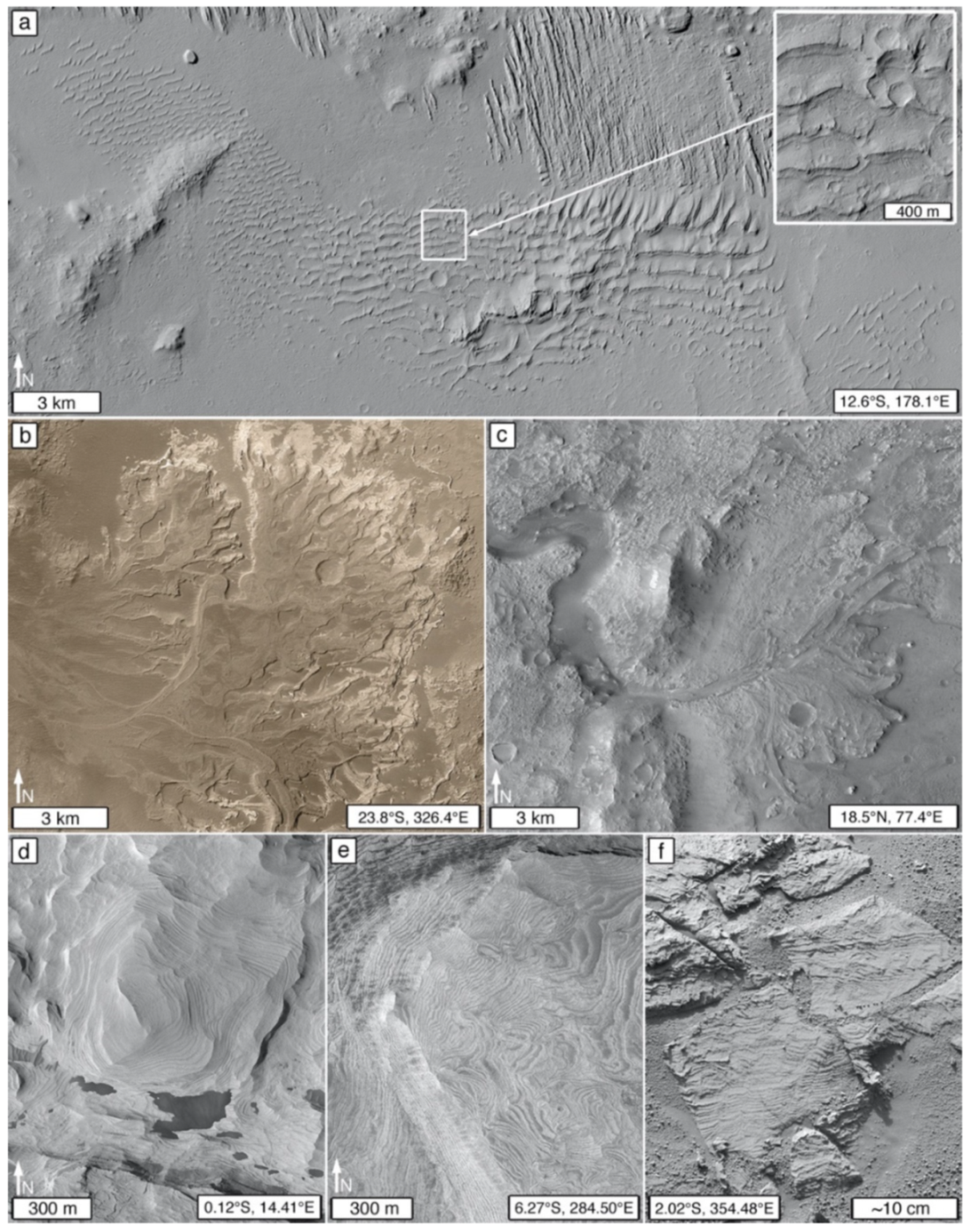




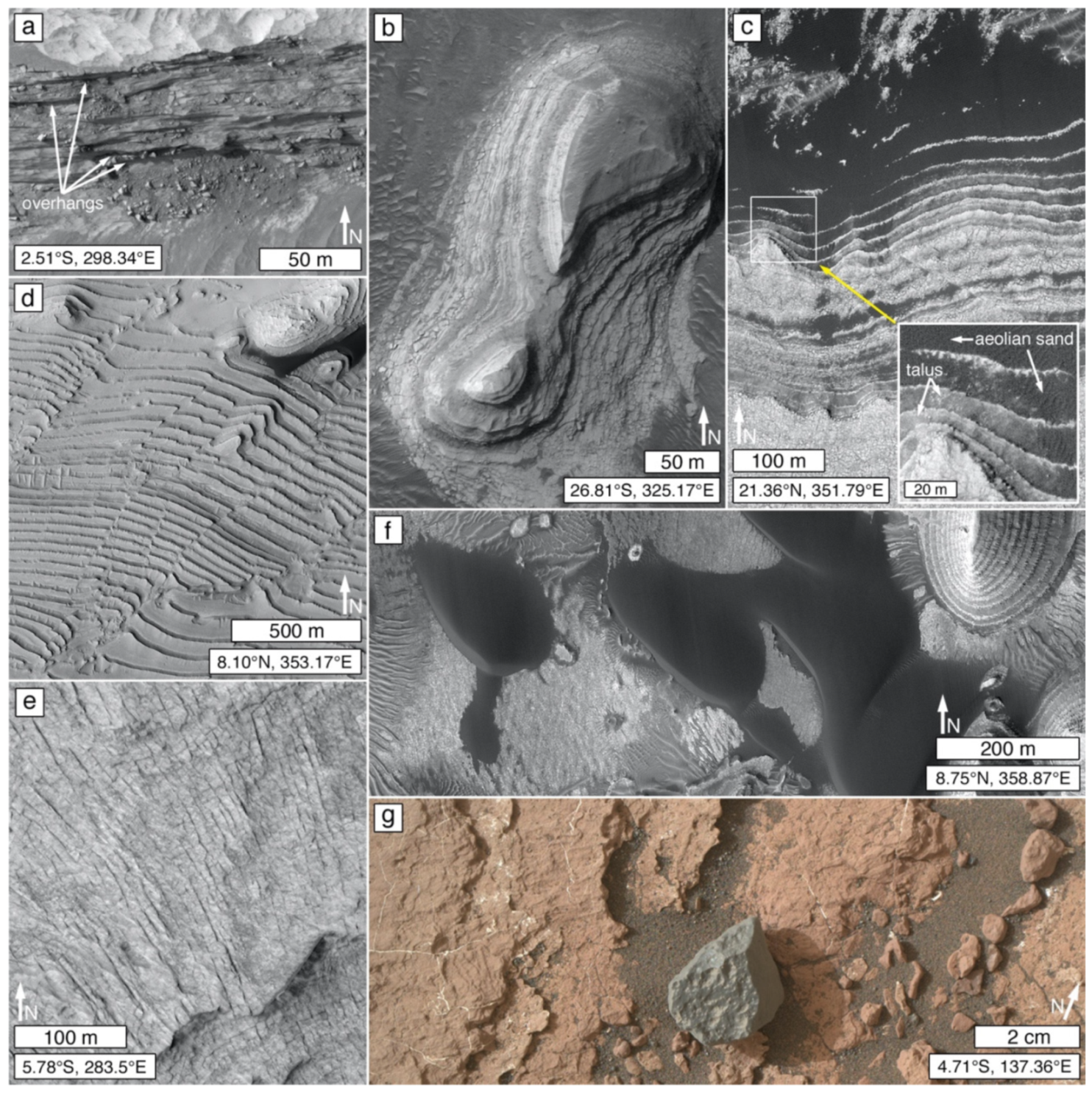
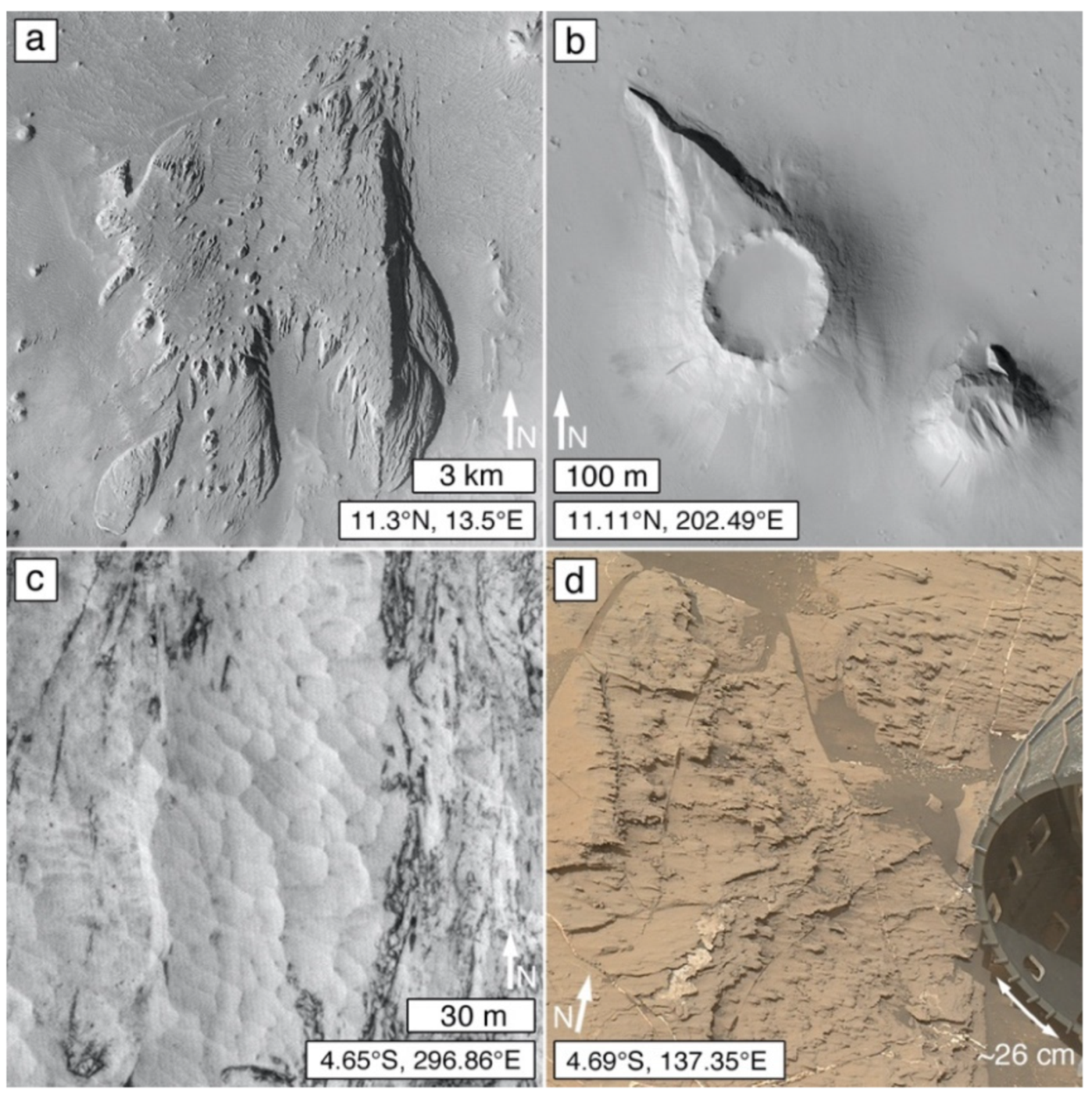

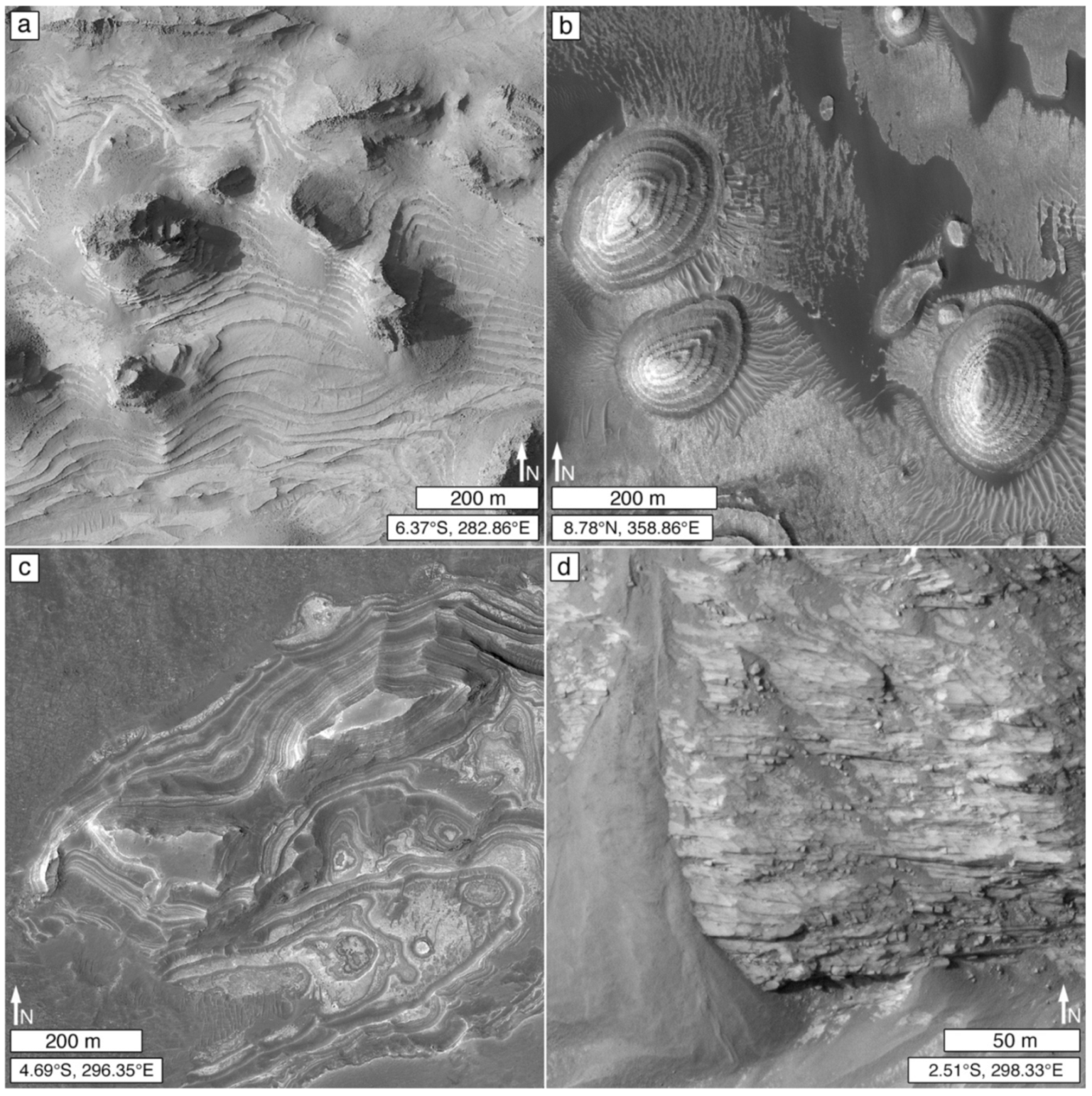
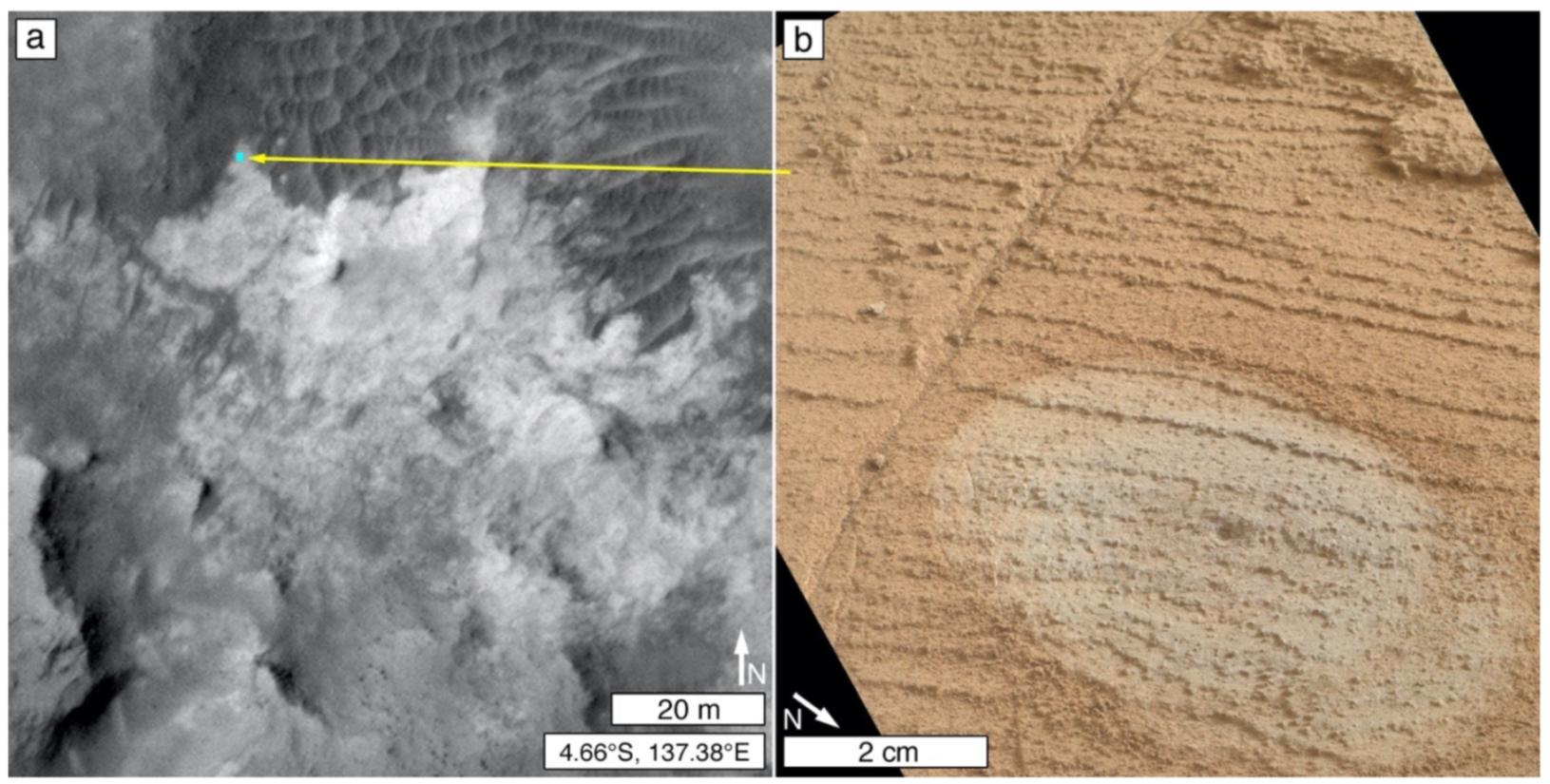
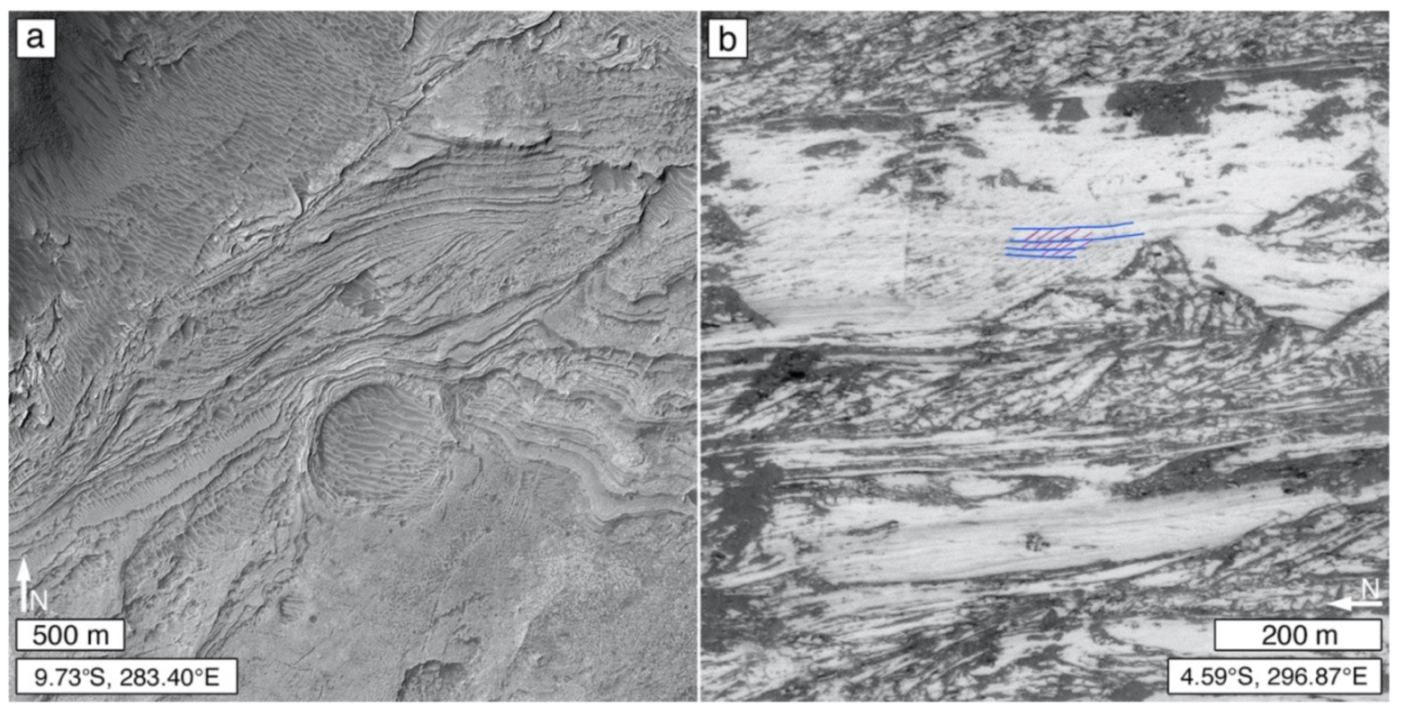

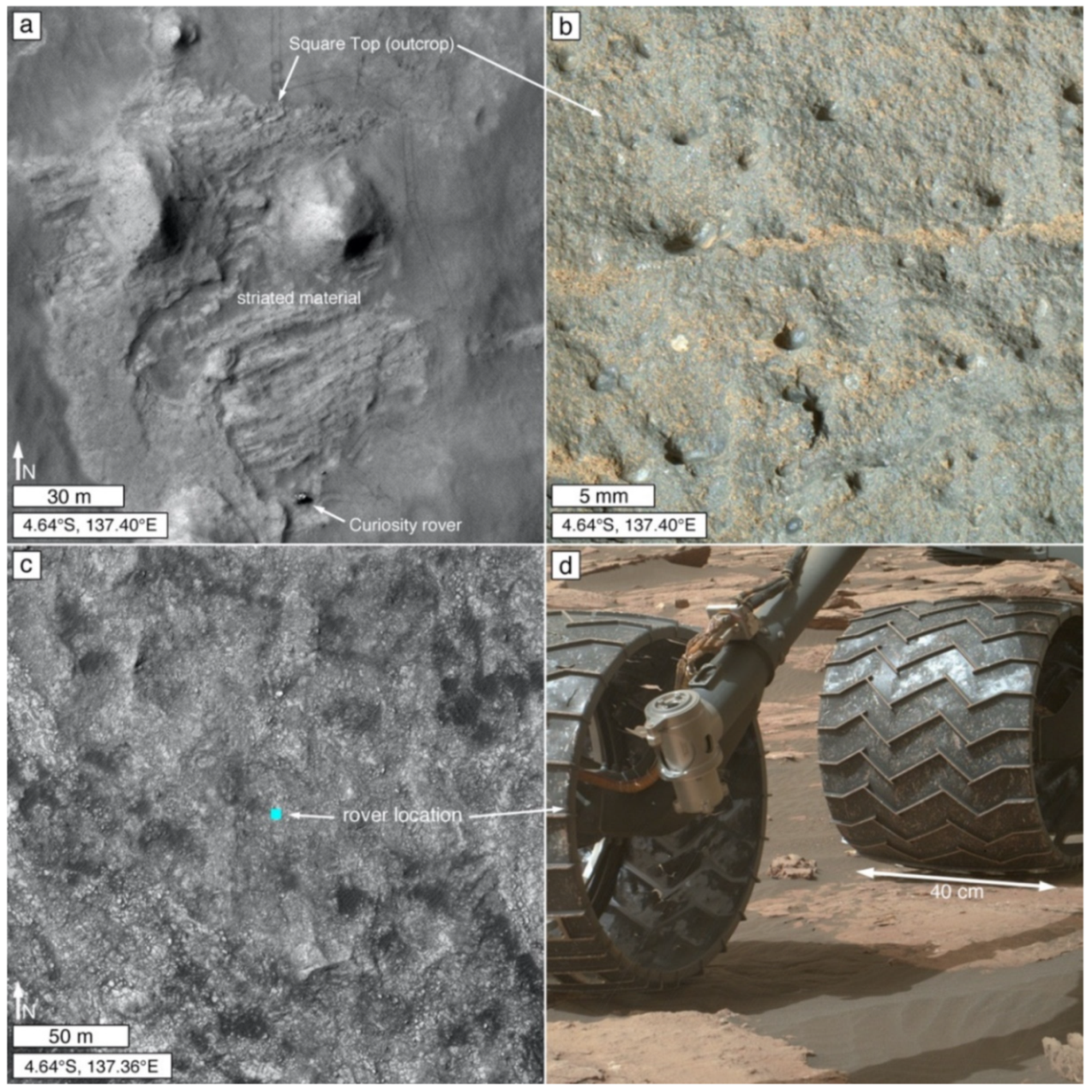
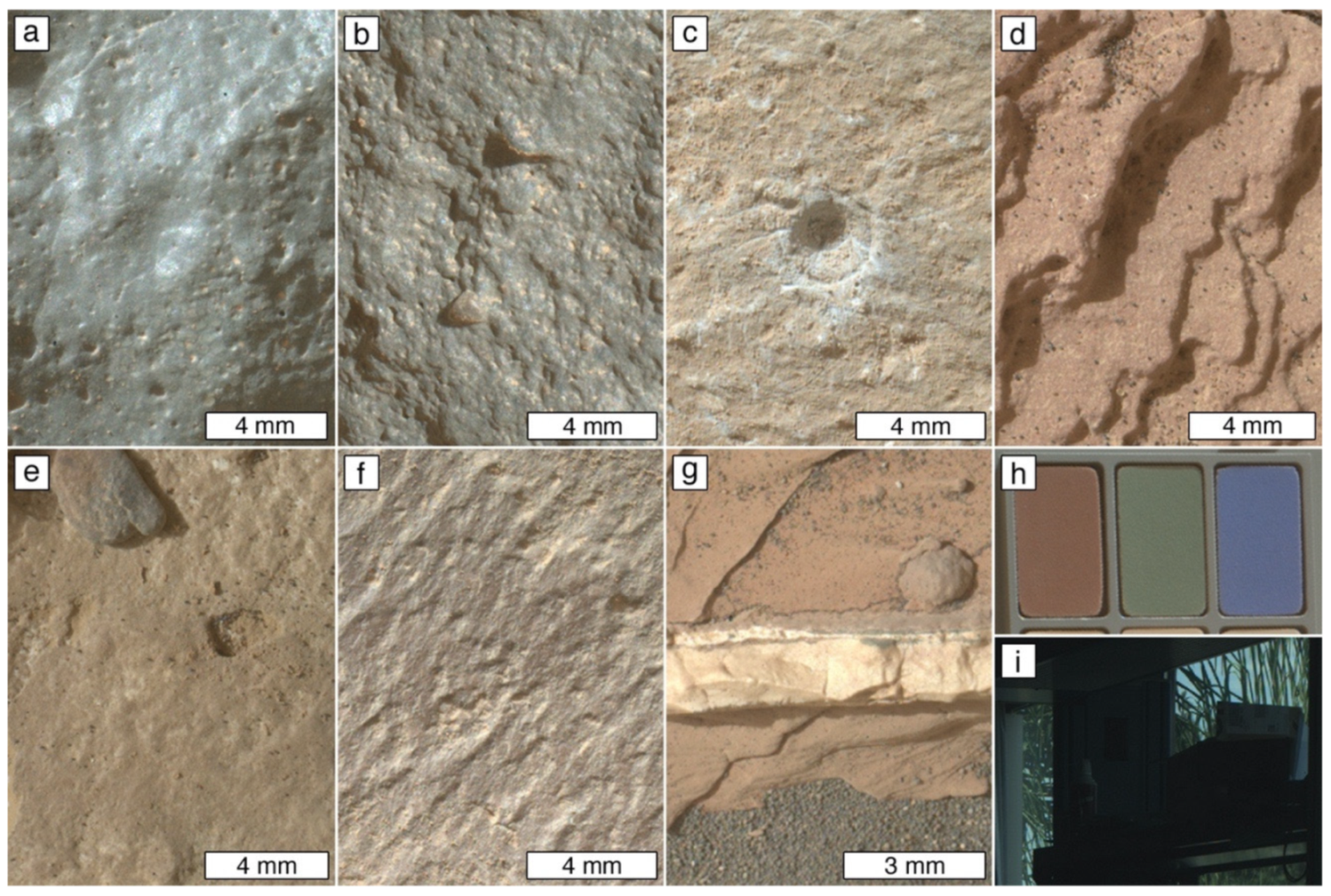



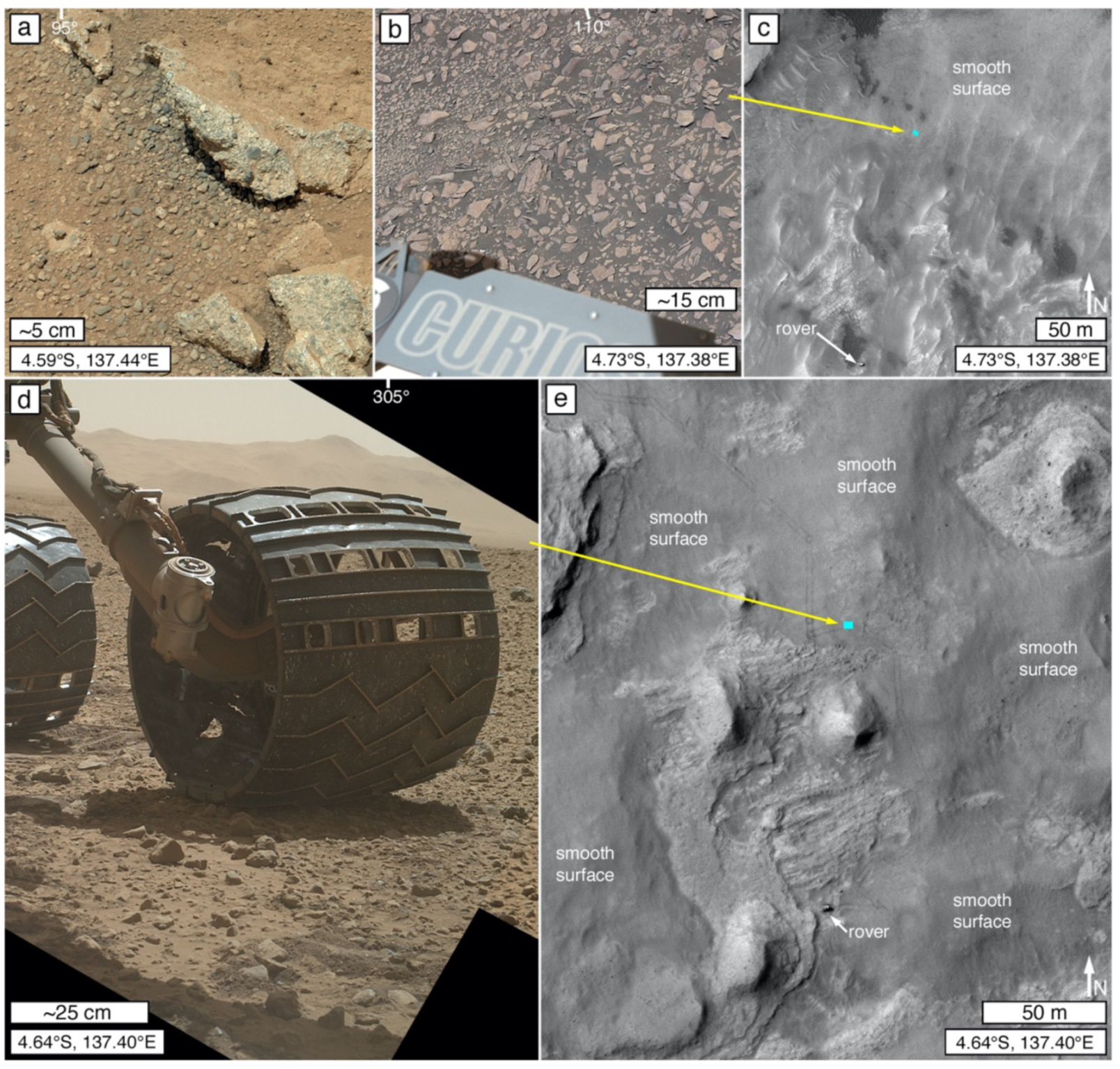
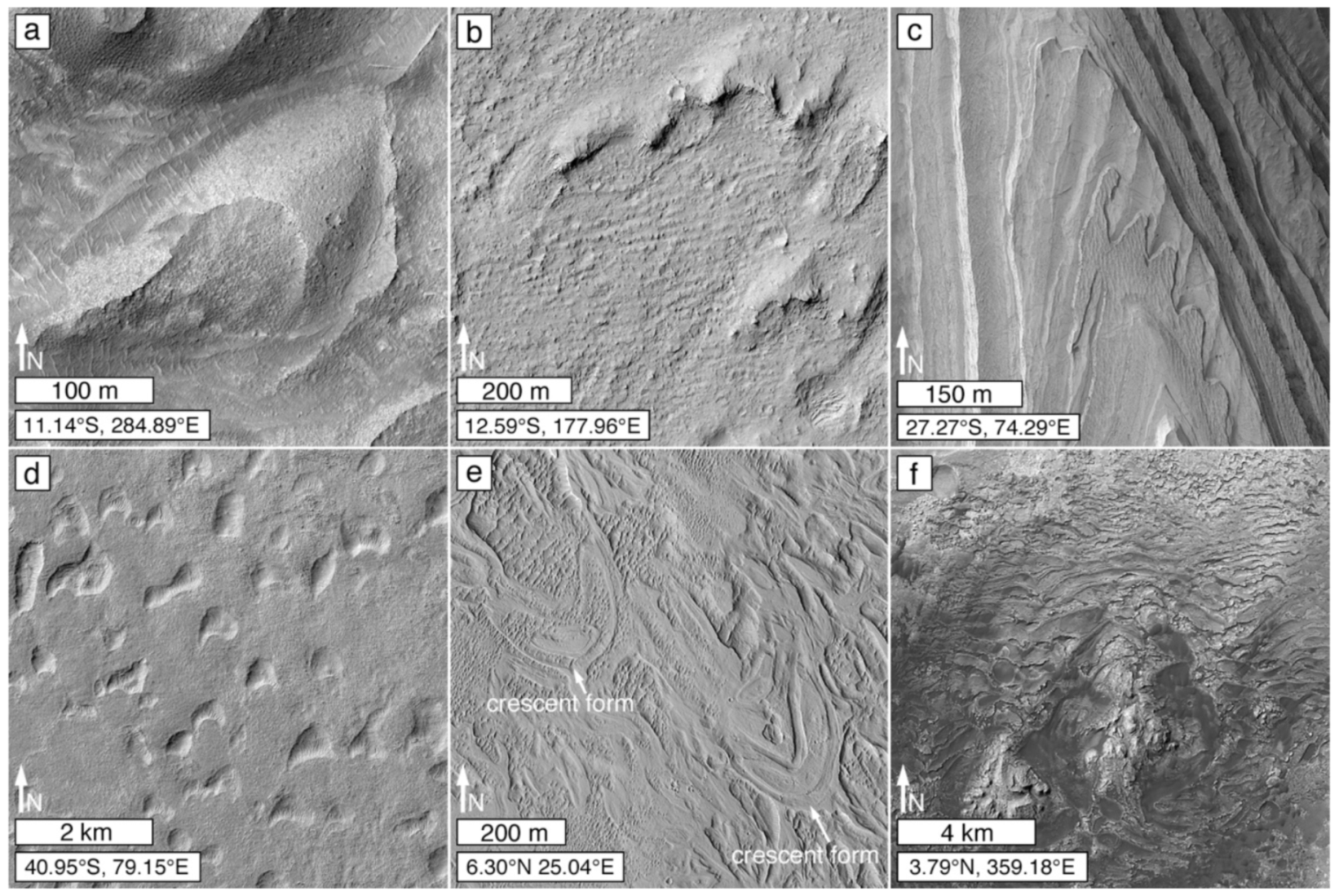
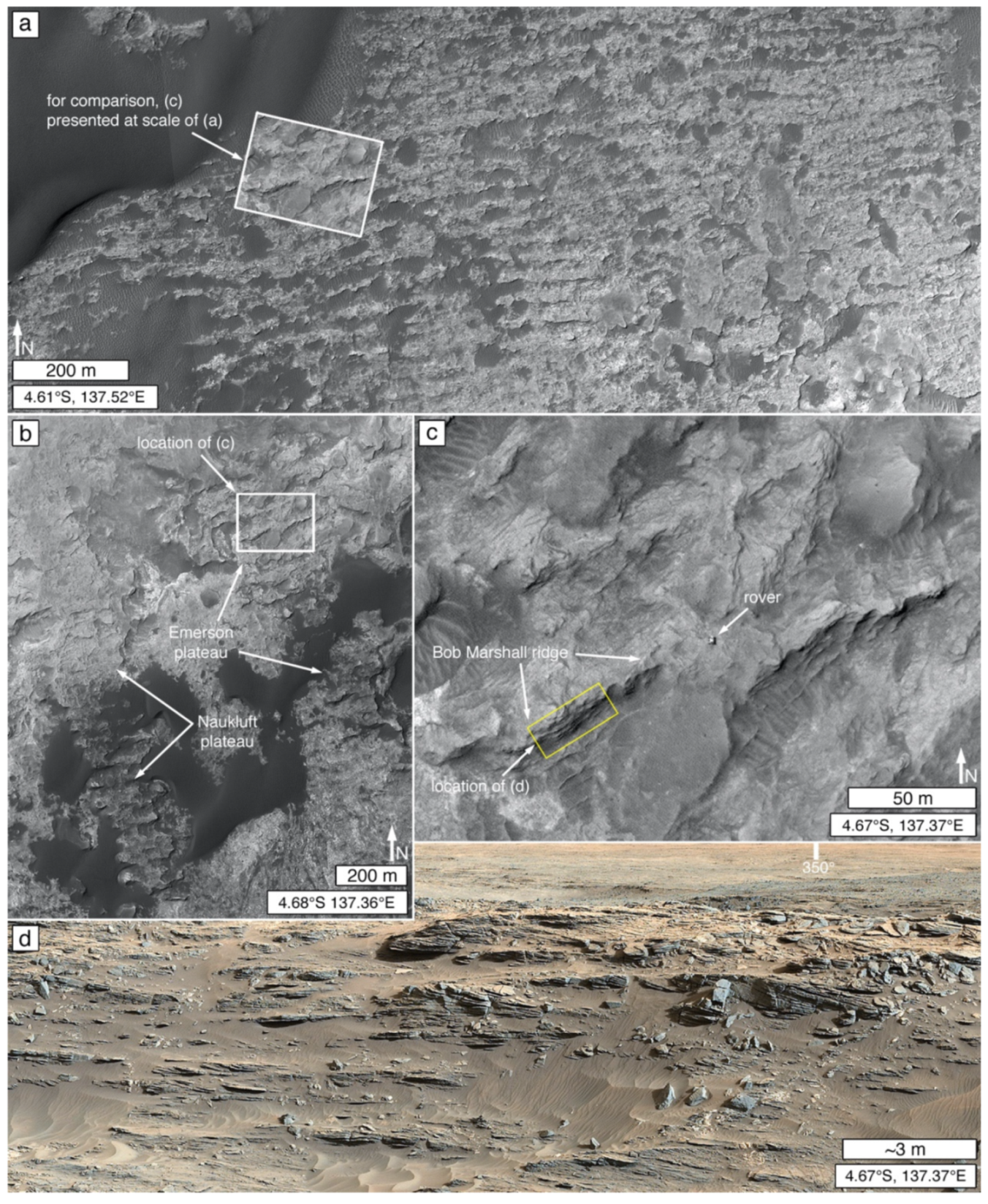
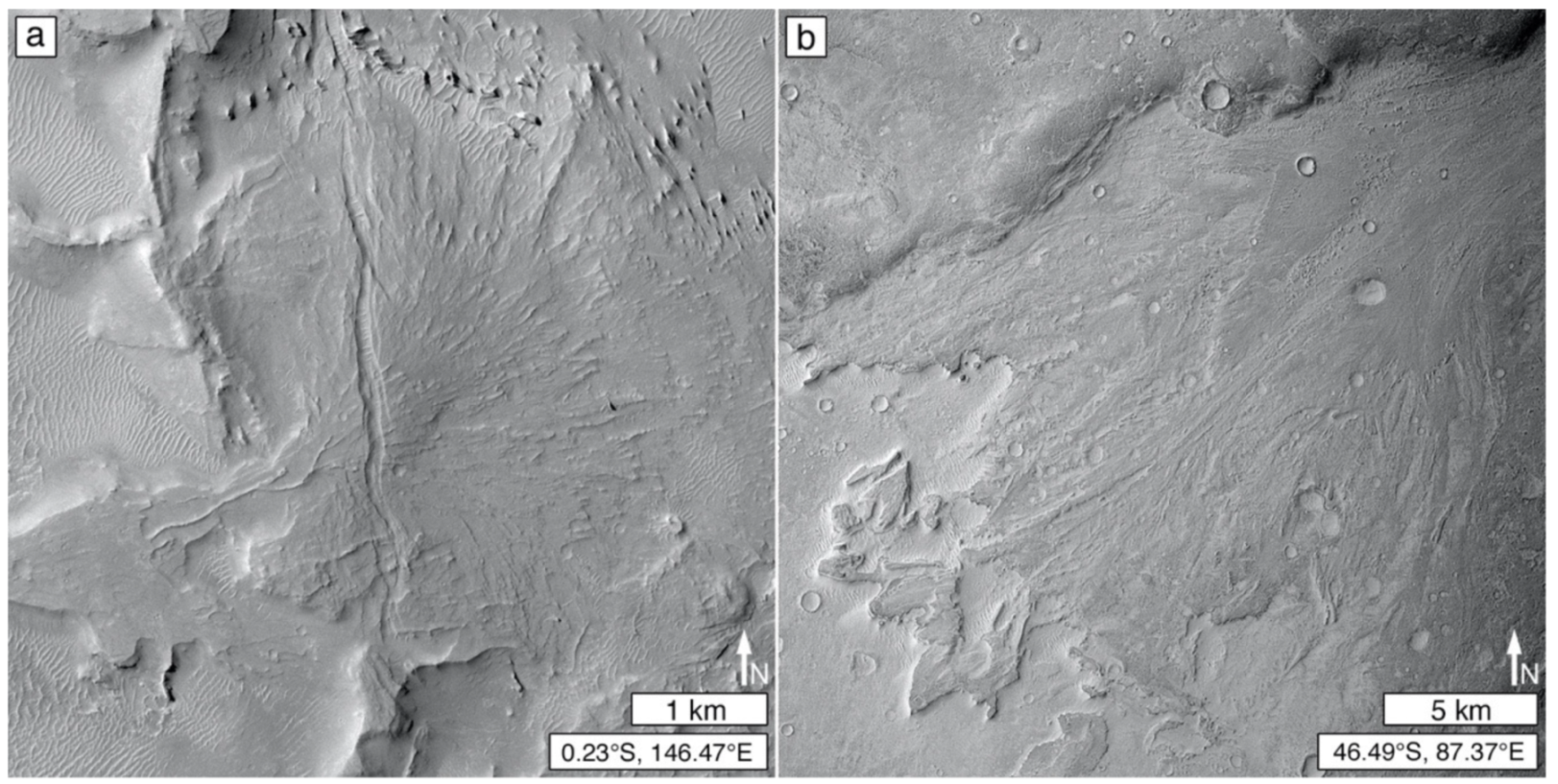


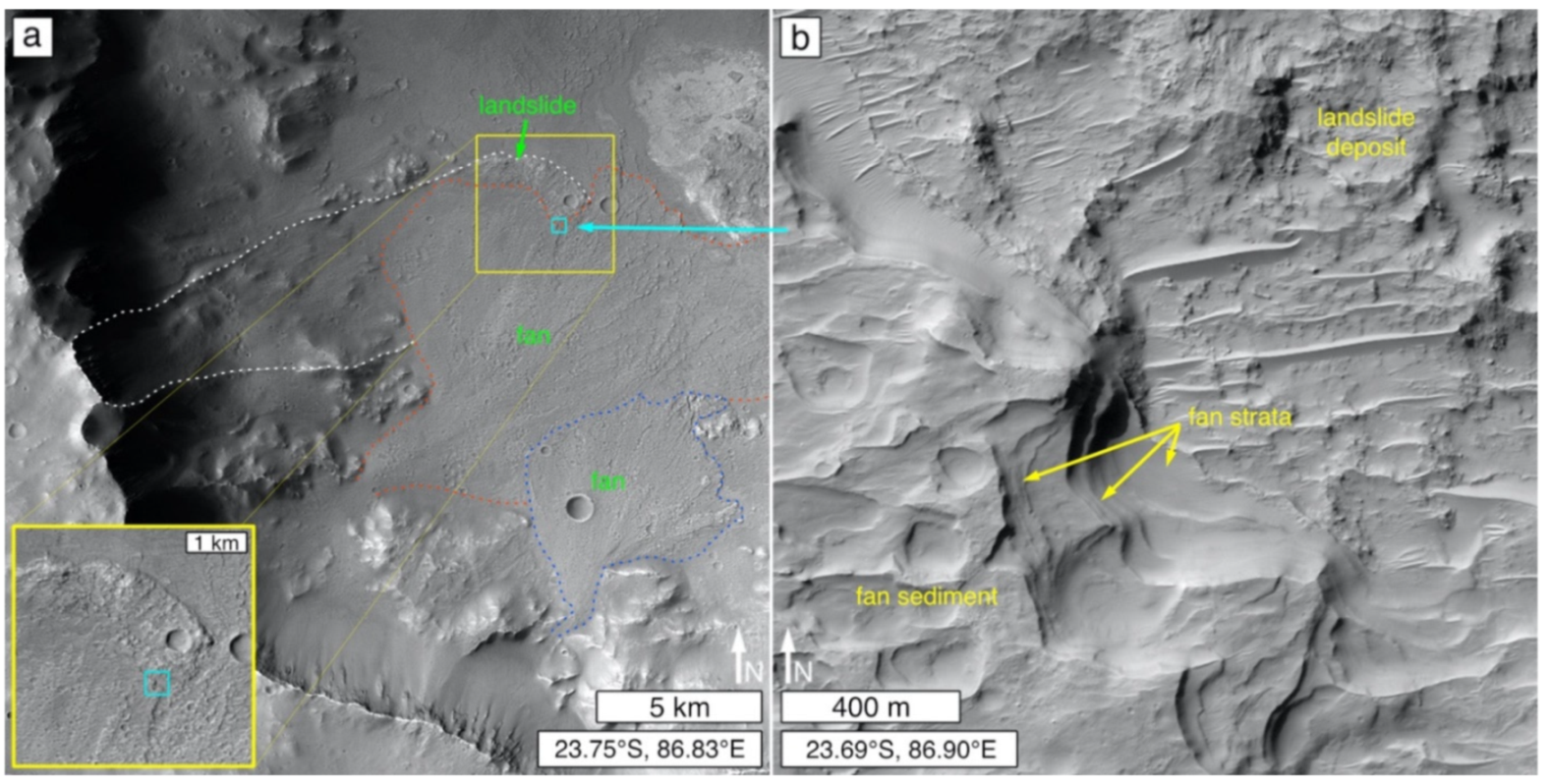

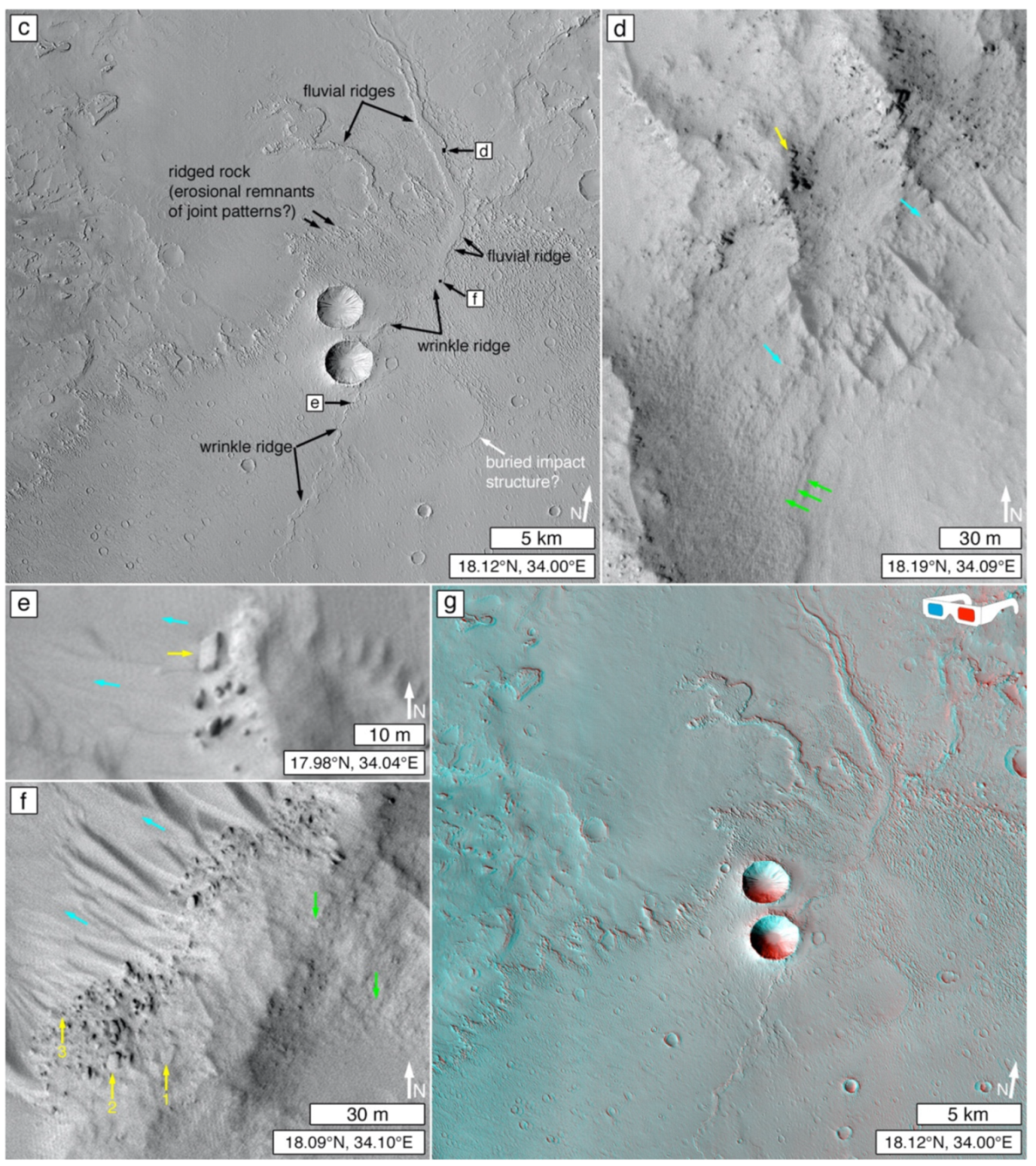
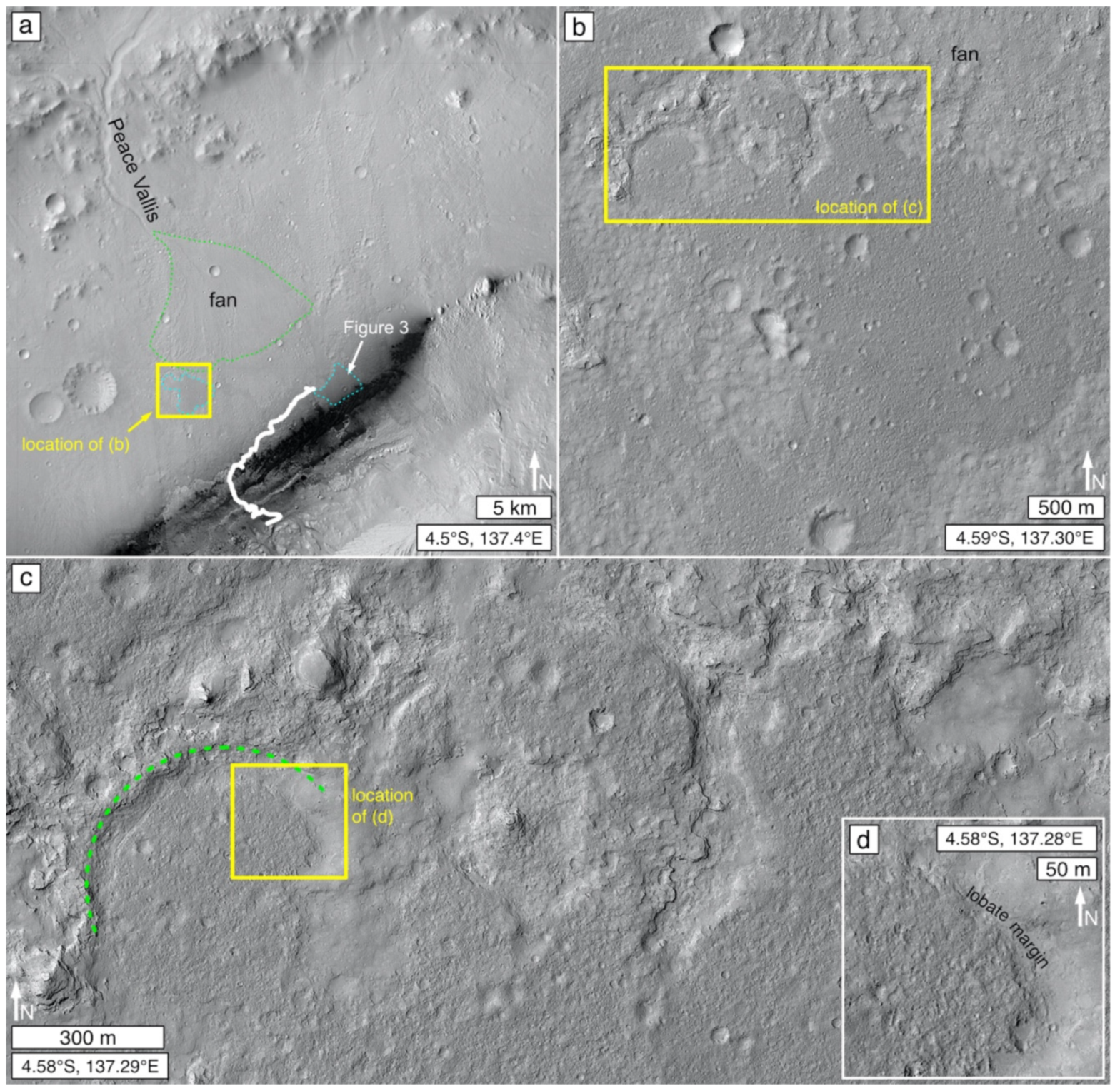

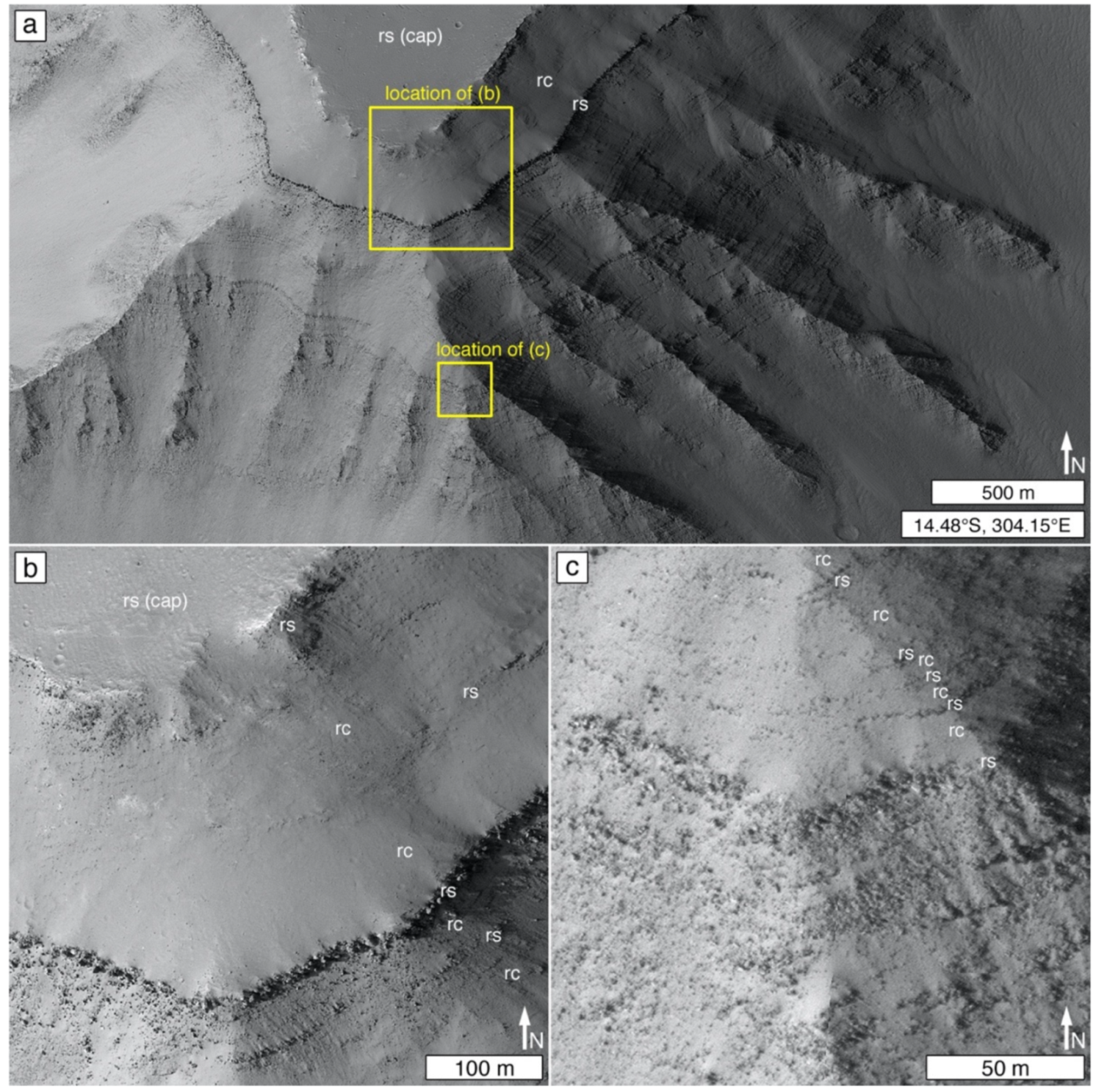
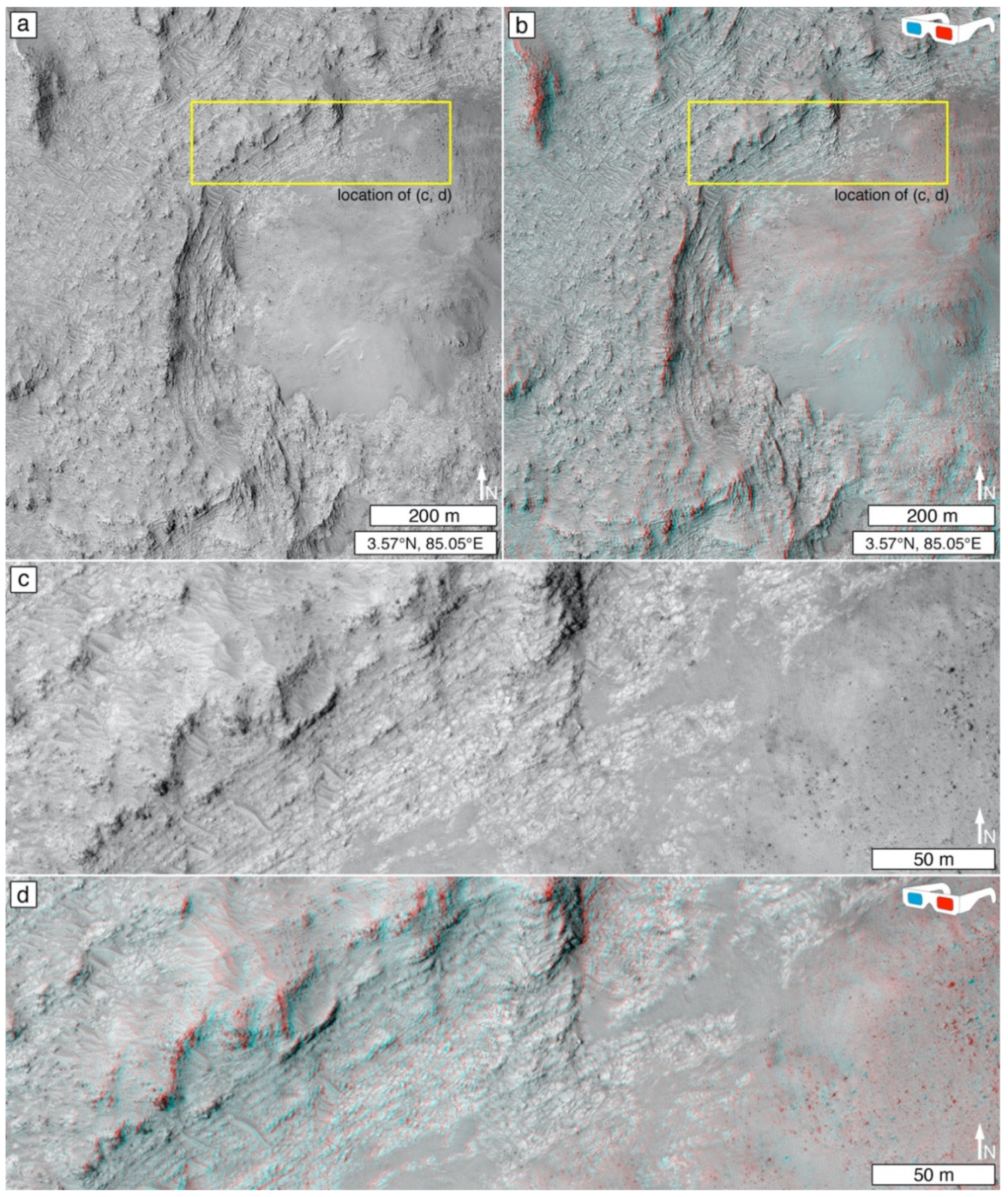
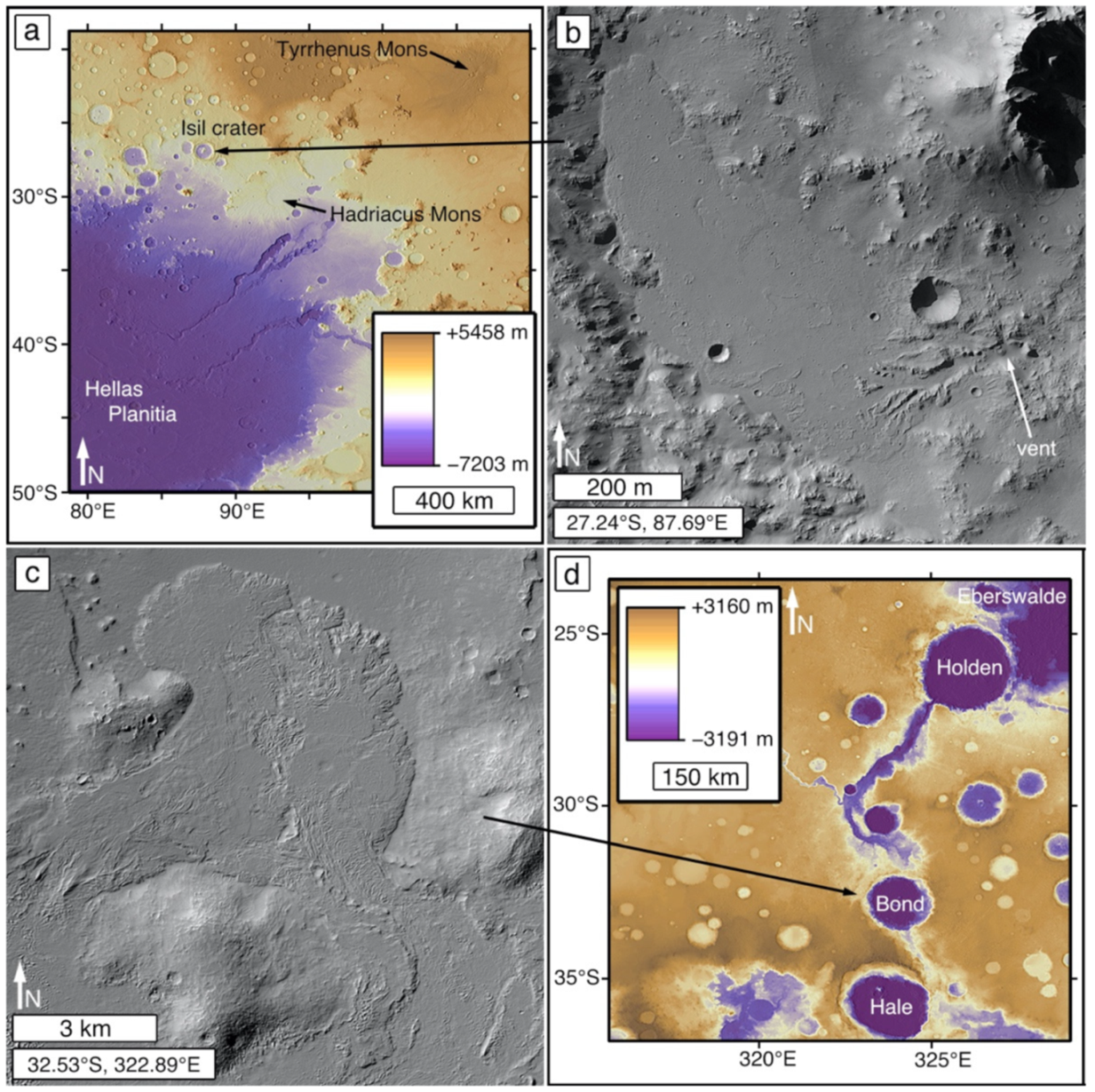


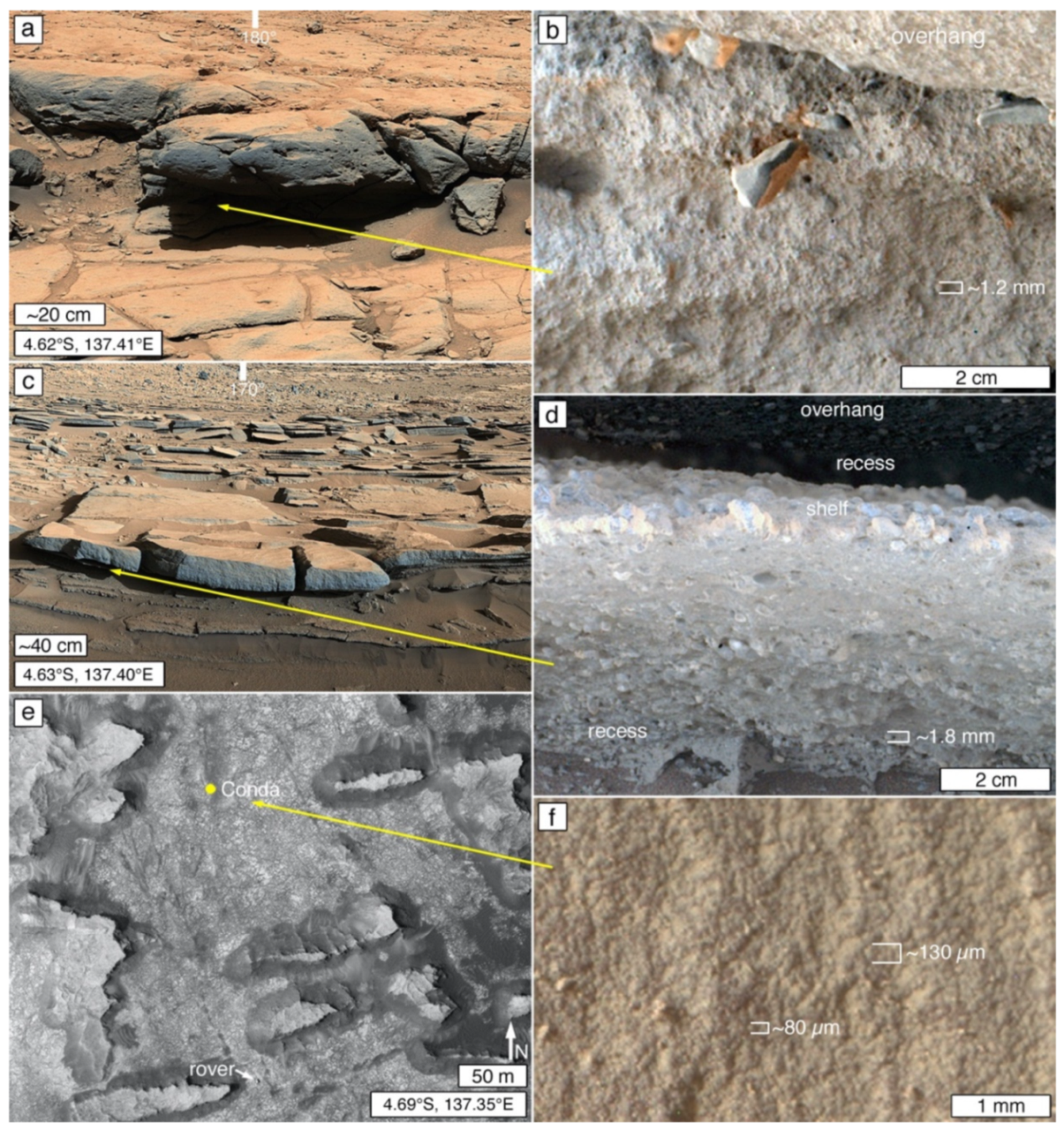
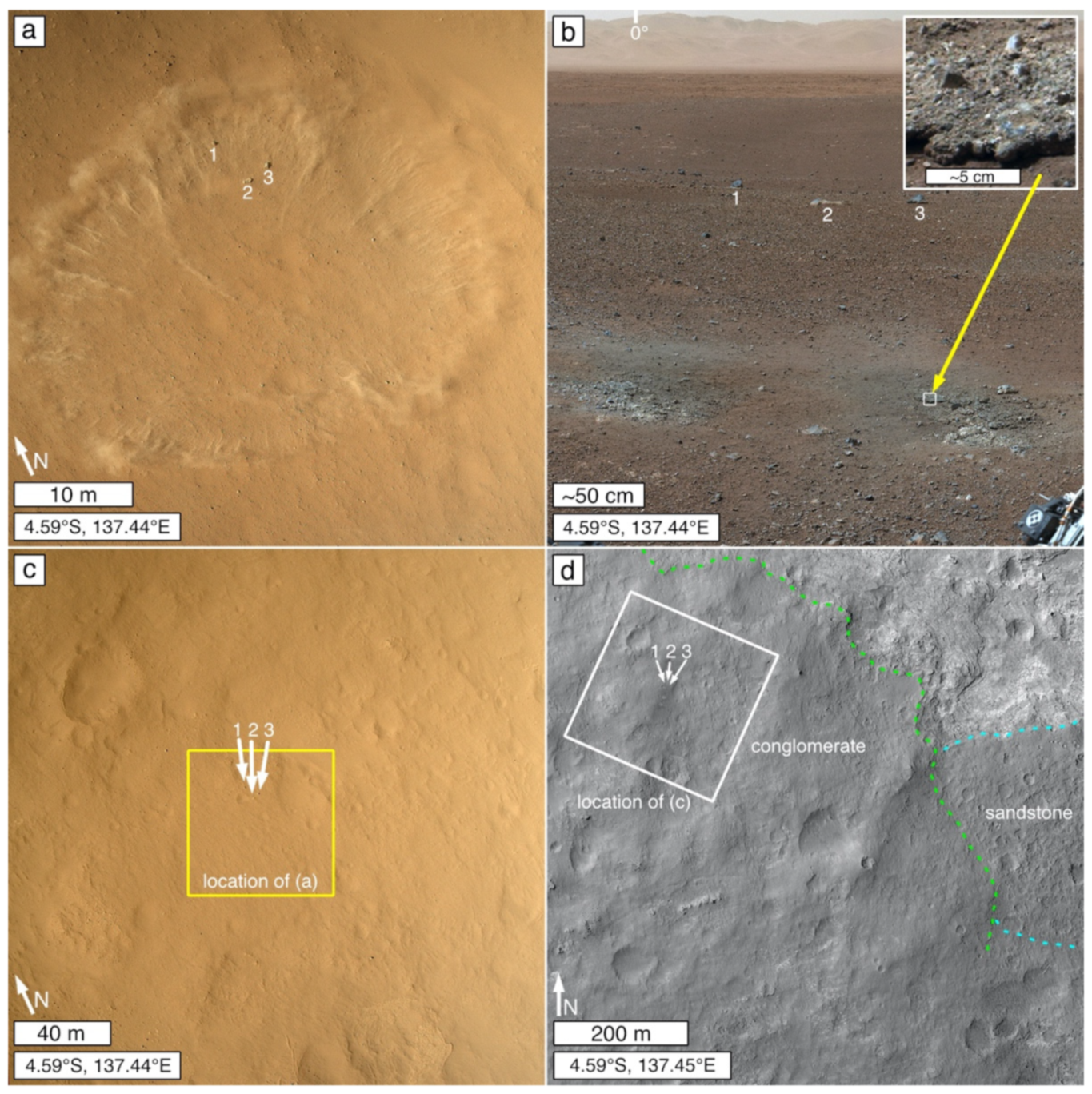

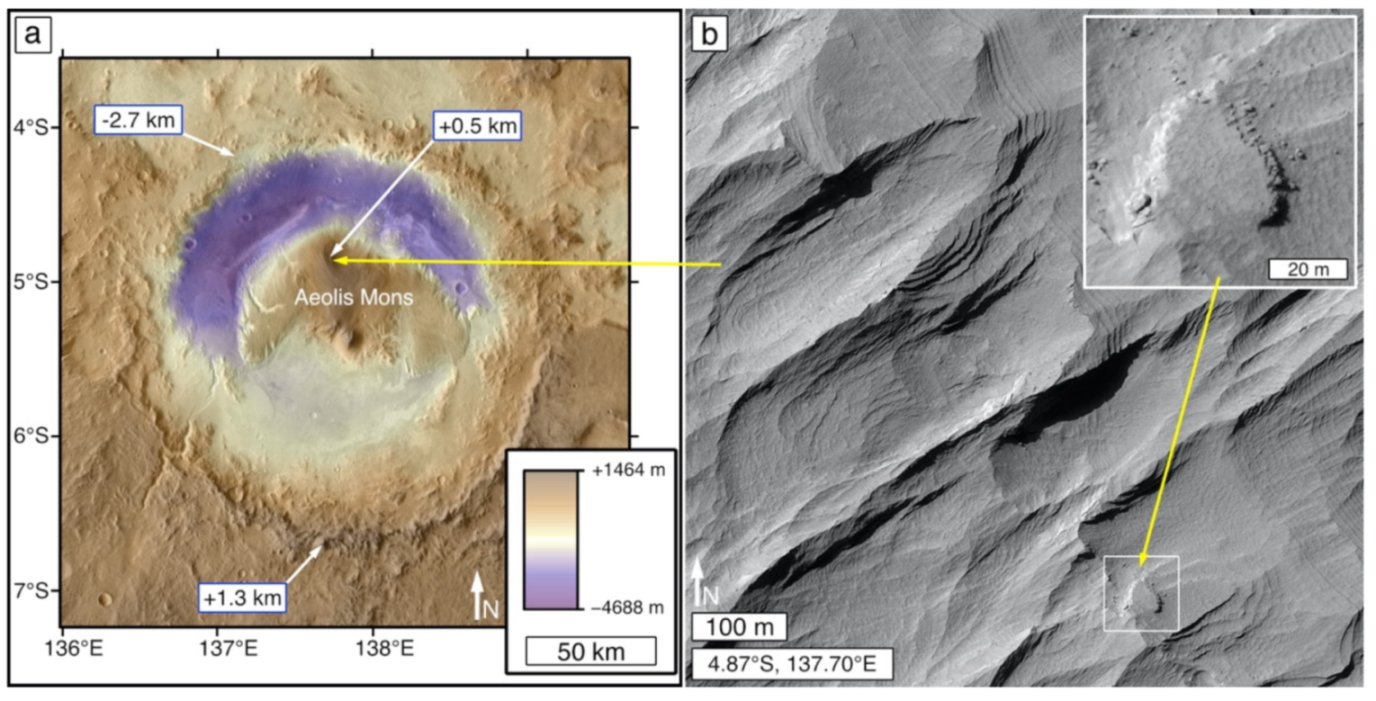
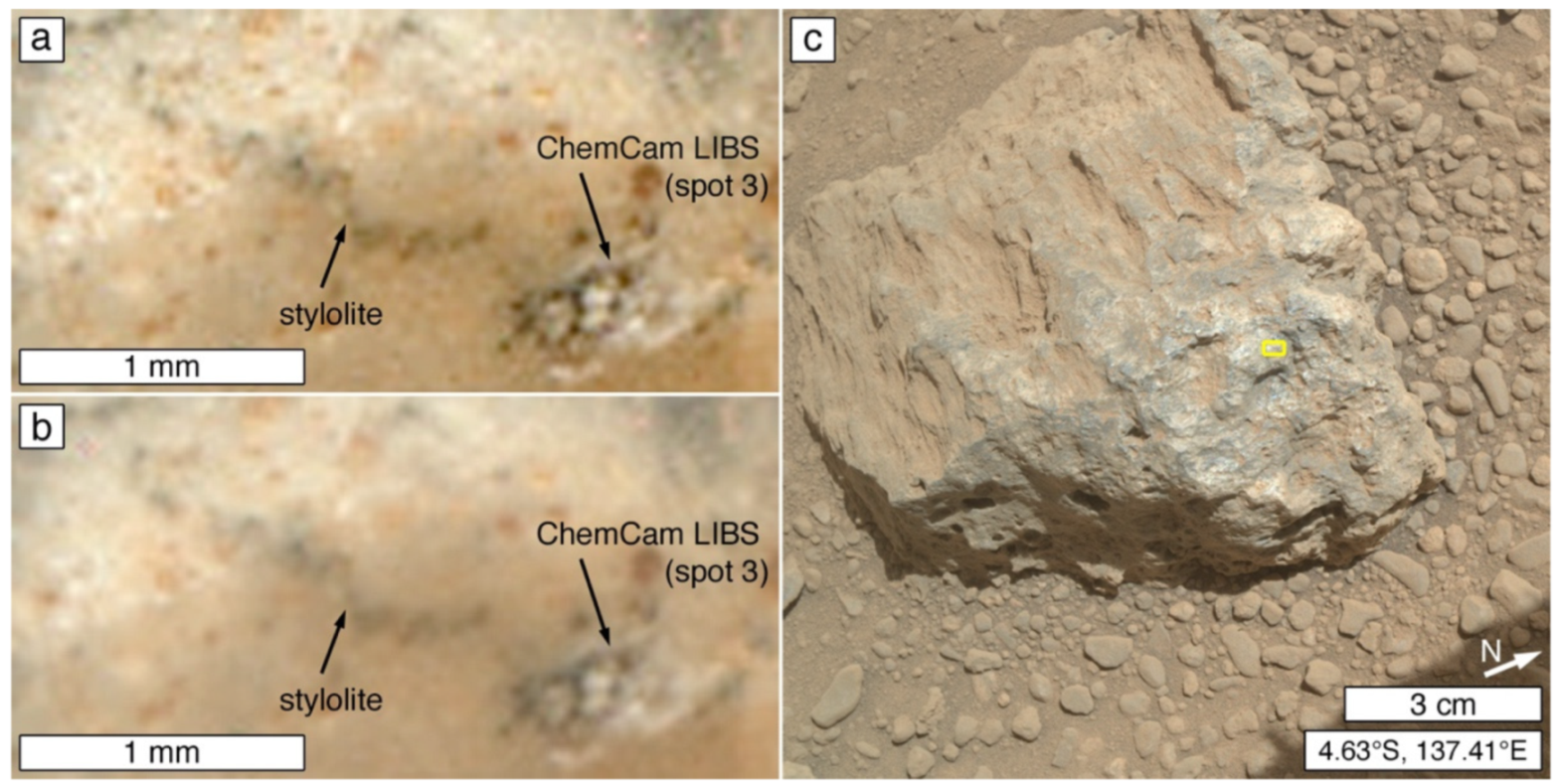

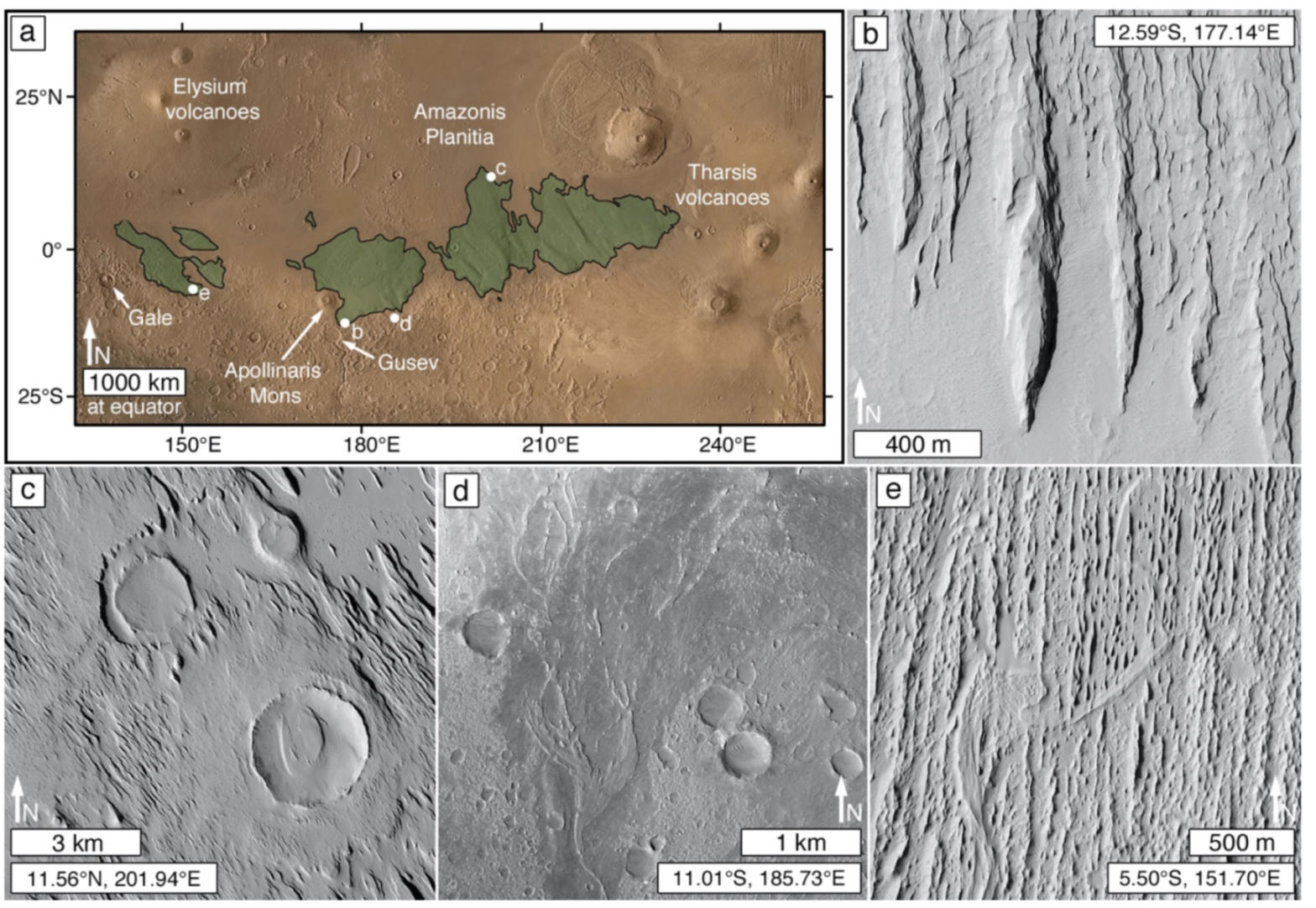
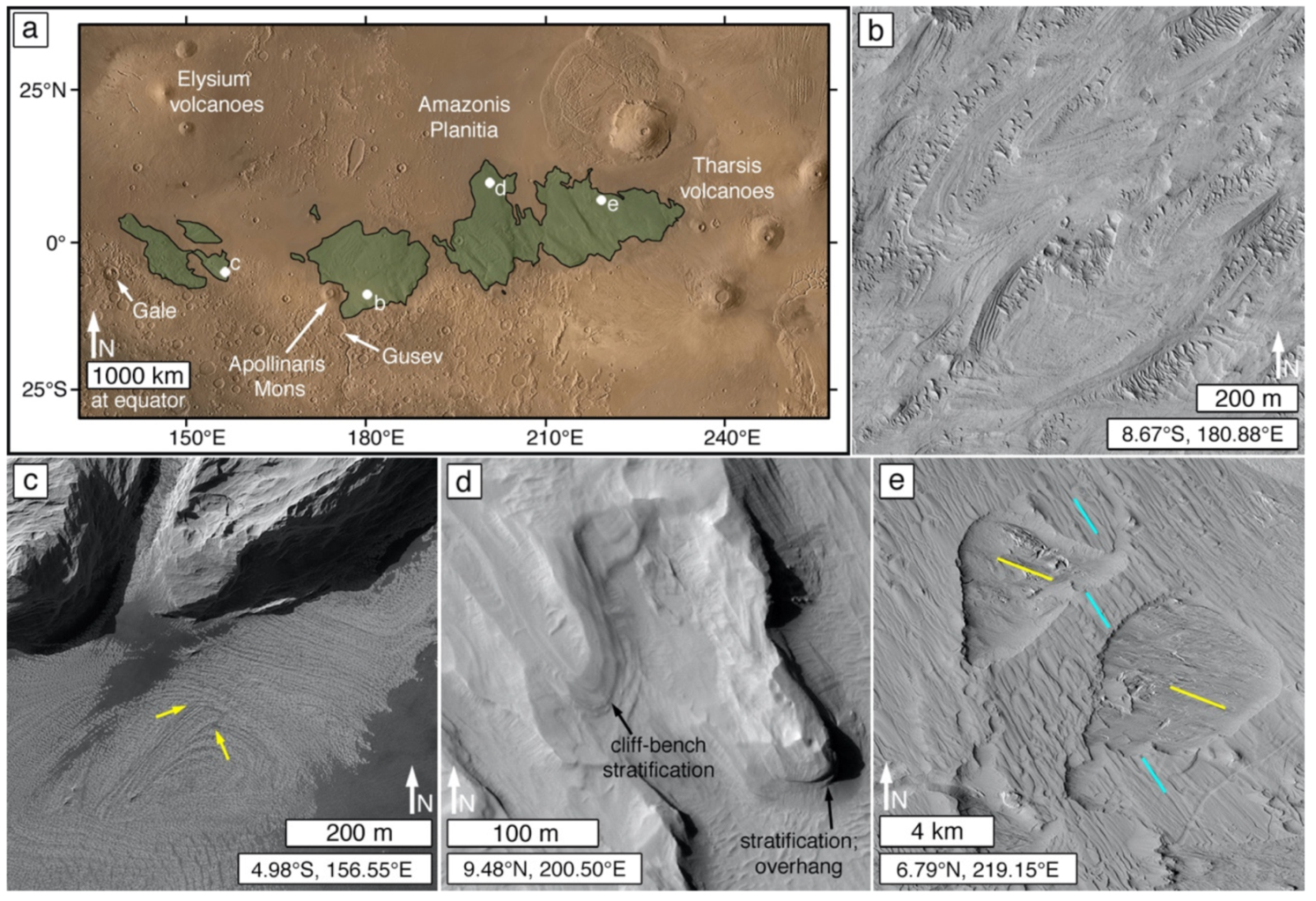

Publisher’s Note: MDPI stays neutral with regard to jurisdictional claims in published maps and institutional affiliations. |
© 2021 by the authors. Licensee MDPI, Basel, Switzerland. This article is an open access article distributed under the terms and conditions of the Creative Commons Attribution (CC BY) license (https://creativecommons.org/licenses/by/4.0/).
Share and Cite
Edgett, K.S.; Sarkar, R. Recognition of Sedimentary Rock Occurrences in Satellite and Aerial Images of Other Worlds—Insights from Mars. Remote Sens. 2021, 13, 4296. https://doi.org/10.3390/rs13214296
Edgett KS, Sarkar R. Recognition of Sedimentary Rock Occurrences in Satellite and Aerial Images of Other Worlds—Insights from Mars. Remote Sensing. 2021; 13(21):4296. https://doi.org/10.3390/rs13214296
Chicago/Turabian StyleEdgett, Kenneth S., and Ranjan Sarkar. 2021. "Recognition of Sedimentary Rock Occurrences in Satellite and Aerial Images of Other Worlds—Insights from Mars" Remote Sensing 13, no. 21: 4296. https://doi.org/10.3390/rs13214296
APA StyleEdgett, K. S., & Sarkar, R. (2021). Recognition of Sedimentary Rock Occurrences in Satellite and Aerial Images of Other Worlds—Insights from Mars. Remote Sensing, 13(21), 4296. https://doi.org/10.3390/rs13214296





